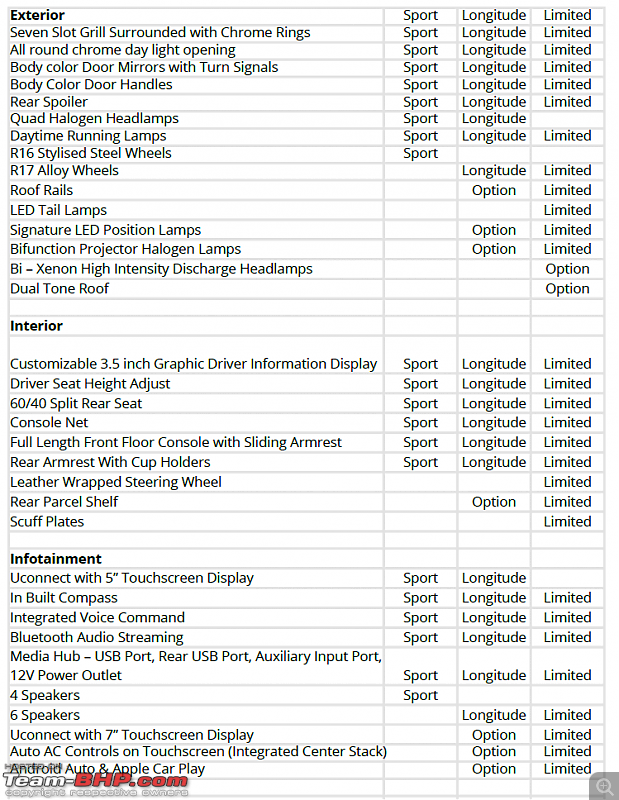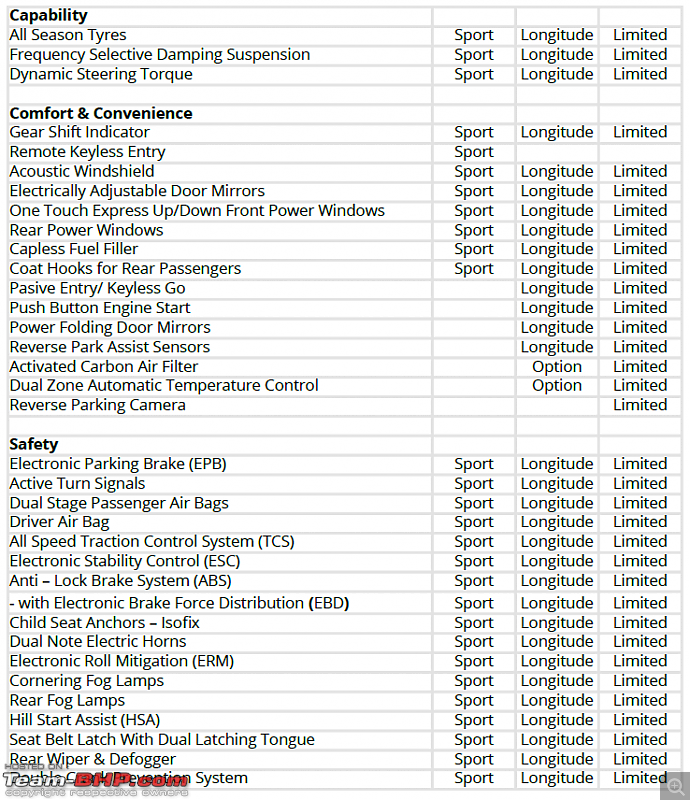| |||||||
| Search Forums |
| Advanced Search |
| Go to Page... |
 |
| Search this Thread |  5,591,691 views |
| | #1 |
| Team-BHP Support  Join Date: Apr 2016 Location: Mumbai
Posts: 2,980
Thanked: 29,620 Times
| Jeep Compass : Official Review The Jeep Compass is on sale in India at a price of between Rs. 14.95 - 20.65 lakhs (ex-Delhi). What you'll like: • Handsome Cherokee-inspired styling & loads of character • Solid build. Feels very robust, just as a Jeep should • Powerful 2.0L diesel. Good driveability in the city, fast on the open road • Mature suspension setup, nicely-tuned EPS & rock-solid stability • Capable AWD available (unlike some competitors) • City-friendly: Compact size, higher seating, smooth gearshift, soft clutch & low NVH • Topnotch safety: Strong all-disc brakes, a plethora of electronic aids & 6 airbags • We think the Compass is well-priced for what it offers. The driving experience & overall package feel premium What you won't: • Small size for the price! A sentiment echoed by most people who saw it in person • Suitable for 4 adults, not 5. Boot is small too • Inexplicably, only the AWD Diesel gets 6 airbags! All other variants have 2 • Tiny dealership network. Plus, after-sales quality & long-term reliability are unknown factors • AWD's premium is over 2 lakh rupees on-the-road. Includes 4 extra airbags, but is still too much • Diesel Automatic is still sometime away • Turning radius of 5.65m is more than the Safari Storme's. Also, 17º approach angle is too low • Missing goodies (blanks on the steering, auto-dimming IRVM, auto wipers & headlamps, lumbar adjustment, reclinable rear seats) The Petrol AT: • Link to Review Last edited by GTO : 11th June 2018 at 11:03. Reason: Small boot |
| |  (172)
Thanks (172)
Thanks
|
| The following 172 BHPians Thank Omkar for this useful post: | --gKrish--, aadya, Abhi_abarth, ads11, aeroamit, Aficionados, akbaree, Alfresco, ampere, amrutmhatre90, aniket17, anjan_c2007, anoopGTkrish, arit.mondal, artemis_fowl, arun_josie, Ashir, asingh1977, atulsian, AutoIndian, avinash_clt, Behemoth, BigBrad, BlackPearl, blackwasp, CarguyNish, carrazy, CEF_Beasts, clementj, CLIX, crackparag, CrAzY dRiVeR, dailydriver, damager21, daretodream, darklord, deetjohn, doxinboy, Dr.AD, drkritik, dZired, Flyer, frankmehta, Gaboonviper04, GKMahajan, Godzilla, gpa, Grand Drive, GTO, HappyRoadie, hdman, hemanth.anand, hs_maverick, HumbleBee, igp_79, iliketurtles, InControl, jaganpec2002, Jaggu, Jakku, karthikkr, karuvally, kashyapz8055, kiren, KK_HakunaMatata, Klub Class, Kols, lancer_rit, Leoshashi, libranof1987, lipaul, lovetorque, lrsays, lurker, mantrig, mayank0782, mbz180, MDED, mi2n, MidnightBlack, mjumrani, Moto_Hill, MSAneesh, Myth_sx, Nagesh Bhatt, naveen.raju, navsjab, neoonwheels, Nicky, noopster, NPV, Oreen, pankaj_sachdeva, paragsachania, petrolhead_neel, PGA, PGNarain, phoenixash, phynix123, planet_rocker, Ponbaarathi, procrj, R2D2, ragh_bhushan, RAHS, Rajeevraj, RakishRam, RavenAvi, redracham, regenitin, Rehaan, rejeen, riturajsharma19, ritzy, RoadSurfer, rohansachar, rshanker, Rshreyansh, S.MJet, sahibrain, samabhi, samaspire, Samba, Samurai, sandeepmohan, sanstorm, sayakc, SchumiFan, scopriobharath, sdp1975, sharanvenu, shipnil, Simat, Simhi, Sip, SmartCat, SnS_12, Solo, sooraj.naik, SourabhSuresh, sparky@home, spdfreak, speed kills, sri2012, SS-Traveller, suhaas307, sunny29584, Suraj, swiftnfurious, Technocrat, The Rationalist, theexperthand, theredliner, timuseravan, Tormoz, uday.ere, valapad, vb-saan, vibbs, Vid6639, vidyanand, Viju, Vik0728, vinodvayyat, vishy76, vivek95, vredesbyrd, vsrivatsa, Wildy, wordsworth, X_T_A Rose, yosbert |
| |
| | #2 |
| Team-BHP Support  Join Date: Apr 2016 Location: Mumbai
Posts: 2,980
Thanked: 29,620 Times
| Review Index: Exterior Last edited by GTO : 27th August 2017 at 13:30. |
| |  (45)
Thanks (45)
Thanks
|
| The following 45 BHPians Thank Omkar for this useful post: | aadya, aniket17, anjan_c2007, arun_josie, avinash_clt, blackwasp, CAPTAIN REX, CarguyNish, CrAzY dRiVeR, Dr.AD, dZired, frankmehta, GKMahajan, GTO, igp_79, Jaggu, kiren, MDED, Myth_sx, NPV, paragsachania, phoenixash, R2D2, RaghuVis, ragh_bhushan, RavenAvi, ritzy, rohansachar, roy_libran, rshanker, SchumiFan, sharanvenu, SnS_12, sooraj.naik, suhaas307, Technocrat, theexperthand, theredliner, TSIboy, uday.ere, Vid6639, Viju, Wildy, wordsworth, X_T_A Rose |
| | #3 |
| Team-BHP Support  Join Date: Apr 2016 Location: Mumbai
Posts: 2,980
Thanked: 29,620 Times
| Exterior 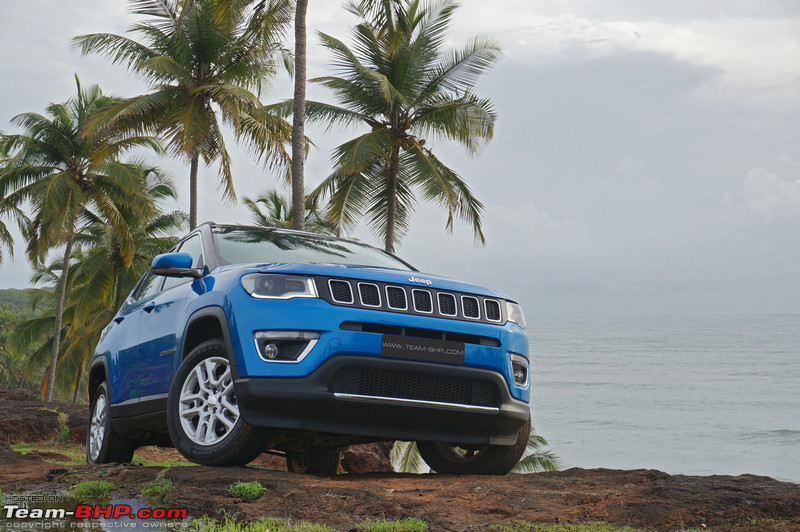 The Jeep brand made its entry in the country last year with the introduction of the Grand Cherokee and Wrangler Unlimited. Jeep India's positioning of these cars was awful - the CBUs were grossly overpriced and thus, they found it impossible to move off showroom floors. All that is yesteryear though. Jeep India has now come up with a relevant product at a realistic price with the Compass. What's more, if you look at the bigger picture, the obscene pricing of the CBU cars did serve one purpose - 'Jeep' was established as a premium / expensive brand. This surely has helped the Compass as it's easy to go downstream on the price chart, but rather difficult to swim upstream. Brand 'Jeep' recently celebrated 75 years of existence. The brand currently comes under the wings of Fiat Chrysler Automobiles (FCA) which is incorporated in Netherlands, with headquarters in London. The Compass is manufactured at the Ranjangaon plant near Pune, which is a facility jointly owned by Tata Motors & Fiat India. The factory has been designed to cater to the needs of RHD markets like Japan, South Africa and United Kingdom too. In fact, it is the only one (among three other facilities) in the world building the RHD Compass. Jeep India has invested over Rs. 1800 crore in the Compass project & it starts off with a 65% localisation level. The company claims that this SUV is a 1 mm vehicle as they have kept the tolerance levels during quality checks as low as 1 mm. The American brand has introduced some new hi-tech processes which were showcased during the unveiling of the pre-production model (detailed report here). Honestly, after a look at the car, it's hard to believe the Compass is from the same Ranjangaon factory that rolls out the Linea and Punto. The quality is good, whereas the Linea & Punto had many rough edges (example). I feel the name 'Compass' is perfect for a Jeep. Coming to the history of the moniker, the 1st generation was introduced for the 2007 model year. It shared its platform with the Jeep Patriot and Dodge Caliber. The 1st-gen was based on a GS platform which was co-developed by Mitsubishi Motors and DaimlerChrysler. The 2nd-generation Compass (which we have gotten) was first unveiled in September 2016 in Brazil. Its platform (which also underpins the Jeep Renegade) is basically a stretched version of the Fiat 500X platform. The SCCS (Small Common Components and Systems) platform was developed by Opel & Fiat and underpins a wide range of Fiat cars as it is adaptable for different wheelbases and drive configurations. This makes the Compass more of a Fiat than a Jeep  . But well, we'll leave that discussion for another day as it's inevitable in the current times. Is a Rolls-Royce a Rolls-Royce or a BMW? Were the earlier Jaguars actually Jaguars or Fords? . But well, we'll leave that discussion for another day as it's inevitable in the current times. Is a Rolls-Royce a Rolls-Royce or a BMW? Were the earlier Jaguars actually Jaguars or Fords? The car sure has managed to build the necessary hype in the country. Wherever we went, there were interested onlookers. In fact, people who would have never considered a Fiat ever in their life have been calling us and enquiring about the Compass. Jeep claims to have received over 8,000 confirmed bookings for this SUV. Good news for the company, although the sales and service aspect - which has been Fiat India's Achilles heel - raises a big question mark. Jeep products aren't know for their reliability either, so we'll depend on ownership reports to gauge long-term durability. Currently, only 50 dealerships along with 48-FCA authorised workshops are present across India. That's a tiny number when you consider the networks of its direct competitors. 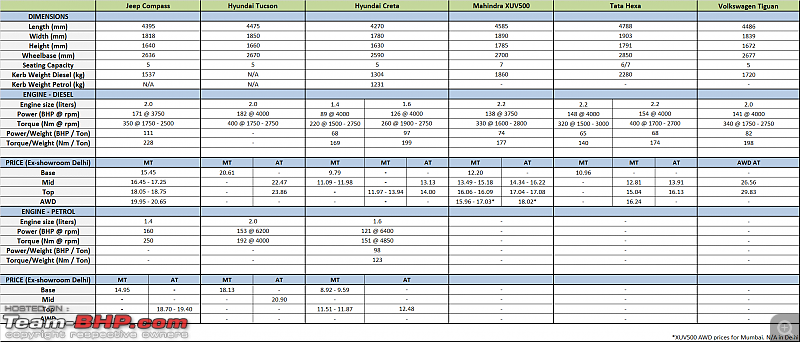 The Compass will be available with a 2.0L diesel and 1.4L turbo-petrol, and both will get manual or automatic gearboxes. An optional AWD variant will be offered only on the diesel. At the moment though, the company has only introduced the diesel with a 6-speed MT. Deliveries of the Petrol AT (7-speed dual clutch) will begin closer to this year's festive season (Diwali), while the Petrol MT will start after that. There has been no confirmation as to when the Diesel AT (maybe the 9-speed?) will be introduced. Rumour mills say it'll come in Q1 of 2018. Prior to the launch, the pricing of the Compass was a prime topic of discussion among BHPians. Here's a MUST-READ witty summary of that (related post). The Compass has been priced a lot higher than the Creta, which is a pricey SUV to begin with. Still, we think the Compass is worth the price. The larger Tucson and Tiguan are of course priced well above the Compass, making the Jeep sit somewhere in between. At this pricing though, some missing goodies bother us - cruise control, auto dimming IRVM (seriously, Jeep??!!), auto headlamps, auto wipers etc. are all shocking omissions. This is especially the case when you consider that Fiat's cheaper product - the Linea - offers them! Other bits like a sunroof & recline-adjustable rear seat would've been nice to have. Hawkeyed BHPian MartinVirage recently spotted a sunroof-equipped Compass, so we sure hope that it's coming! As of now, 3 different types of Webasto sunroofs are there on the official accessory list (not recommended, sunroofs are best installed at the factory level). The Compass is 4,395 mm long, 1,818 mm wide, 1,640 mm tall and has a wheelbase of 2,636 mm. The laden ground clearance is 155 mm. It's only a little bigger than the Creta. In fact, the Compass is a lot smaller than you'd expect after looking at its pictures...this was the first thing most people commented on after checking her out. In terms of road presence, it definitely draws more attention than any other car in the segment, but again, it's a compact SUV at the end of the day. In this era of swoopy bodies & fluidic styling, the Compass' lines come across as a breath of fresh air. Conservative, yet contemporary - we feel this one will age well. That mini-Cherokee face is the most striking. The characteristic Jeep elements like the 7-slat grille and squarish wheel arches add to the uniqueness of the styling. The headlamp clusters have bi-xenon HIDs and below, the bumper houses foglamps integrated with turn indicators and two air dams. The front end is very imposing and we noticed quite a few drivers easily giving us way on the expressway after seeing it in their rear-view mirrors. The side profile shows a sloping roofline which gives the SUV a squatted stance. The 17" alloys look good (base variant gets 16" steel rims). A chrome strip runs above the windows and continues onto the rear. The rear is rather simple, yet the LED tail-lamps do manage to grab some eyeballs. Black plastic cladding runs along all sides of the Compass, as is typical of SUVs these days. Neat touch? Look closely and you'll see racetrack-like chicane lines on various parts of the exterior. In terms of fit and finish, the Compass passes with flying colours. Paint quality is very good, the panel gaps are uniform and overall build quality is s-o-l-i-d. You know how the door panels of some UVs flex when pushed (e.g. Innova)? I punched the door panels of the Compass and it still didn't flex!!! 70% of the body is made of high tensile steel, achieved through a process called hot stamping. The SUV is built with 27 hot stamped parts and even the doors are laser welded. Speaking of the doors, they are heavy and tijori-like (as is the bonnet). You'll enjoy just closing them. All of that does add to its weight though. The Compass is one fatty - it's over 200 kilos heavier than the Creta! The Jeep Compass hasn't yet been crash-tested by the NCAP / NHTSA and we eagerly look forward to see its results. Some of the safety features standard across all variants include Electronic Stability Control (ESC), Traction Control (TC), ABS with EBD, Panic Brake Assist, Hill Start Assist, Electronic Roll Mitigation, disc brakes on all wheels and front airbags. What's depressing is that 6 airbags are only offered on the 4x4 variant of the top-end Limited trim  . This is a horrible decision - Jeep should make amends and start offering the 6 airbags on some 4x2 variants as well. After all, airbags are more important at high speeds on the expressway than the slow speeds of mud trails. . This is a horrible decision - Jeep should make amends and start offering the 6 airbags on some 4x2 variants as well. After all, airbags are more important at high speeds on the expressway than the slow speeds of mud trails. Mini-Cherokee face looks handsome & imposing. It's the best part of the design and ensures you don't mistake it for anything but a Jeep. The fascia is dominated by the seven-slat trademark Jeep grille. Notice how the edge of the grille and the headlamps have been neatly gelled together. There is a decent amount of chrome overall, but it's not excessive. We shudder to think what after-market chrome add-ons will do to it. Make no mistake, they are inevitable with UVs on Indian roads: 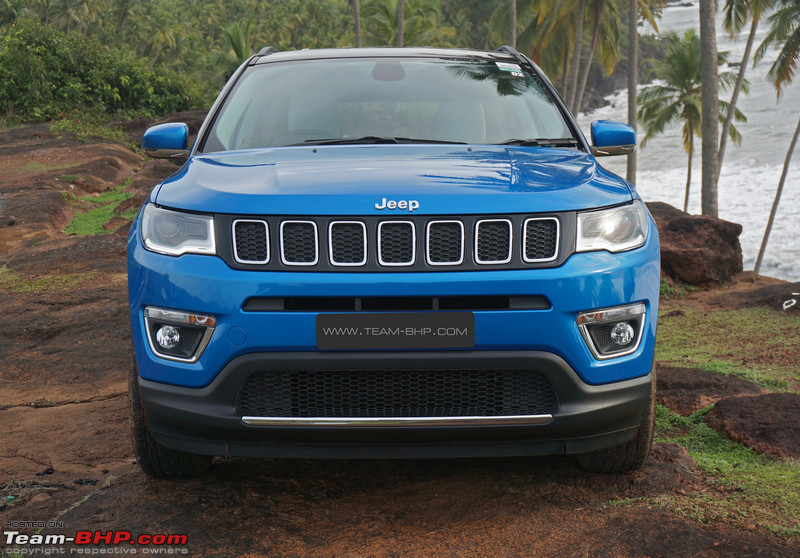 At the rear, there are minimalist styling cues and the designers have kept it simple. Chrome lining runs from the side of the car to the base of the rear windshield. Jeep logo is prominent! Tailgate handle looks ugly & out of place - imagine how much cleaner the rear would look without it (Creta has it nicely merged with number plate garnish - link): 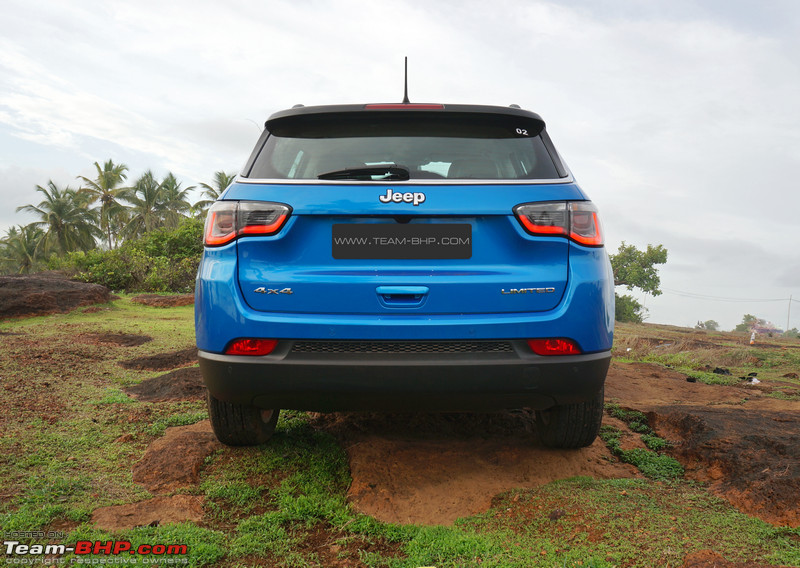 Side profile shows a sloping roofline, giving the SUV a squatted rear. Check out the subtle, muscular character lines along the door handles, accompanied by a faint one below. The square wheel arches are a part of the Jeep tradition. Chrome line runs from the A-Pillar, above the windows & onto the D-pillar. Blackened roof looks sweet: 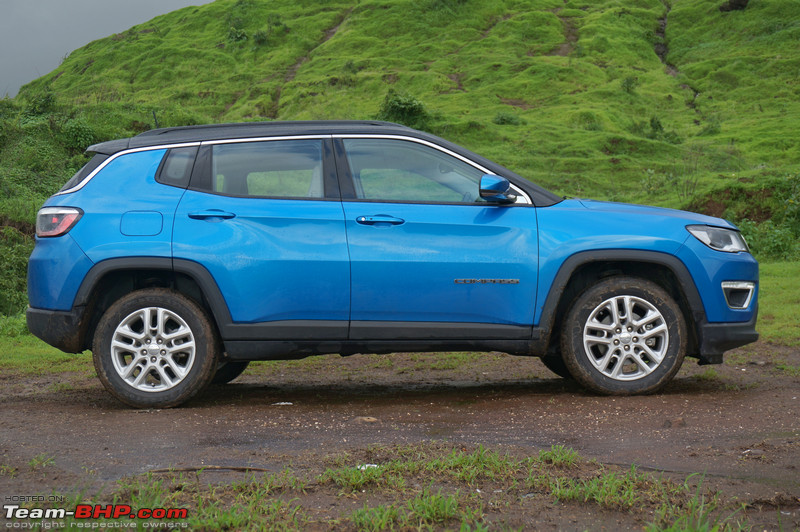 It's not big though. When you see it in person, that'll be the first thought in your head. Here is the Compass alongside the Creta: 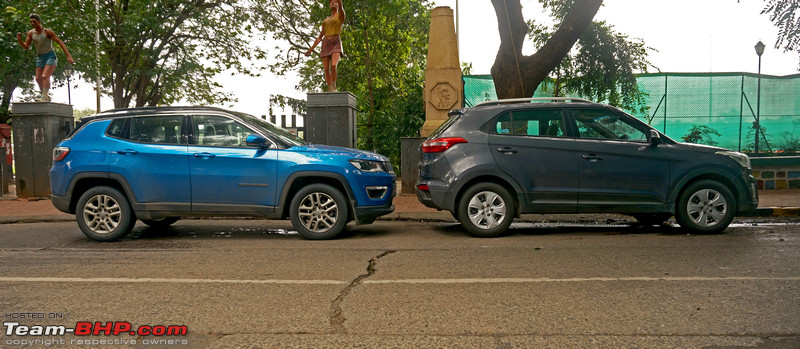 Very solid build quality, satisfactory fit & finish and good paint. On the flip side, the Compass is h-e-a-v-y. Base variant weighs 1,537 kilos, while the top variant goes to 1,562 (AWD = 1,641). In comparison, the Creta diesel tips the scales at 1,304 kg. Like the Hyundai, the Compass is a monocoque SUV (Scorpio & Safari Storme are tougher body-on-frame UVs): 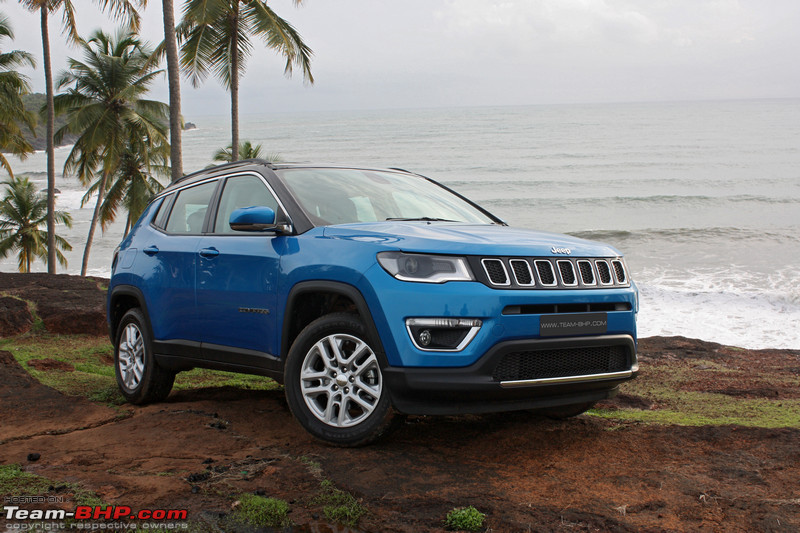 You can see how beefy the wheel arches are in this image. They add to the brawny stance. Equally, we might add, even the 17" wheels look small from some angles: 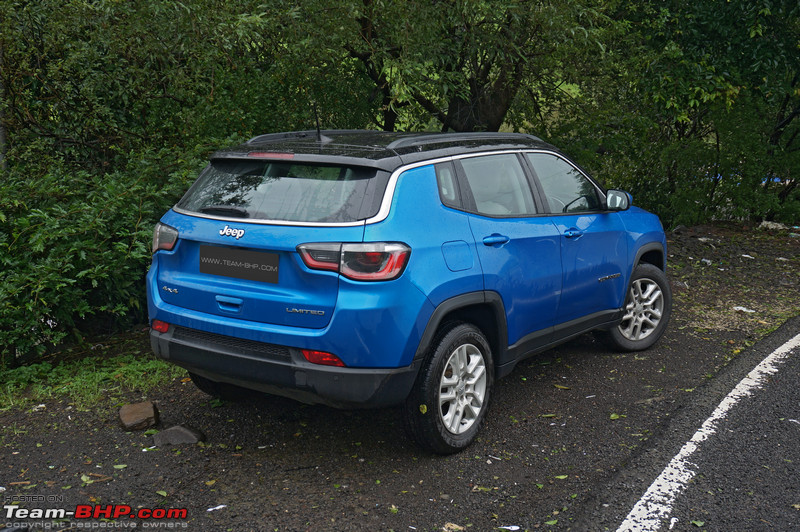 Swept-back headlamps draw inspiration from the Grand Cherokee's (link to image): 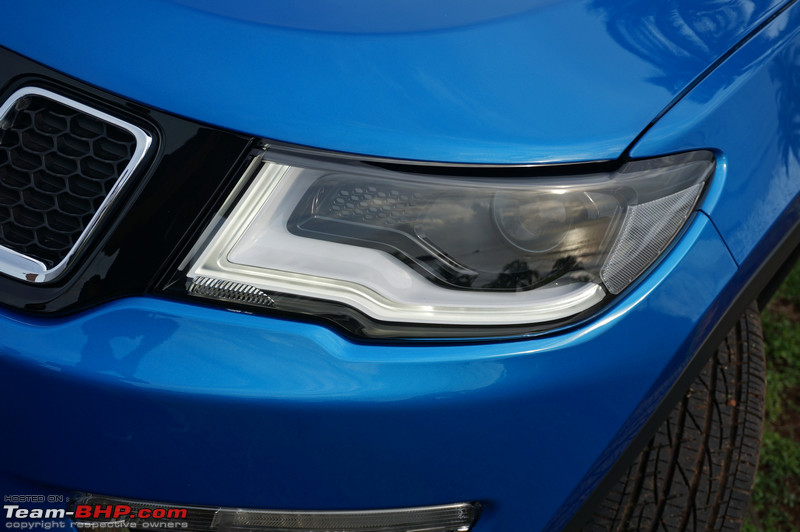 This Limited 4x4 variant gets bi-xenon HID headlamps. The Sport variant comes with 'quad halogen' headlamps, while the Longitude variant has halogen projectors. We can't think of too many cars that come with 3 kinds of headlamps! Just leads to inefficiencies in production: 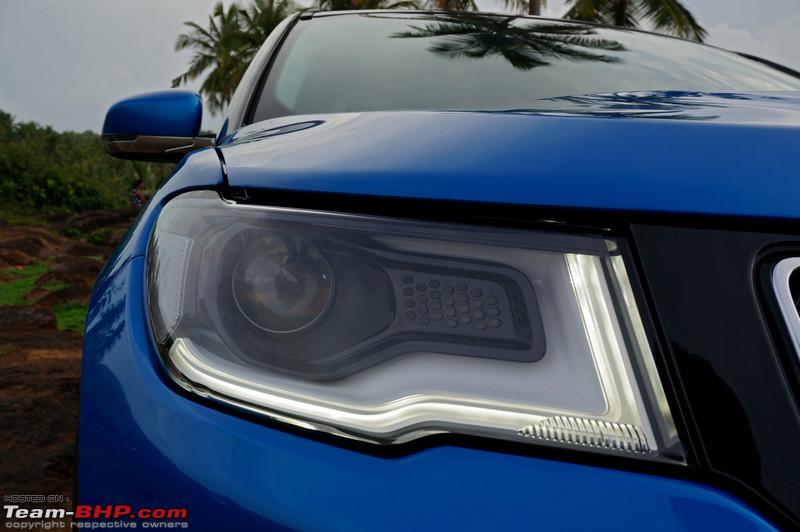 A peek at the shiny black beehive detailing inside: 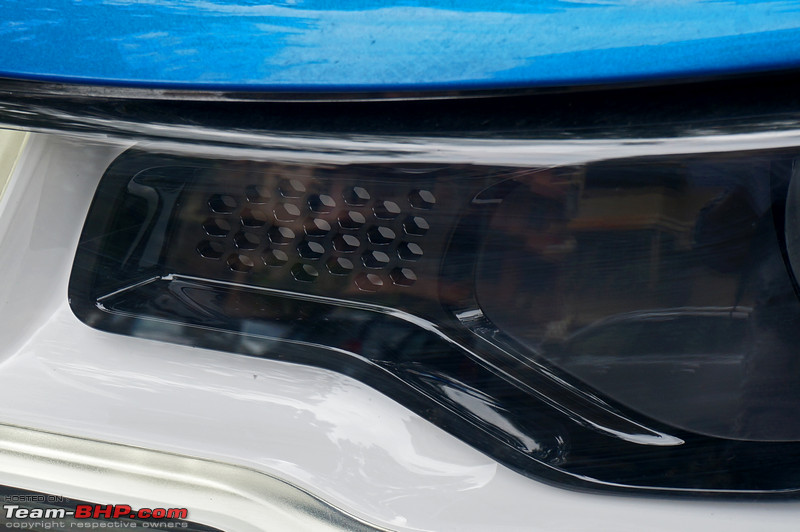 With all the lights in action. L-shaped LED lights aren't DRLs; they are pilot lamps: 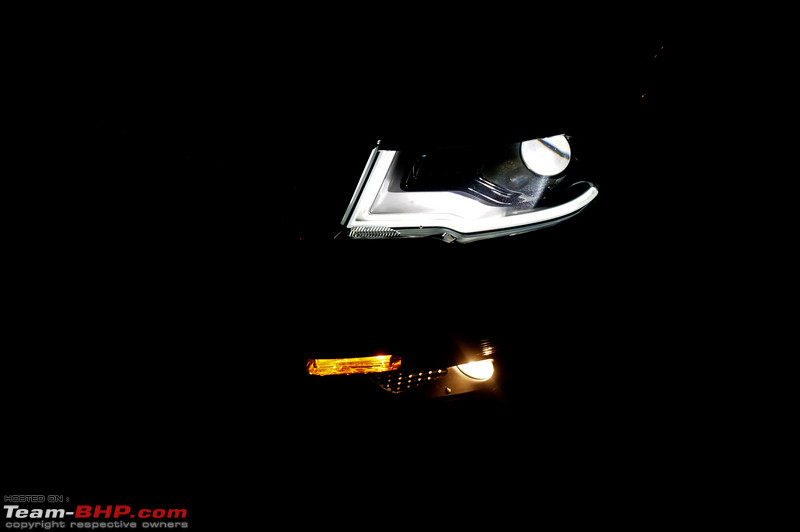 Foglamps with a u-shaped chrome surround, and turn indicators right above. Here too, see the detailing next to them. Compass gets cornering foglamps (they light up in the direction of the turn): 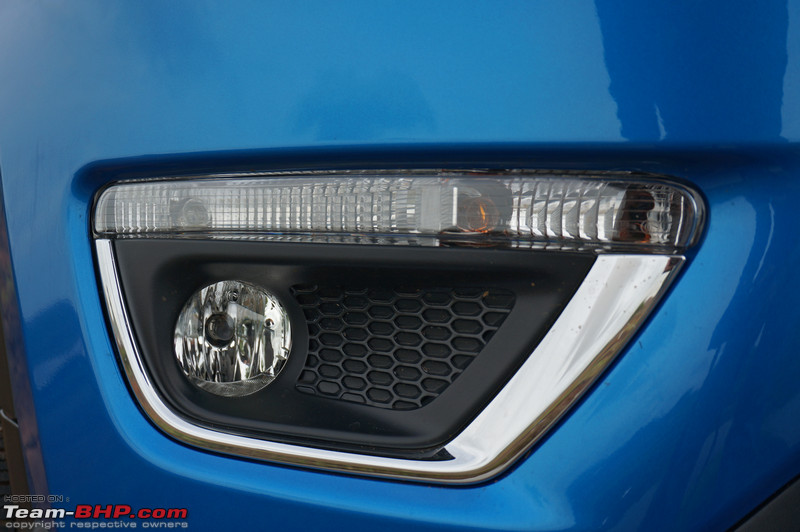 Front parking sensors showcased on the pre-production model didn't make it on the final spec (reference image): 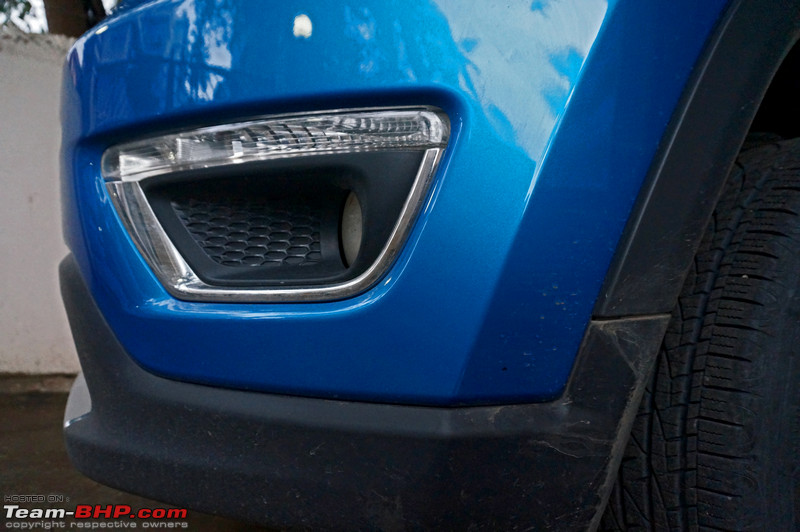 You'd expect the iconic 7-slot grille to let air in? Surprisingly, the grille is sealed! Jeep says this is for aerodynamics. They are quick to add that the Compass is the most aerodynamic Jeep ever built: 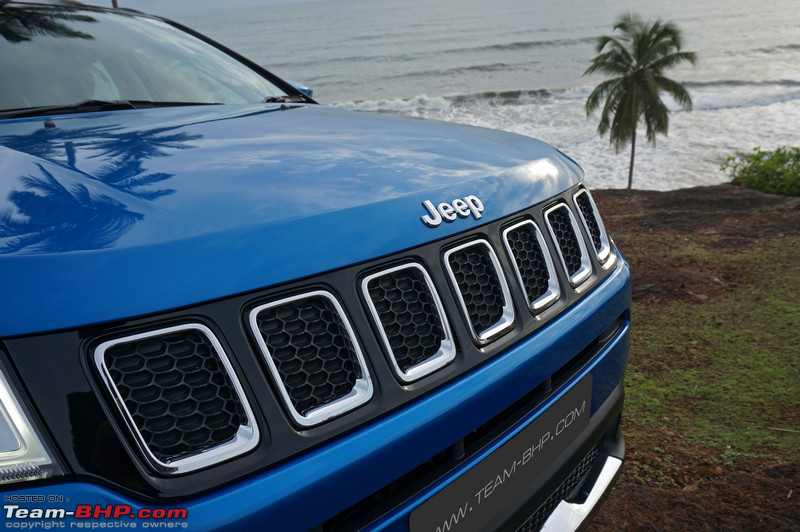 The actual air intake is in fact from this wide slot below and… 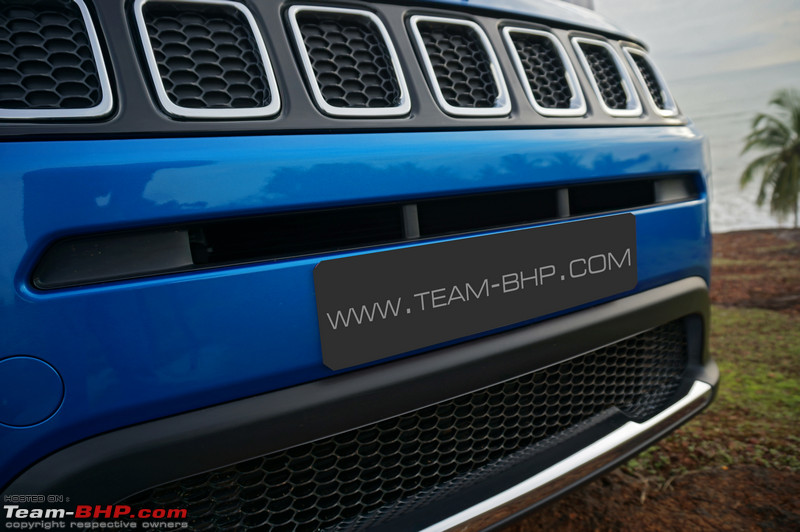 …the air dam at the bottom (side area is sealed though). Chrome lip at the bottom is classy:  Full wind deflector / protector provided below the bumper is low, too low. It's flexible, not hard. On the offroad trail, this was the sole part of the vehicle that was scraping the ground. Some BHPians have reported that it scrapes over tall speed-breakers too! 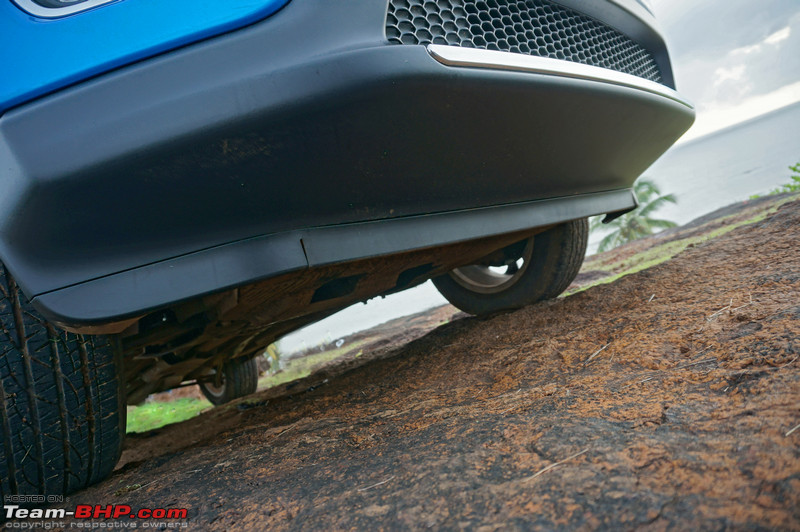 The underbody gets a protective cover at the front. What you see through the hole in the center is the silencer pipe's flexible joint: 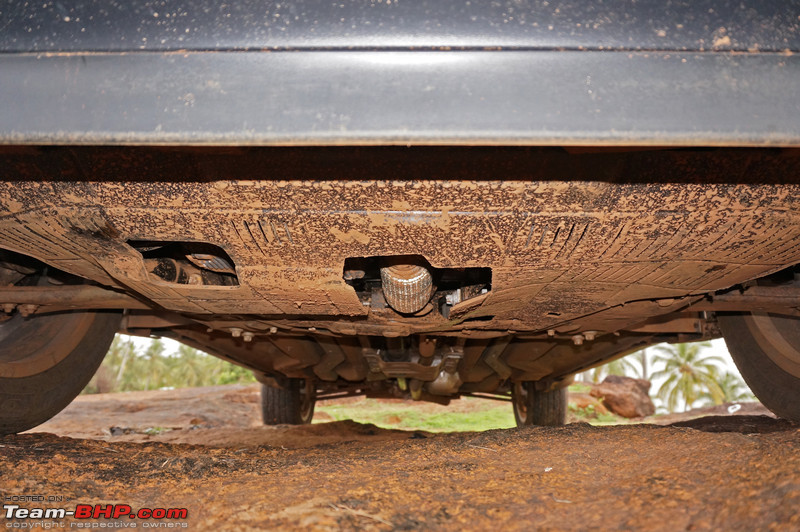 The underbody protection stretches a long way back: 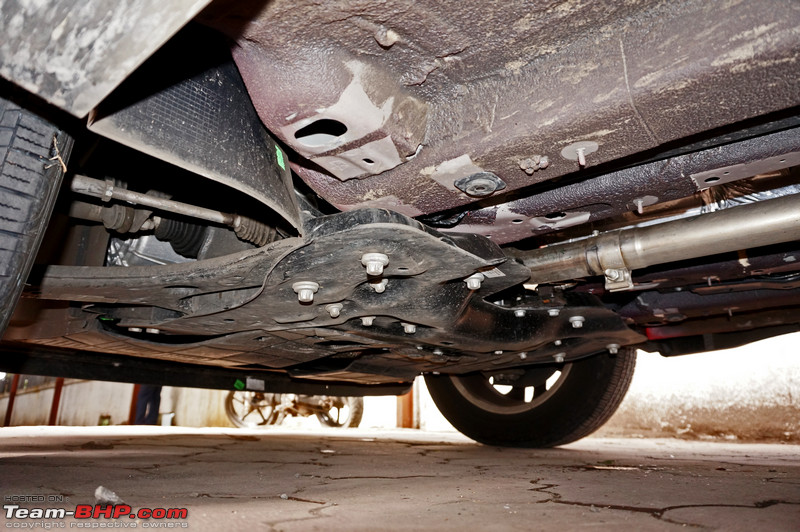 A long hood with the Jeep logo perfectly placed on it. Bonnet hump brings some muscle here: 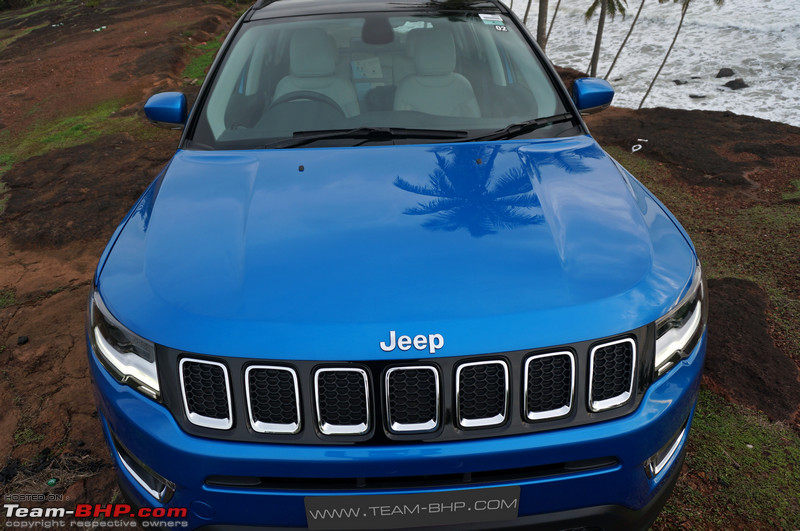 Frameless wipers. Windshield washers are located on the bonnet; they should have been hidden behind it. Looks outdated. The Compass gets an acoustic windshield which helps in reducing noise levels inside the cabin: 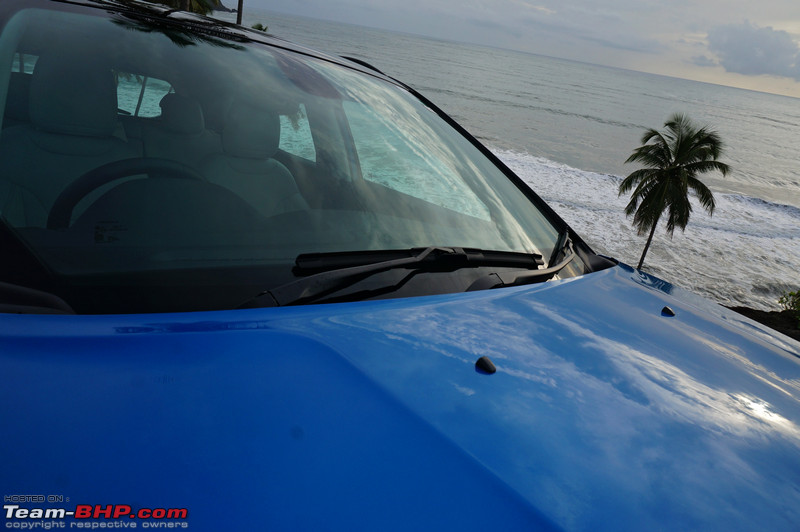 The Compass comes with a bunch of Easter eggs! It’s a feel-good addition and really suits a car with the Jeep badge: 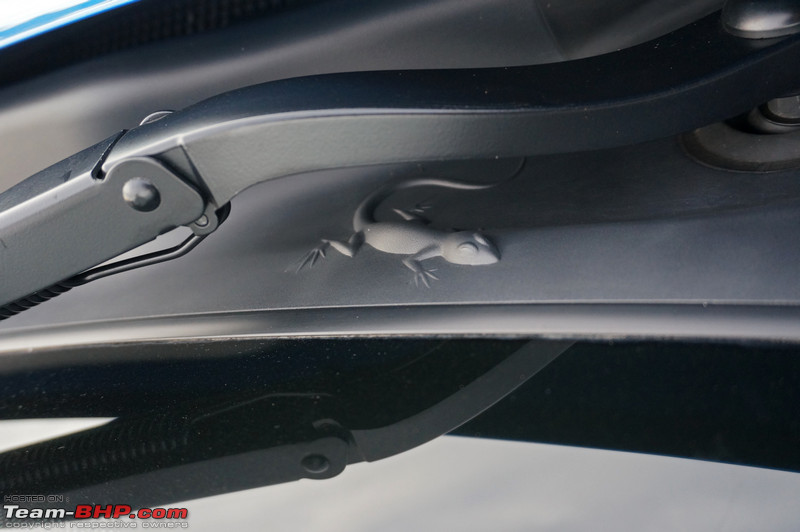 The washers squirt out a healthy spray & the wipers match that with a good sweep. They cover a large part of the windshield: 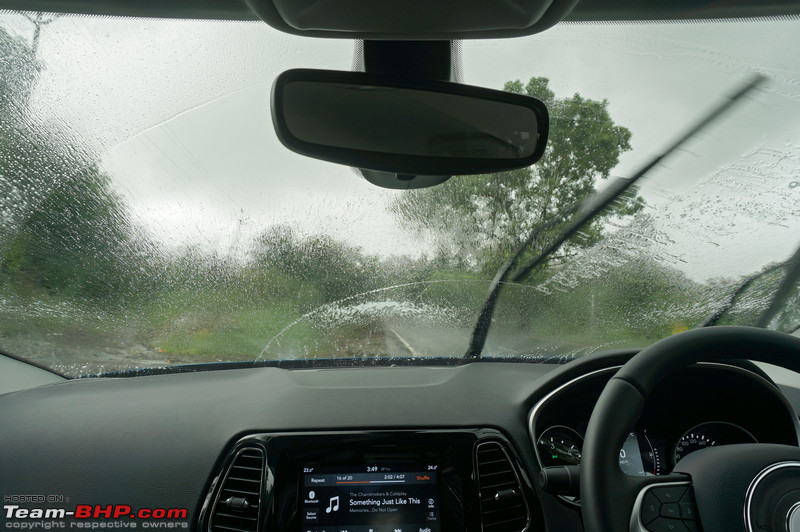 Panel gaps are consistent throughout. Again, unlike what we've seen of cars from this factory (Linea image): 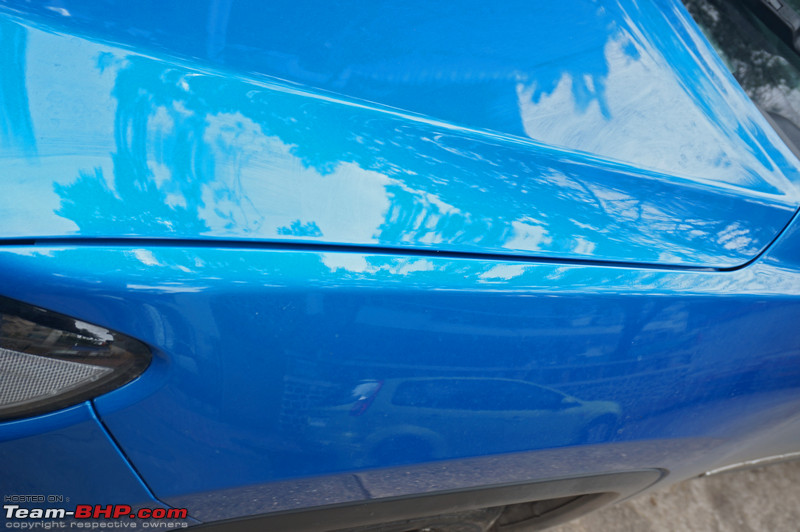 Full & proper wheel cladding at the front… 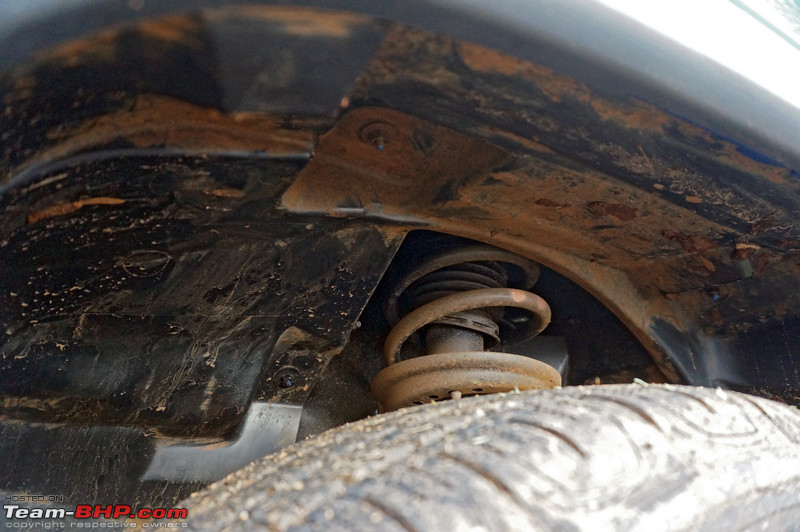 …as well as at the rear. Nowhere in the car will you feel that corners have been cut: 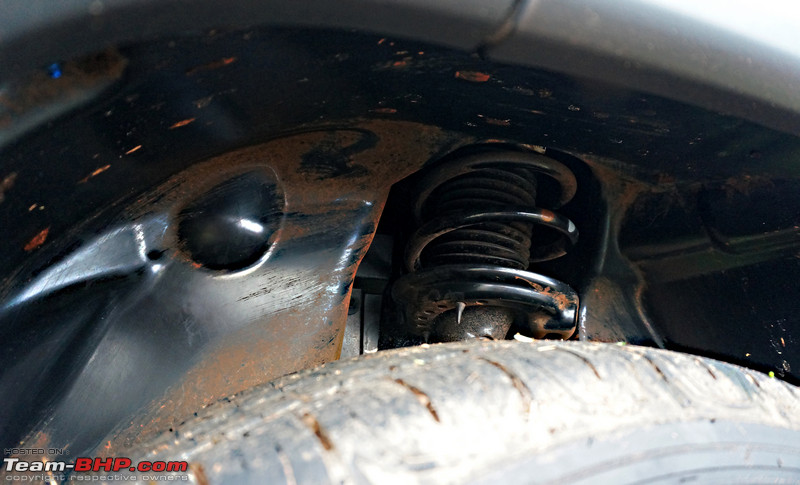 17" rims on the higher variants with a tyre size of 225/60 (lower variants get 215/65 R16). Tyres are Firestone Destination LE2s. These are NOT all-terrain tyres that offroaders would prefer (the LE2s sucked in offroad conditions). The LE2s are designed primarily for on-road usage. If you buy a Compass AWD and intend to rough it out, swap these for all-terrains (Michelin LTX A/T, Yokohama Geolandar etc.): 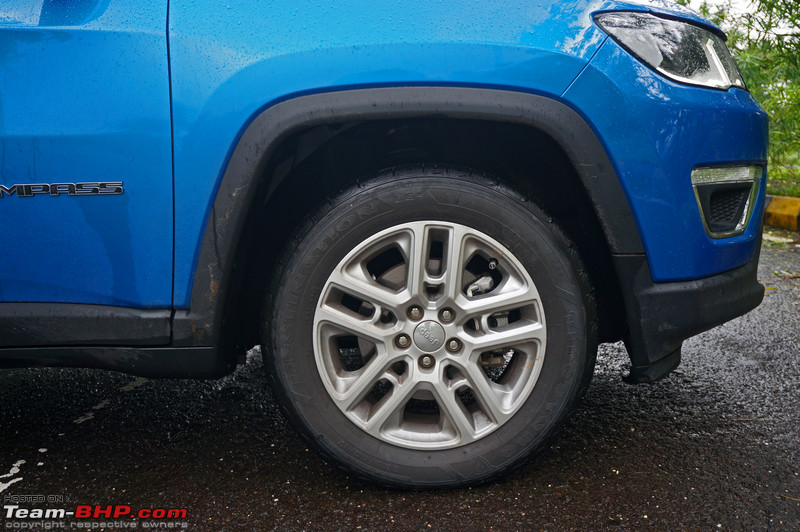 Weird! The rear wheel is a little too offset from the center of the wheel arch: 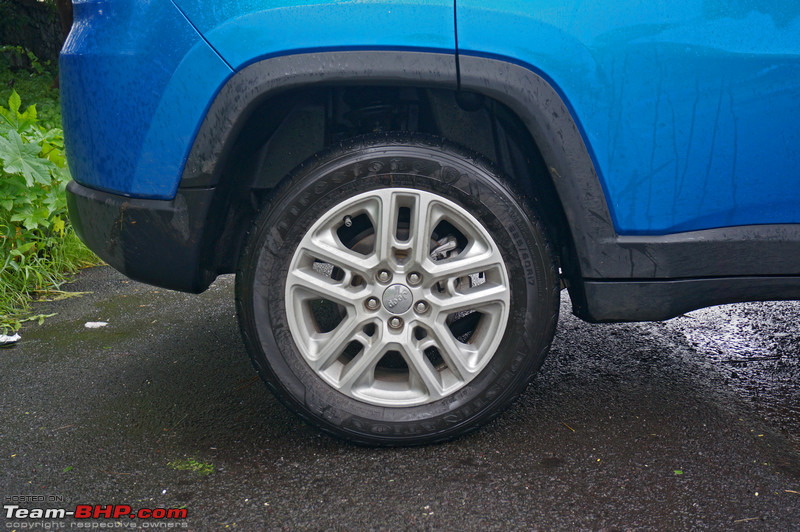 Front wheels are equipped with ventilated disc brakes, while the rear wheels get solid discs:  Stylish ORVMs with integrated blinkers:  The application of chrome below the ORVM is distasteful. Looks gawdy in an otherwise classy car. They should have ended the chrome at the window line itself: 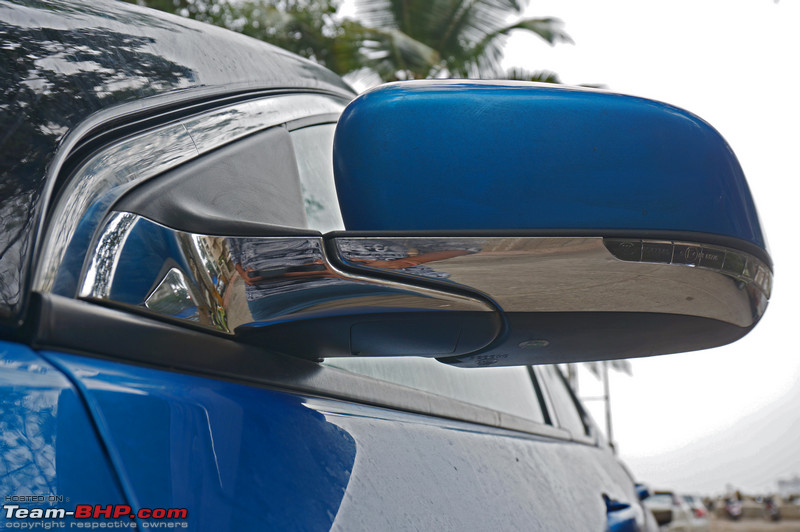 The request sensor is used only for locking purposes! To unlock the car with the key in your pocket, simply slide your hand behind the handle and pull. Sensors placed behind the handle detect your hand & unlock the car: 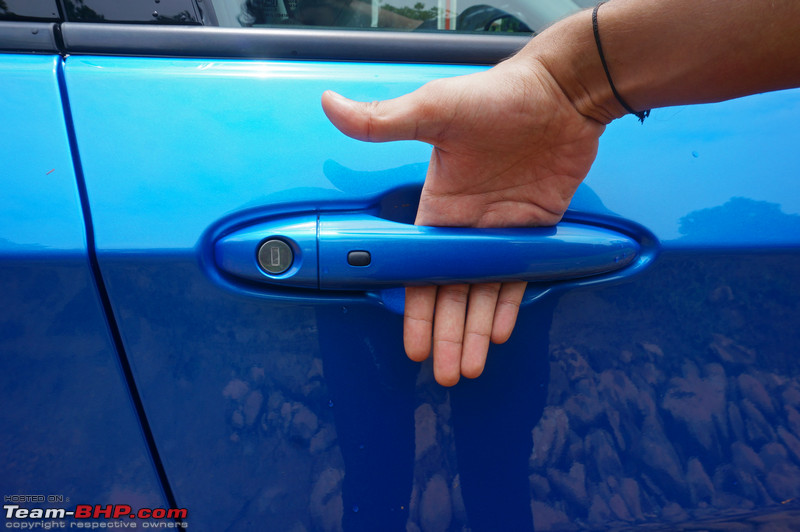 The front passenger's door gets a request sensor for keyless exit as well (keyhole only on driver's side): 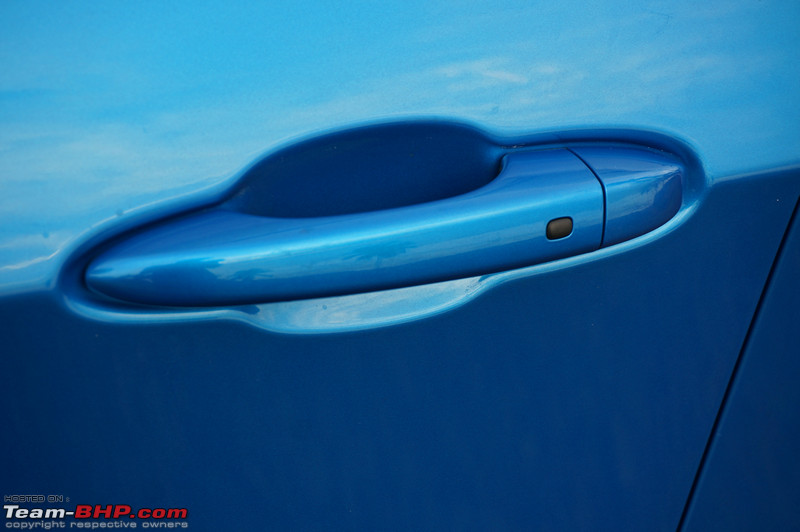 Black plastic cladding runs around the car. It's present on the bottom of the doors as well: 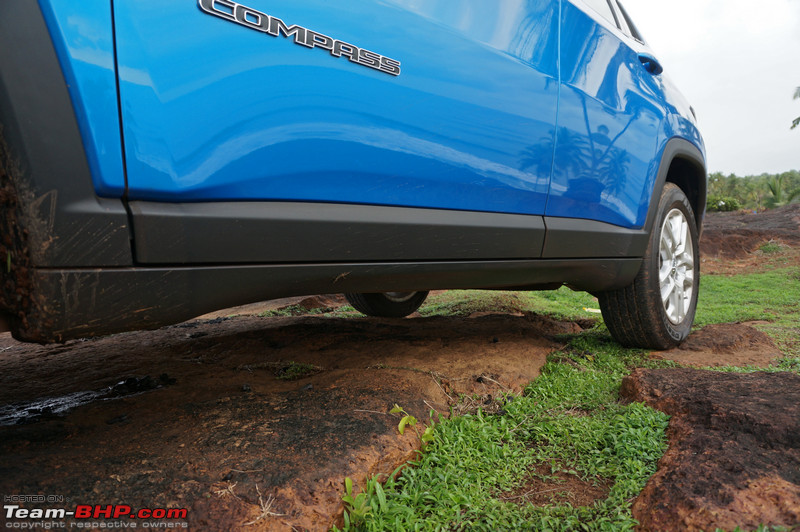 Bold Compass badging looks fantastic! It's there on both front doors: 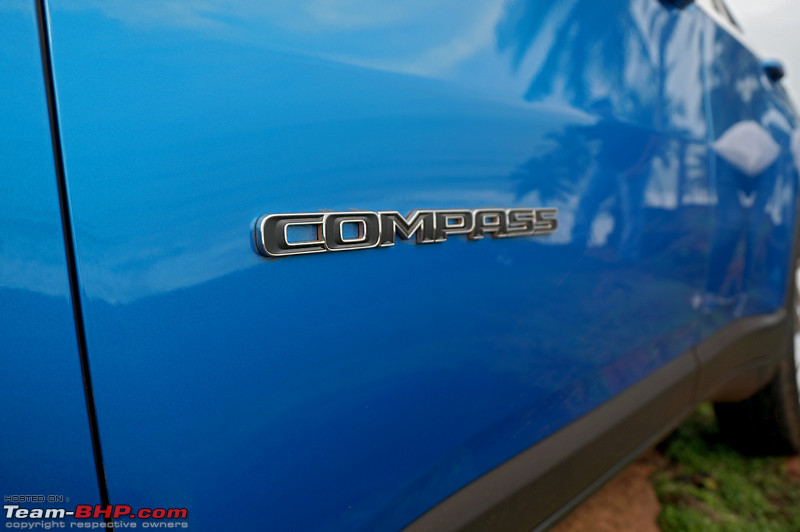 Notice the small rear quarter glass & thick D-Pillar. The bumper doesn't protrude out too much, yet we aren't worried. Why? Because the tail-gate is recessed inside (check it out). Not too worried about the metal area getting damaged in a low-speed impact: 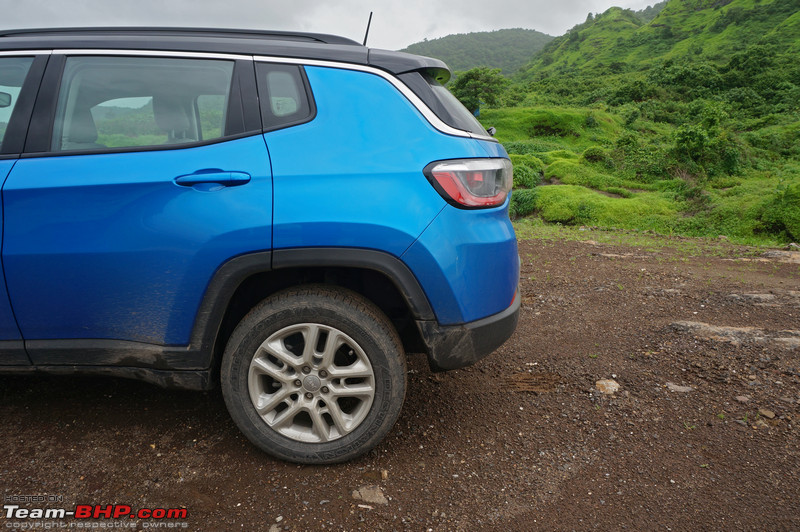 The car gets a ribbed roof structure for additional rigidity. Roof rails feel sturdy: 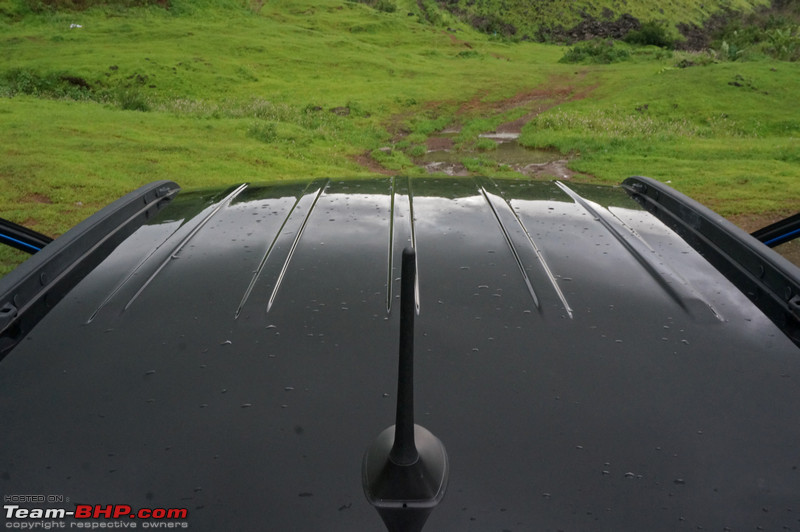 Four attachment loops have been placed on the insides of the roof rails (you can see one of them here). Four positions are provided with each attachment loop - they are covered… 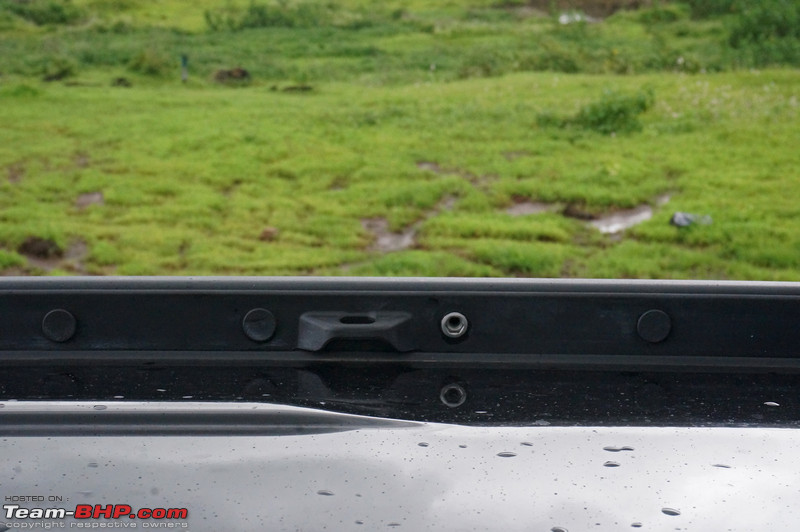 …with plastic screws: 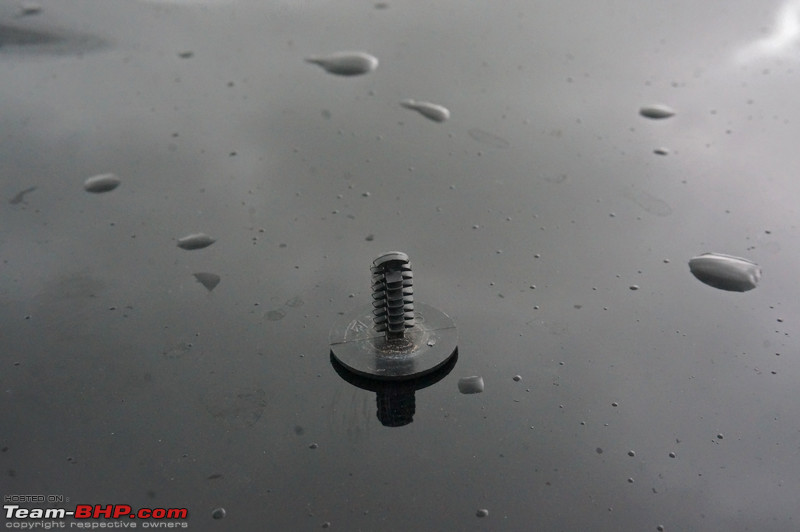 A close look at the gloss black integrated spoiler + HMSL. Roof antenna located at the rear: 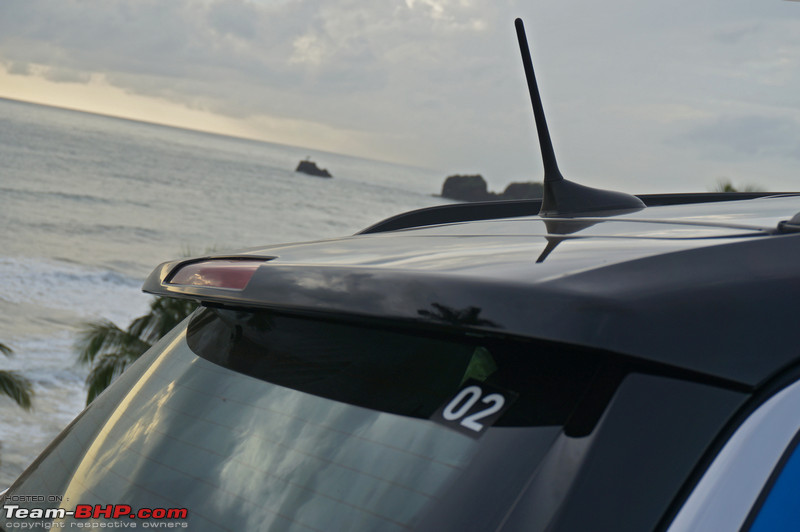 The LED strip at the bottom comes on with the pilot lamps (like the headlamp strip). Turn indicator is placed on the top left, while the reversing light is on the top right:  With all the lights in action. Compass gets adaptive brake lights: 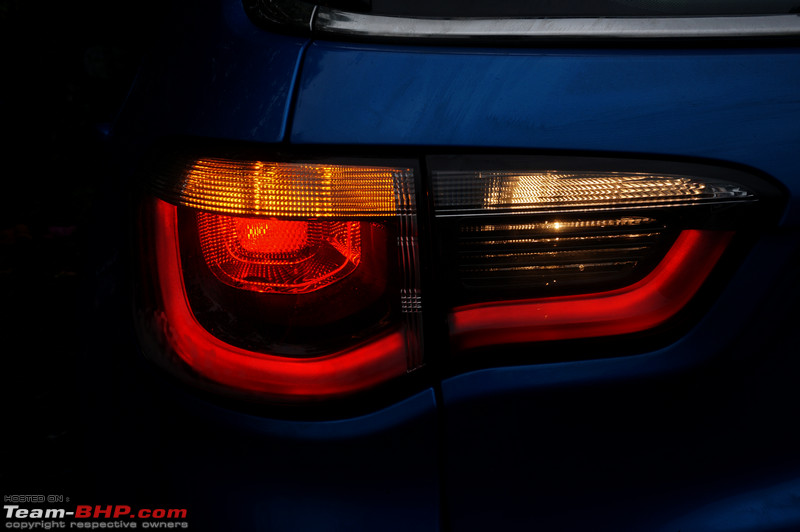 The rear wiper is a size too small for the windshield. Don't miss the zig-zag pattern of the defogger: 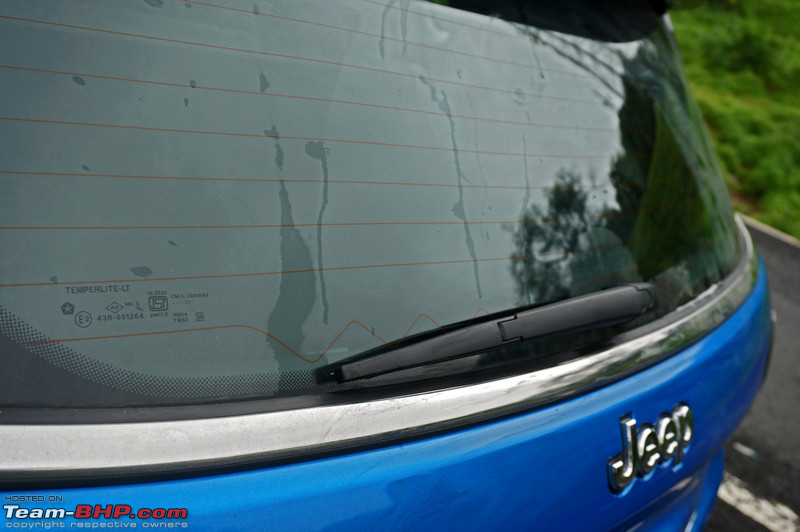 The rear washer is neatly tucked away under the spoiler. Doesn't stand out like in some other cars: 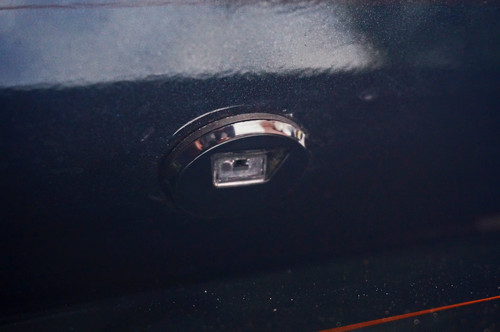 Attention to detail - the Jeep logo has been placed in a carved out recess on the tailgate. The Italian-Americans know a thing or two about style: 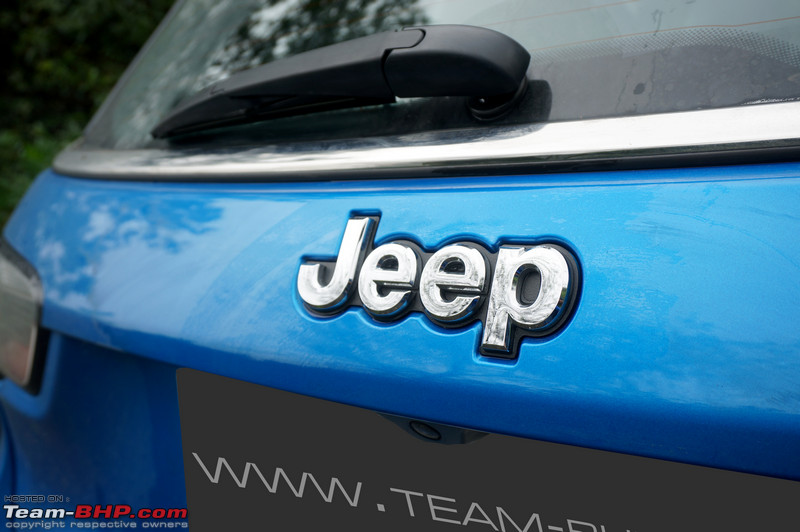 Reversing camera is located right below, between the white LED number-plate lights: 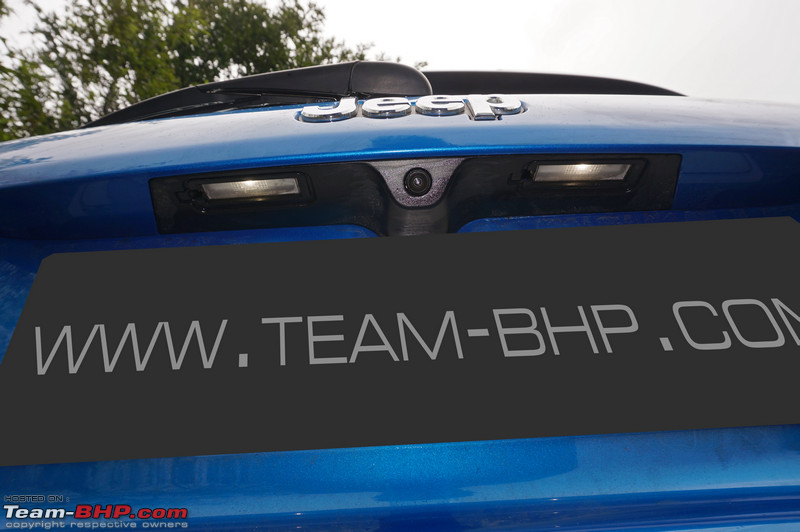 4x4 badge on the left… 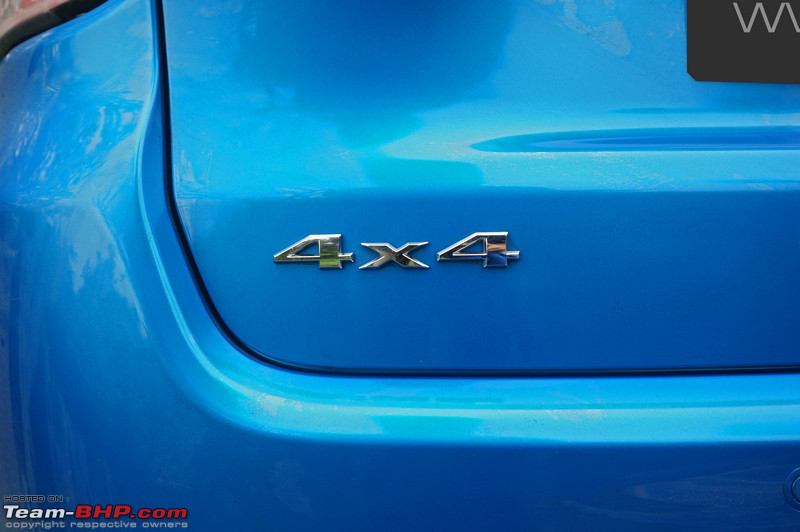 …with the variant badging on the right. There is no engine badging anywhere on the car: 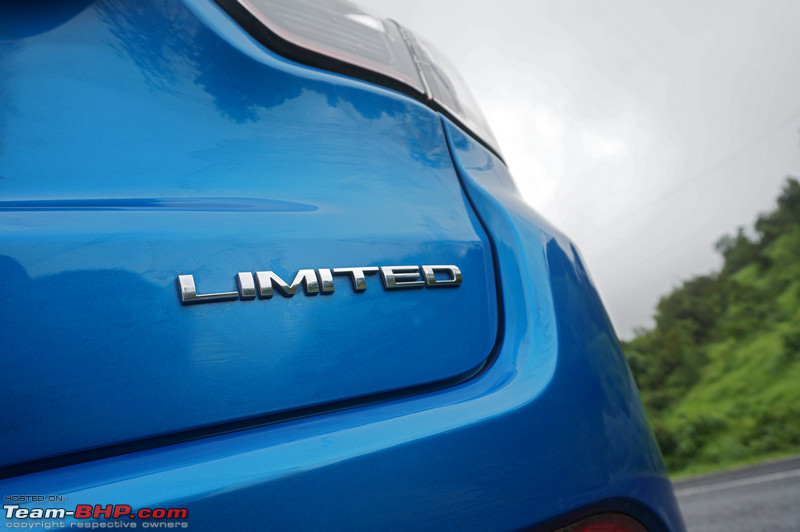 Two rear foglamps lower down on the bumper. Check out the placement of the parking sensors at different heights (two above, two below). No skidplate on this AWD SUV, not even at the front: 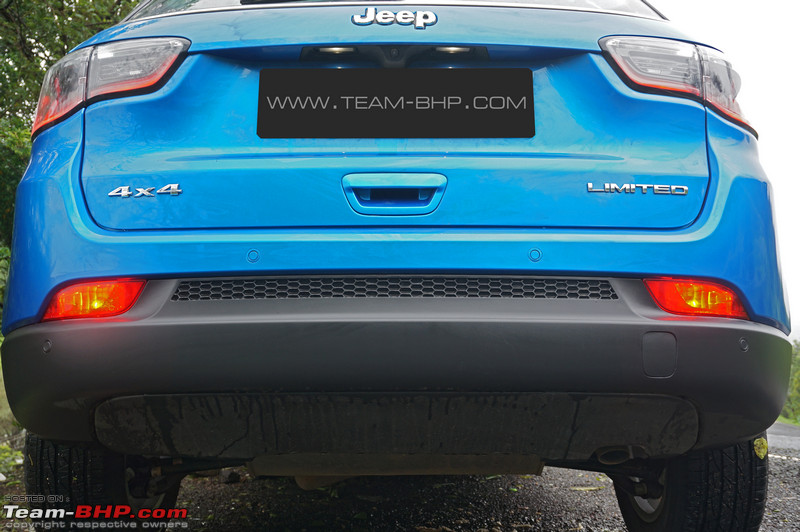 A design element on the rear bumper - the beehive pattern makes its way over here too: 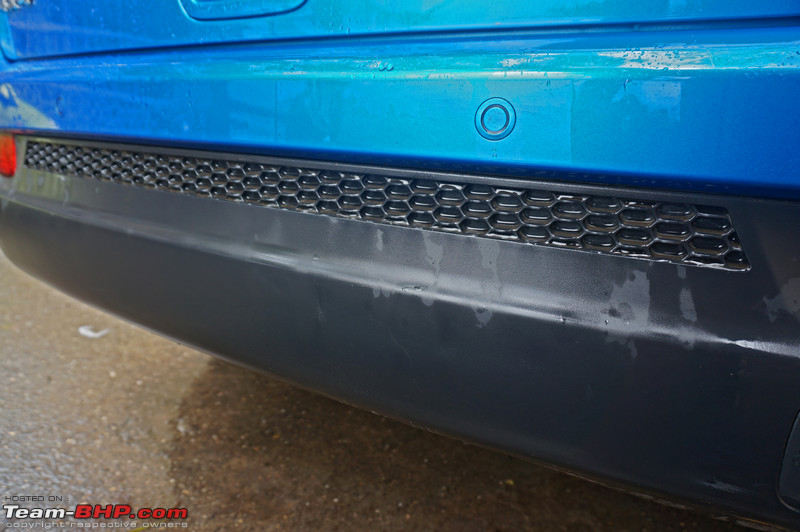 Behind this cover... 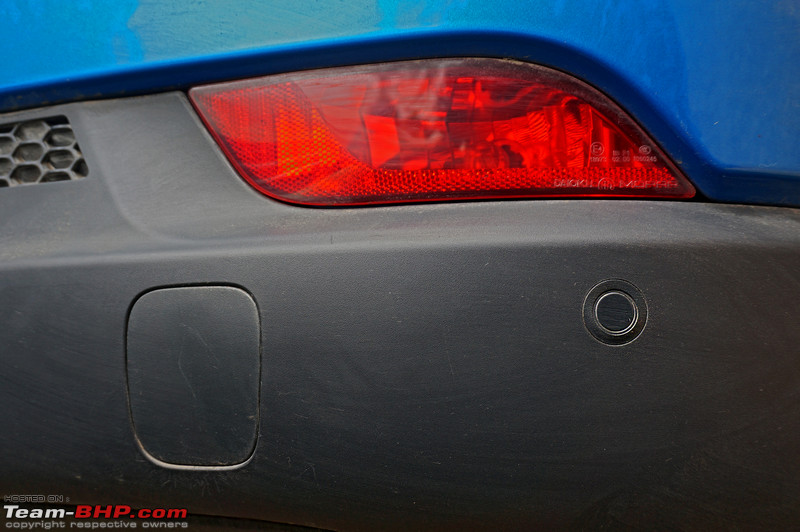 ...is this. Screw the tow eye in here when needed. This is provided at the front too. On a Jeep, we wish proper towing hooks were given (only the international Trailhawk edition of the Compass gets them): 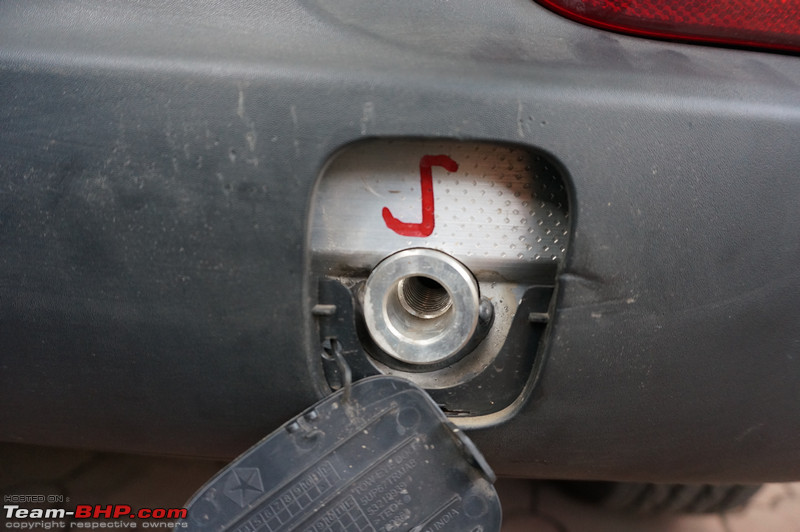 Exhaust pipe is barely visible when viewing the vehicle from the rear. Huge end can (in silver). The drive being given to the rear wheels is visible in this picture: 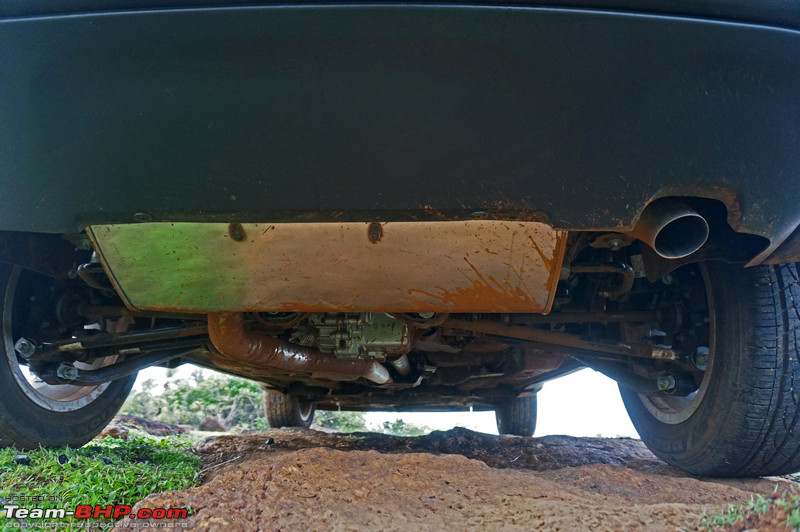 McPherson strut and lower arm control disc at the front: 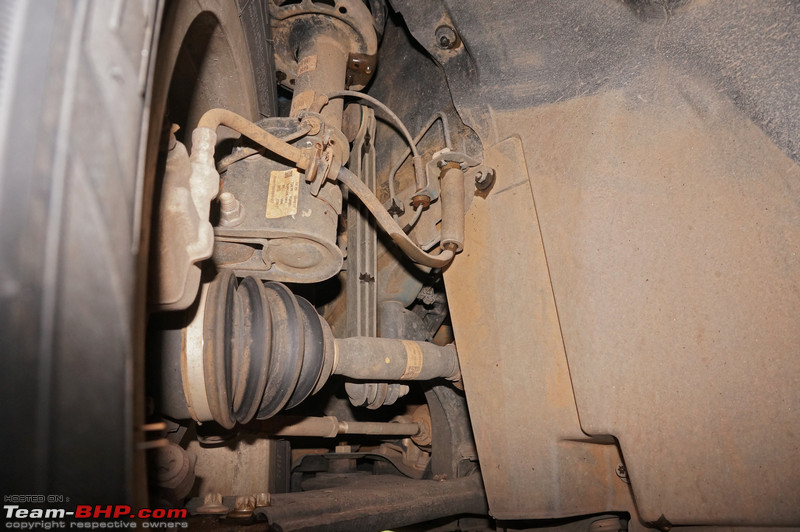 The rear gets a multi-link suspension. No cheap torsion beam setup here: 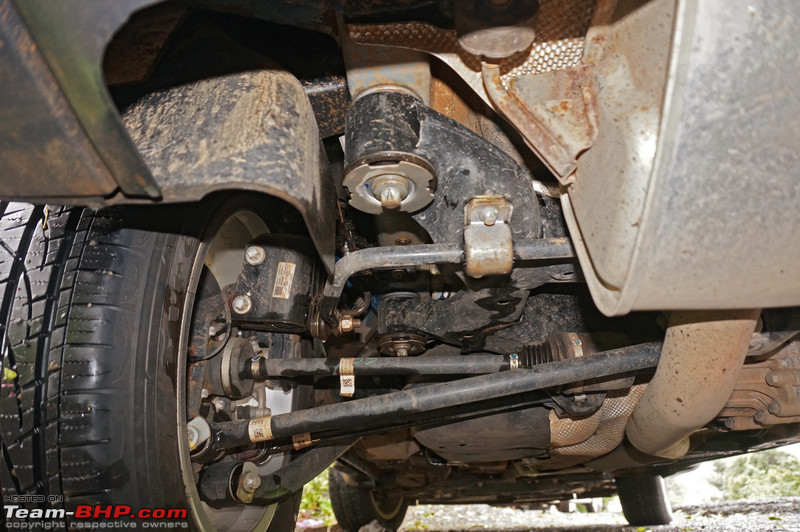 Last edited by GTO : 27th September 2019 at 08:57. |
| |  (109)
Thanks (109)
Thanks
|
| The following 109 BHPians Thank Omkar for this useful post: | --gKrish--, aadya, aeroamit, akshay81, aniket17, anjan_c2007, artemis_fowl, arun_josie, AutoIndian, avinash_clt, Behemoth, bejoy, BigBrad, BlackPearl, blackwasp, CarguyNish, carrazy, Chrome6Boy, CrAzY dRiVeR, Crazy_cars_guy, dailydriver, damager21, daretodream, darklord, deetjohn, Dr.AD, DrANTO, dZired, Flyer, Gaboonviper04, GKMahajan, GTO, hemanth.anand, HumbleBee, igp_79, iliketurtles, InControl, jaganpec2002, Jaggu, Karthik Chandra, kashyapz8055, kiren, KK_HakunaMatata, Leoshashi, libranof1987, lovetorque, mbz180, MDED, mi2n, MSAneesh, Myth_sx, Nohonking, NPV, pankaj_sachdeva, paragsachania, phoenixash, PraNeel, PrasunBannerjee, procrj, PuntoMania, r0nit7, R2D2, RaghuVis, Rajeevraj, ramnaresh_2000, RavenAvi, redracham, regenitin, rejeen, RGK, ritzy, rohansachar, rshanker, S.MJet, samabhi, sayakc, SchumiFan, scopriobharath, sharanvenu, shipnil, Simat, skchettry, SmartCat, sngautam, SnS_12, somspaple, sourabhzen, spdfreak, sridhar-v, SS-Traveller, suhaas307, sunny29584, swiftnfurious, theexperthand, theredliner, timuseravan, TorqueyTechie, Turbanator, uday.ere, Varun_HexaGuy, vb-saan, Vid6639, Viju, Vik0728, vinodvayyat, WAM-4, Wildy, X_T_A Rose, yosbert |
| | #4 |
| Team-BHP Support  Join Date: Apr 2016 Location: Mumbai
Posts: 2,980
Thanked: 29,620 Times
| Interior - Front 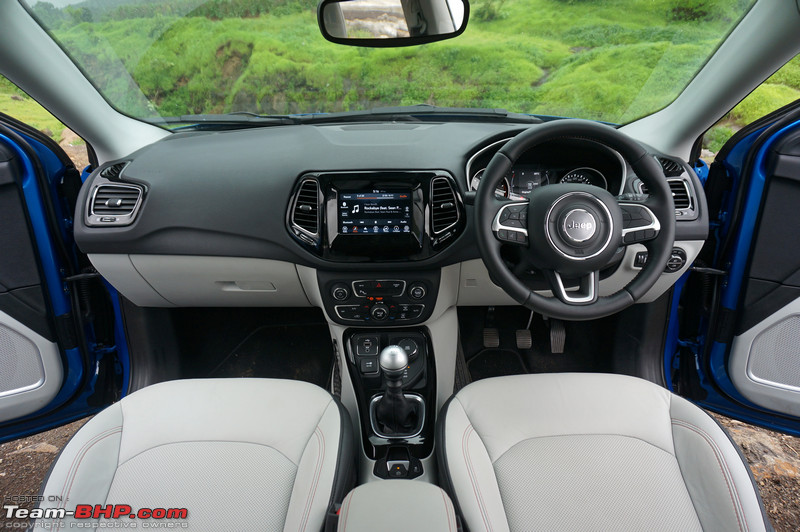 The front doors are heavy and they open & close in a triple stage action. They open wide enough, and shut with a solid reassuring thud. BHPians will love it! Getting into the front seats isn't much of an issue as you can just slide into them. No need of climbing up or watching your head. Though while getting your feet inside, one thing you will surely notice is that the door sill area is pretty wide. The interiors are straight-forward; there is no 'wow' factor. The dashboard's layout does remind you of the Grand Cherokee as it follows a similar design philosophy (reference image). The dash carries a dual-tone theme with the top part in black & bottom area in very light grey (almost white). The seats on the top-end Limited trim come with Ski Grey (white) leather upholstery & ruby red stitching; this, along with the white parts on the dashboard and doorpads, will be a royal pain to maintain in Indian conditions. The base Sport variant is available with black fabric upholstery on the seats (+ cattle tan stitching), while the mid Longitude variant comes with sandstorm beige fabric upholstery (+ dark saddle black stitching). Do note that the Sport & Longitude variants get an all-black dashboard (not dual-tone like our test car). The top part of the dashboard is made of soft-touch material and the firmness is spot on (read = not too soft). The bottom (white) part however gets hard plastics which is basically the area your hand won't be going too often. Fit and finish are good and the interiors are well put together for the most part. Some of the buttons used in the cabin and a few plastics seem ordinary. They feel durable, but just aren't as premium as say, what the Tucson offers. Still, quality is overall satisfactory and no owner will be complaining. Again, it's hard to believe the interiors are screwed together at the same plant that makes the Linea & Punto. In terms of ergonomics, all controls are within reach and easy to find. In fact, this is probably the first FCA product in India that doesn't have major ergonomic issues for the driver. With the wide range of seat adjustments, you can get your perfect driving position (except for the dead pedal and clutch resting point - both are too high). There is adequate headroom, but cabin width is limited (it's just enough). One flaw = the center console is tilted towards the passenger side! A design error really as it should be tilted towards the driver. Jeep hasn't changed this from the LHD version. A lateral view of the dashboard. The top part is finished in black, while the bottom area is very light grey / white. The lower two variants come with an all-black dashboard:  A nice & tall driving position provides a clear view of the road ahead. Hatchback and sedan owners will surely appreciate the view from the driver's seat. The bonnet is also seen a little. Unfortunately, so are the wipers and that massive IRVM base (more on that later). All round visibility is satisfactory, except for…  …this thick A-pillar. Visibility is hampered towards the thick bottom part of the pillar. Watch out for blind spots!  Leather-wrapped meaty steering is perfectly sized. It feels fantastic to hold, and the thumb contours are very usable too. This cast magnesium steering is a joy to use in the city as well as on the highway. Excellent for an EPS:  The Compass gets an awesome dual-tone horn that really suits the vehicle. The hornpad isn't easy to reach for people with small hands. They'd end up using their palm instead of fingers. Jeep logo looks sweet and gets two concentric chrome rings:  Zooming in to show you the red stitching:  Steering wheel buttons are the same as those on the Jeep Cherokee (not Grand) & Renegade. The arrow & OK buttons on the left side are to operate the MID. Voice control and telephony buttons are placed just below. The blanks on the right look AWFUL! Surely not something you'd expect on a car costing over 20 lakhs. On the international variant, these buttons are used for cruise control. The buttons on the bottom right are dummies on the international Compass as well. On the Cherokee, these have buttons for adaptive cruise control:  You'll be surprised to find the audio controls on the back side of the steering wheel - very unconventional, yet ergonomically perfect. This rocker-type switch with a push button in the center is present on both sides of the steering. Buttons on your left side can be used to increase and decrease the volume, while pressing the middle button will mute the sound. The ones on the right are for going up & down tracks, with the center button for changing the audio source:  Tilt & telescopic adjustment provided:  Nice looking twin-pod instrument cluster. The top portion of the dashboard stretches out quite a bit to provide a shade over these dials. A 3.5" MID sits between a tachometer on the left and a speedometer on the right (just the way we like it). Font size of speedometer should have been a size up (digital speedometer can be shown on MID if it bothers you). Fuel & temp gauges are digital:  The needles do a full sweep on start-up. Check out how the engine temp warning light is placed on the top left corner and the low fuel warning light is on the bottom right - good attention to detail, as those are the levels you don't want to reach on the meters next to them:  Gap between the steering wheel and dashboard is properly covered with this leather-like material. Also notice the chicane design element in brushed silver at the base of the instrument cluster:  Flaws in quality check. The above-mentioned covering wasn't properly cut off & finished. This is how it looks on the left side of the steering column:  The Jeep logo welcomes you when you switch on the Compass. Digital speedometer available. The MID shows a variety of vehicle-related information including the exact coolant temperature, oil temperature, battery voltage level (also useful to gauge battery health) and the number of km / days until the next service (actual service interval is 15,000 km / 1 year). You can also view the instantaneous and average fuel economy, along with distance to empty. Former is displayed graphically on a 0 - 30 km/l bar. The two trip meters show distance, FE and time travelled (specific to each trip meter). The current audio source can be displayed on the screen if you so wish, along with song information (when playing via USB or Bluetooth). Lastly, the MID will display warning messages (e.g. coolant level low):  Compass displayed on the top left corner (SW in the picture) with outside temperature on the top right. This can be changed to show the date. Don't miss the tiny Willy's jeep logo on the currently selected option in the third picture. Some vehicle settings can be adjusted using the MID screen. The compass can be calibrated as well. You have the option to turn off the passenger airbag (not that we recommend a child ever being on the front seat). The safety and assist option has three settings - buzzer volume, hill start assist and speed warning. The buzzer volume can be set to three levels or turned off. The hill start assist can be turned off, while the speed warning can be set from 30 - 200 km/h:  A bunch of warning signs pop up on the MID in different scenarios. For safety reasons, the electric parking brake cannot be disengaged without pressing the brake pedal (auto-disengage feature explained later). Door open warning shows you exactly which door is open (secondary warning light pops up on the bottom left of the MID). Tailgate warning is so well designed (notice the changed symbol on the bottom left corner). The traction control ON and OFF prompts are shown on the MID, along with a yellow warning light behind the speedometer needle. A warning also pops up on the screen if you open the driver's door when the engine is running. The MID reminds you to press the clutch before starting the engine: 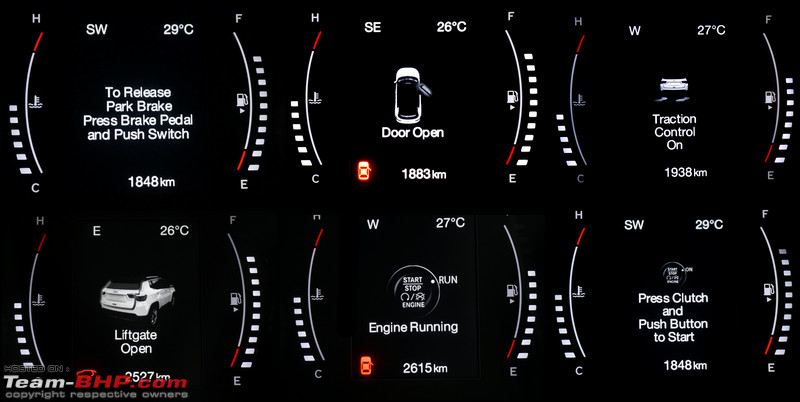 Control stalks feel durable; we are glad that the single left control stalk from the Grand Cherokee wasn't carried forward here (it was too busy). LHD orientation = lights on the left, wipers on the right. The turn indicators make a likeable sound while on. When tapped lightly, the lane change feature makes the turn indicators flash 5 times. Two intermittent levels for the wipers have been provided. The first intermittent level has an interval of 10 seconds, while the second is dependent on the speed of the vehicle. Rear wiper also has two intermittent settings. The wipers don't perform a delayed final sweep after some time to catch that excess water trickling down on the windshield (this delay function is found in the Punto). When you engage the reverse gear with the front wipers working, the rear wiper does a single sweep. I thought it would keep working! And while on the topic, why does your 20 lakh SUV not have auto-wipers, Jeep India?  The engine start button is placed where you would usually insert the key! This is the worst position we've ever seen for this button. How convenient is the cost cutting. No chrome lining or any aesthetic enhancements either:  The A/C vents are similar to the Grand Cherokee's. The air-flow control can be adjusted or shut completely (though some air still seeps out). Check out the piano black surround in the form of a chicane:  No auto-headlamps in a 2-million rupee car  !! The headlamp controls are placed on the right side of the driver (below the A/C vent). Control knob is smooth and easy to operate. The left-most roller controls the brightness of the instrument cluster; one next to it is the headlamp leveller. At this price point, the Compass should've had auto-levelling headlamps: !! The headlamp controls are placed on the right side of the driver (below the A/C vent). Control knob is smooth and easy to operate. The left-most roller controls the brightness of the instrument cluster; one next to it is the headlamp leveller. At this price point, the Compass should've had auto-levelling headlamps: Look below and you'll see this graphic pointing you to...  …the bonnet lever. Ugh, that metal plate looks so ugly and should have been covered with a plastic panel. OBD port located here as well:  Doors carry forward the dashboard's dual-tone theme. The top area of the doorpad has soft touch material. White part below is sure to get soiled within a fortnight of ownership:  Triple door seals do their job phenomenally in eliminating wind noise. It's so much better controlled than even the pricey Tiguan we drove right before the Compass. Take the Compass to a crowded area of your city, open & shut the door, notice the difference in sound levels and you'll know what we're talking about:  Speaker at the bottom of the door gets a classy silver border:  Brushed silver door handles are tastefully designed & finished. It gets a lock image on the side which is a neat touch, though unlocking manually requires some effort (not lady friendly). Black housing also gets - you guessed it - a chicane:  Like other Fiats we know, the power window console is placed waaay ahead (by long-armed Italians?). You'll be opening the rear window when you actually intended to open the front! Front occupants get auto up / down windows, while rear passengers only get auto down. The windows do have anti-pinch function. The mirrors are electrically foldable, while the central locking switch is at the bottom. At night, you'll see that the buttons are backlit in white. Doorpad gets red stitching:  Elbow rest and the area on the side are wrapped in leather. Over a long drive, I felt that it was placed a little too far away - wasn't able to easily rest my elbow here while driving: 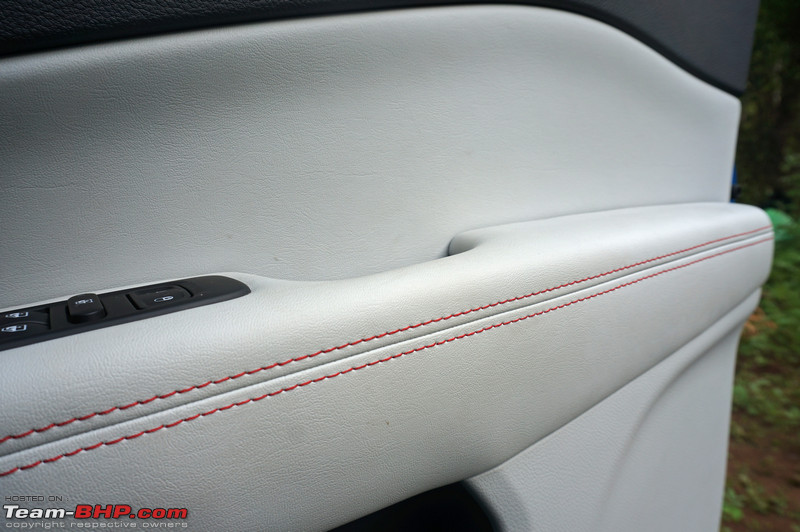 Door pockets are made for 500 ml bottles. You can push a 1L bottle in, but it's a tight squeeze. There is some space provided for other knick knacks: 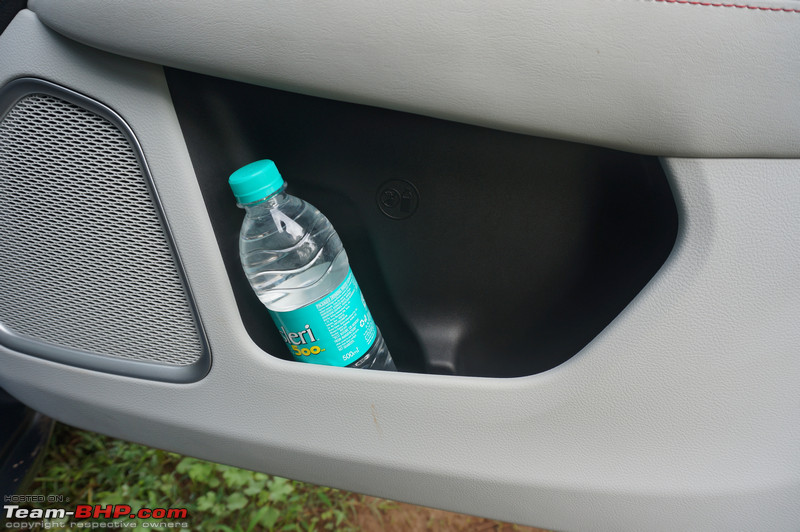 This storage area is illuminated:  In the door pocket of the passenger side, towards the end away from the bottle holder, you'll find this Willy's Jeep symbol with the letter 'M':  The door sill is w-i-d-e. Some elderly folk will find it inconvenient. Door sill gets a sweet Jeep branded scuff plate (it's not illuminated):  White seats for India - what was Jeep thinking? The seats are comfortable and provide good support (side bolstering too). The seat compound is adequately firm and would prove useful on long drives. Underthigh support is adequate & the bolstering on the seat base helps keep you in place. Even though adjustable lumbar support hasn't been provided (should've been there on such an expensive car), lower back support is satisfactory. Tall neck restraints look weird. Click to view the large size image and you'll see subtle 'Jeep' branding on the seats:  Adjustment levers feel sturdy & durable. Big one for height:  The fore & aft travel range is healthy. Short folk & 6 footers alike will be comfortable:  Good height adjustment range as well. Owners will find it very easy to find their 'perfect driving position':  Even the driver gets a grab handle (it has a damped closing action). A thoughtful addition IMO as some people do use it for ingress and egress - also seen on the Innova Crysta (reference image). Note the driver's Bluetooth mic:  Tall headrests look a bit weird. They are adjustable for height only (the international variant gets fore & aft adjustment too). A point to note is that the headrests cannot be removed from the seats (a good thing IMHO):  Good quality leather. Zooming in on the contrast red stitching of the seat. The seats of our new demo had already started to soil. If you buy the variant with 6 airbags, do NOT install seat covers:  The seatbelts are adjustable for height. Curtain airbags on the B-pillar. Few customers will see this as 6 airbags are offered only on the 4x4 diesel:  The seatbelt latch is sturdy and comes with a "dual locking tongue", Jeep India says. The front seatbelts are equipped with active/adaptive load limiters and pretensioners. The system gives out an audible warning if the co-driver hasn't buckled up. Excellent:  Those with big feet might face some issues. One, they'll find the footwell cramped and the pedals placed too close to each other (e.g. their left foot might brush against the dead pedal while operating the clutch). Then, with the clutch pedal fully pressed in, turn the steering wheel and you'll feel its rack movement on your foot. The dead pedal is tall and decently sized. However, for me at 5'10", its placement was way too forward as a result of which, my leg was resting crooked. Just didn't feel comfortable. It should have been pushed in more, away from the driver. What makes things worse is that the clutch pedal's resting point is also high. The top quality floor mat seen in this picture is available as an accessory and was given to us during the offroading session. Light grey panel on the left will get dirty soon:  Remove the floor mat and you'll see the iconic 7-slat grille design on the floor. If you have kids, play this game with them - have them find all the hidden Jeep graphics. It'll be a fun family afternoon:  Talk about the uniqueness of a vehicle! Look closely at the dead pedal. See those dots and dashes in four vertical lines? That's actually Morse code which reads - Sand, Snow, Rivers and Rocks (L-R). Decode for yourself (Wikipedia image):  The steering column joint on our test vehicle had already started rusting! Should've had proper coating / paint:  A look at the stock carpet-type floor mats. Held in place by circular locks:  The ORVM is well-sized and provides a clear view of the action behind. Also thanks to…  …this convex area (beyond the dotted line) which extends the coverage area. Check out the 'Jeep' logo on the top. GTO drives a real Jeep as well and on his Jeep, there are only two places where the 'Jeep' brand name appears (on the dash and front bumper). This car gives you more than a fair share of reminders of the iconic brand you are driving:  The IRVM's size is just about okay. Tall drivers (with a pushed-back seating position) will wish that the mirror was wider. View is hampered on the sides by the rear headrests:  A manual switch for dimming the IRVM feels so cheap. Why no auto-dimming, Jeep? In addition, the base on which the IRVM is mounted is h-u-g-e! Some drivers will find it annoying as it occupies an unusually large area of the windshield:  Driver's parking view is hampered by the headrests and thick D-pillars. But well, it's the same story with most SUVs. Parking sensors & reversing camera will come in handy:  You can easily tell how the center fascia is tilted towards the passenger instead of the driver (LHD orientation). The area on the center console (surrounding the gear lever) is finished in piano black. In the Sport and Longitude variants, a brushed silver insert has been used instead of this piano black:  The infotainment system is a 7" touchscreen unit which is surrounded by a piano black panel. Too small at this price point. Touchscreen system should have been larger - even a Hyundai i20 gets a 7" HU. It's a younger sibling of the Uconnect system used in the Grand Cherokee. Has Bluetooth, USB and Aux-in connectivity, and further supports Android Auto, Apple CarPlay & MirrorLink. Its functions have been covered in a dedicated post later in the review. Center A/C vents get air volume adjustment knobs too:  The buttons below the infotainment unit are well laid out and marked. The 'mute' and 'screen off' buttons are nifty. Rear park assist disable button is placed below, along with 2 dummies. The climate control buttons are arranged here, with the central knob controlling the different modes of air flow. Dual-zone climate control gets dedicated buttons, in addition to the controls on the infotainment unit. The blower has 7 levels of adjustment and is silent at levels 1 and 2. It gets audible at 3 and 4, and is noisy above that. Realistically, you won't be using it on levels over 3 as the air-con is very effective. On most dual-zone climate control systems, there is usually an "all" or "sync" button to make the temperature common in both zones (example in Jetta). Jeep has skipped a physical button for this, but the 'Sync' function can be operated through the touchscreen HU:  How the buttons light up at night. Notice the circular white rings around the three knobs:  AWD knob on the center console, alongside the AUX, USB and 12V power socket. See the key symbol on the power supply flap? It indicates that the supply will come only when the ignition is powered on. There is a slat in between to hold your smartphone (not large phablets): 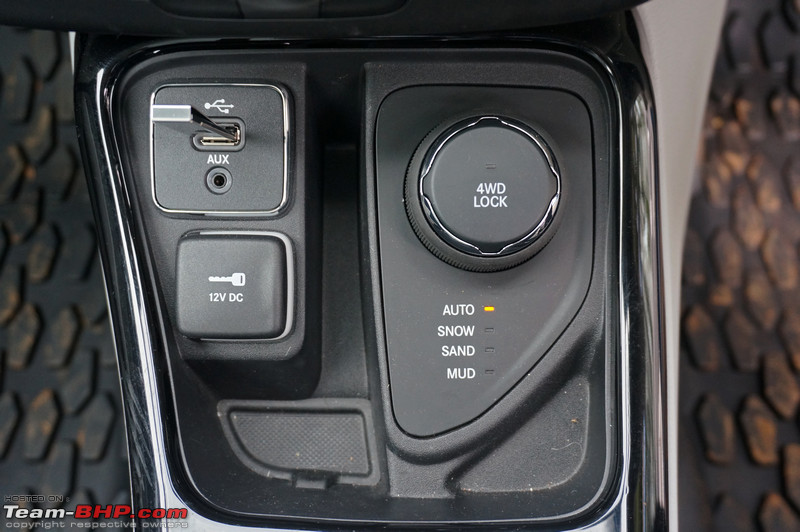 The 4WD control doesn't get the circular white rings of the knobs just above. The USB and AUX input ports are backlit as well. Don't miss the incomplete illumination of the 2 square units. It's not as much a border as it is a light to help you locate what's where at night. Serves the purpose: 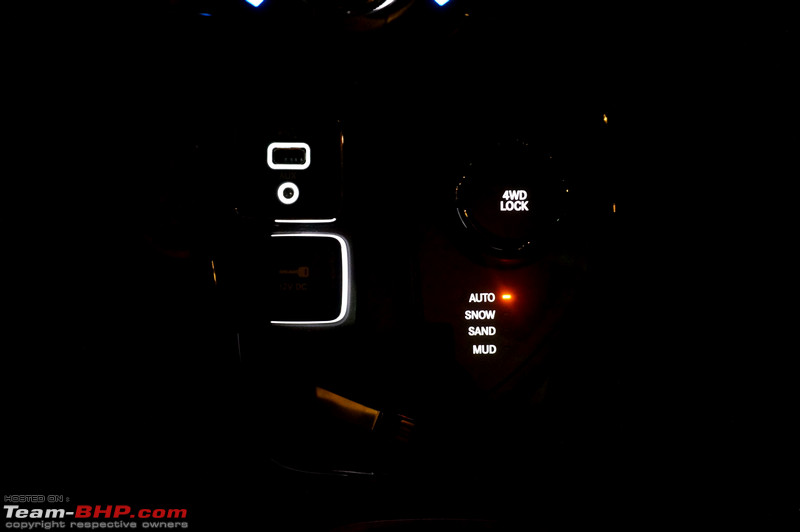 Sexy gear lever! A welcome departure from the leather knobs we usually see. The ball-shaped gear lever is a pleasure to hold. It's also the first FCA gearbox we've experienced that is smooth to slot. Engaging reverse is easy - it's up & ahead of 1st, yet slots with no effort. Gets a leather covering for the stalk and if you look closely… 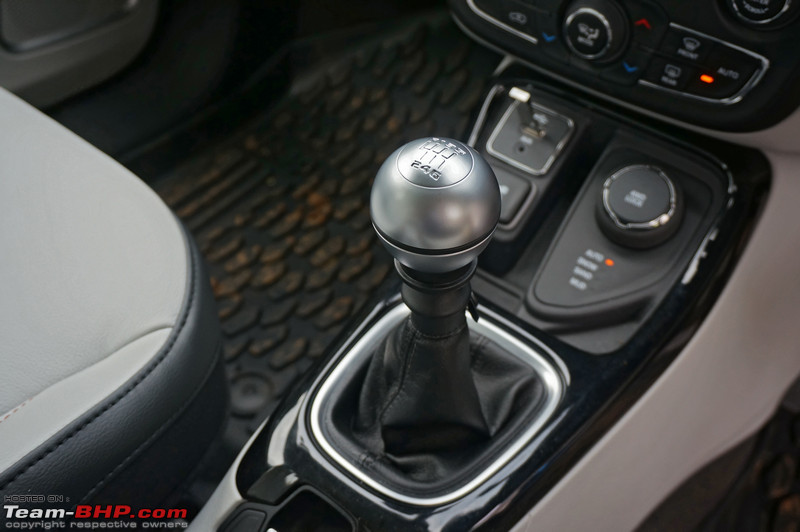 …you'll find the familiar 7-slat Willy's Jeep logo on the button holding the leather wrap in place! 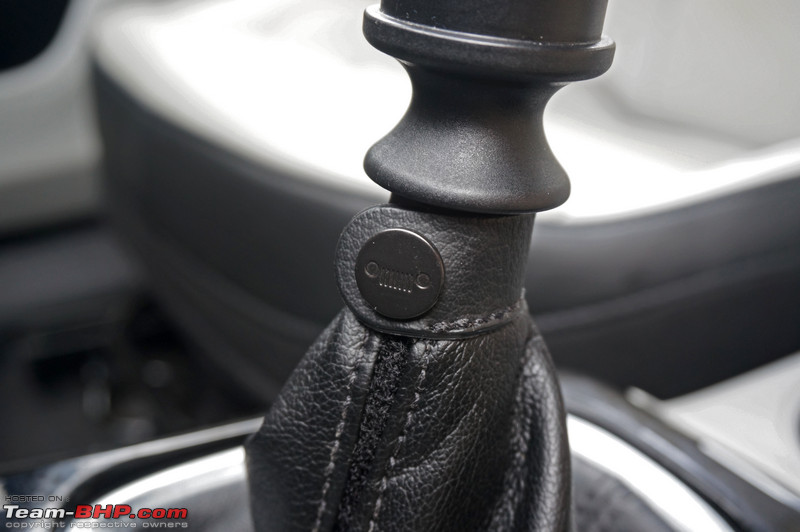 Electronic parking brake (EPB) is standard across all variants. Pull to engage, push to disengage. Don't sweat about playing with it on inclines - the Compass is equipped with Hill Start Assist which will hold the vehicle in place briefly, while your foot moves from the brake pedal to the accelerator. Moreover, 'Auto Park Brake' will automatically apply the parking brake every time you park (AT) / in key off position (MT) and automatically disengage when you start driving. It's important to remember that the EPB engages instantly without pressing the brake pedal. Hence, make sure you don't have a mischievous kid in the passenger seat as the vehicle comes to an immediate halt when this lever is pulled...even while driving. What's more, the switch is very easy to operate. The button on the right turns off the traction control, while the one on the left is a dummy (on the international variant, this button is dedicated to the auto start/stop function - one feature we're glad about not getting): 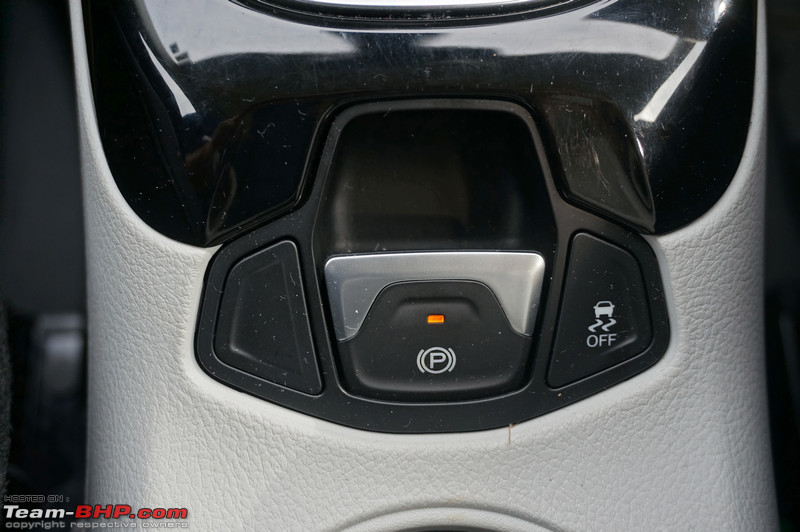 Two same-size cupholders are placed in between the front seats. They have a rubber base and get these rubber extrusions to hold cups in place: 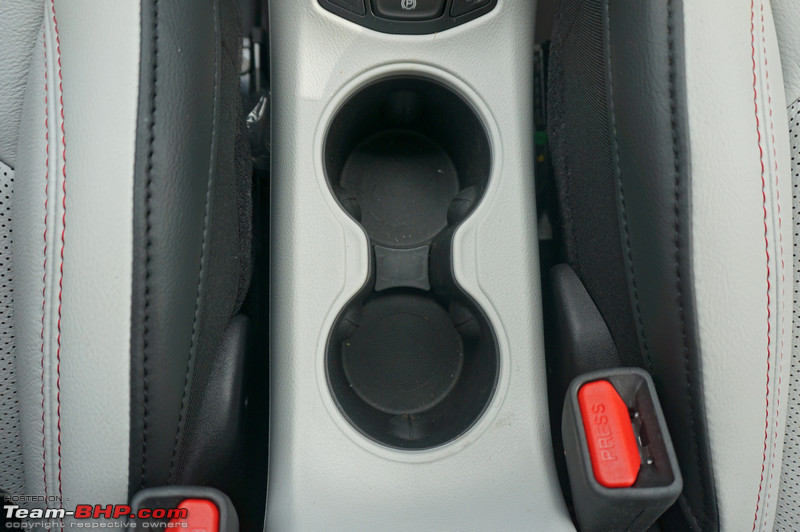 These cupholders get small LEDs at the bottom! Part of the ambient lighting: 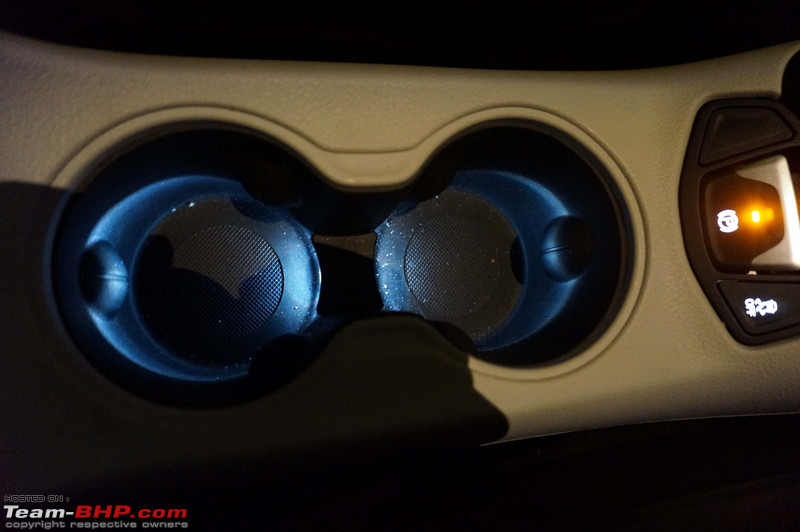 The center armrest is adequately sized and it can be adjusted forward as well (no adjustment for height). Its surface is soft and user-friendly. There is no way to lock it in the forward-most position though: 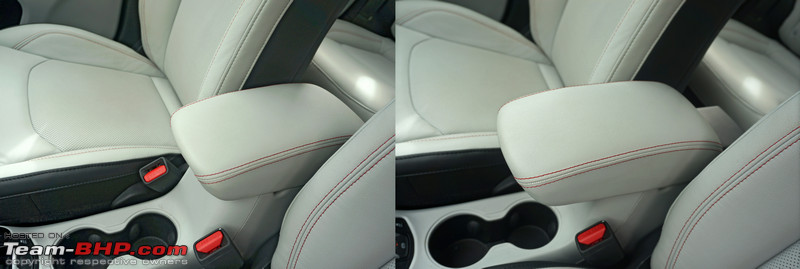 Storage space below the armrest is deep enough and can hold a 500 ml bottle easily. Before you ask, nope, no cooling or illumination here: 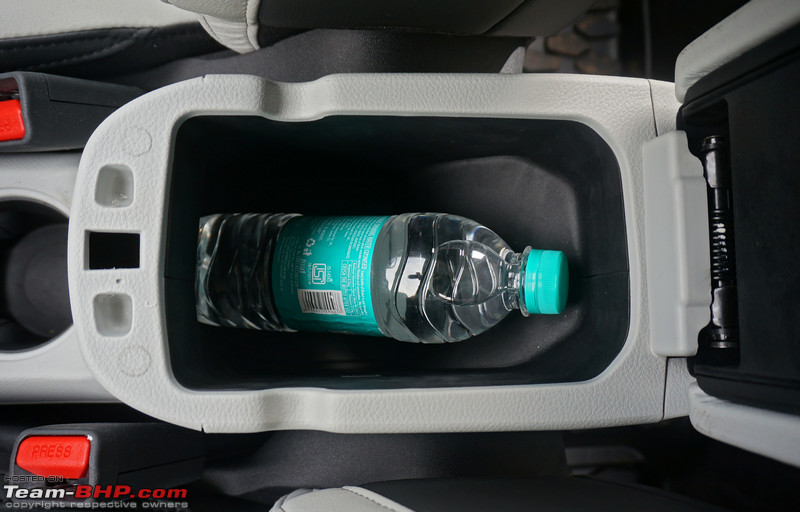 Dig deeper for more Easter eggs! This one says 'PROJECT'. The designers were clearly having fun: 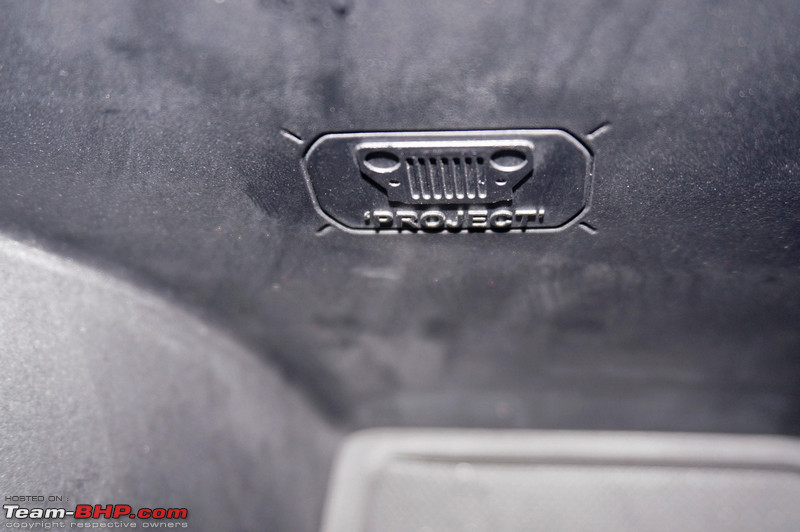 Dual-stage front airbags are standard: 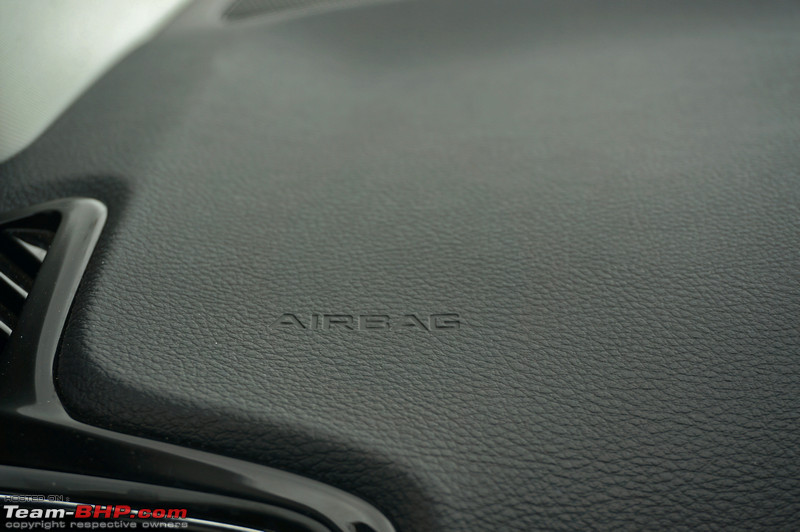 The dashboard runs out long from the windshield: 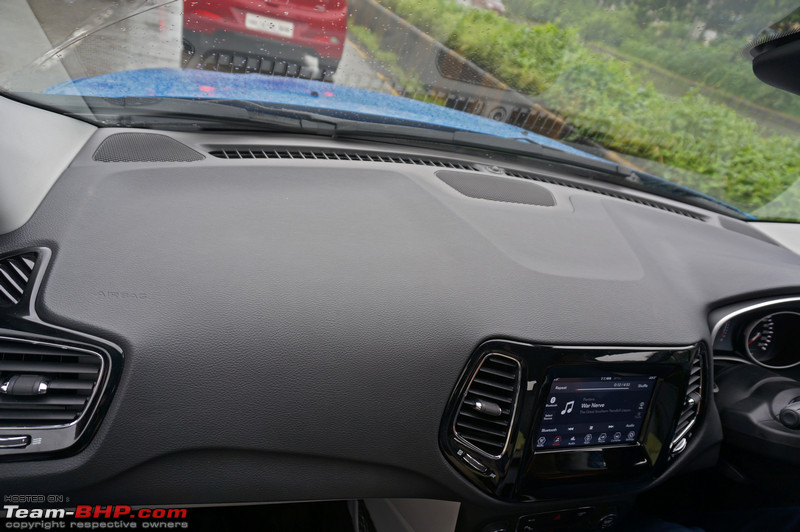 Solar sensor is placed on top: 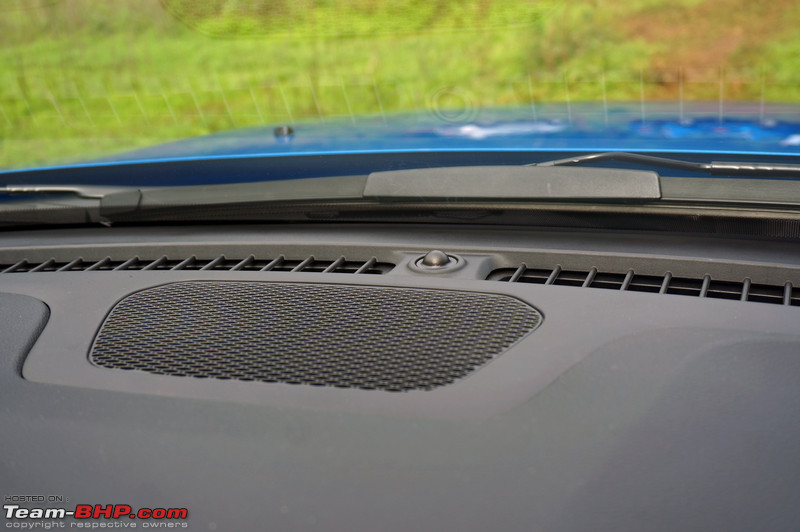 Even the front passenger gets a central locking button: 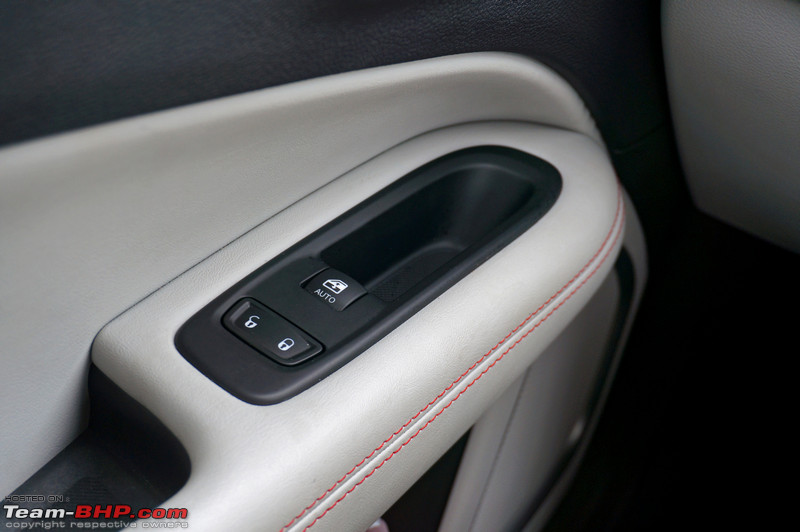 The glovebox isn't big, though it isn't tiny either. Strictly average. It has a soft opening action. Gets a light inside, but… 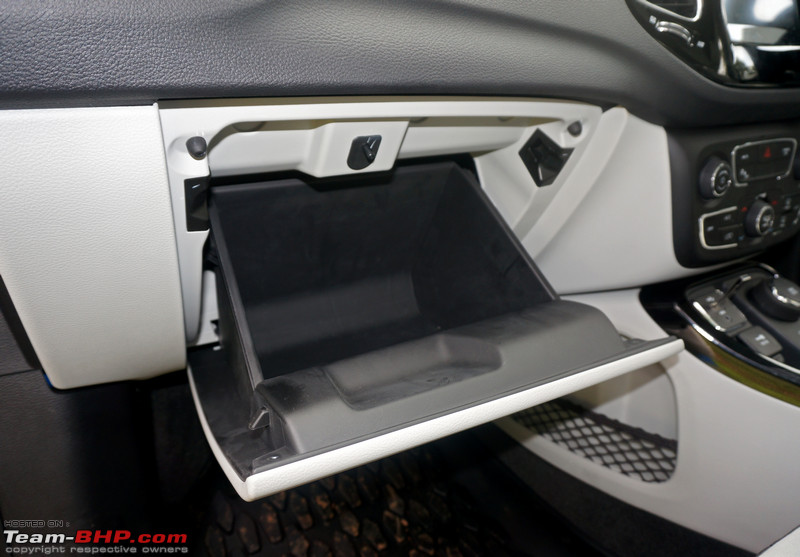 …the halogen bulb is exposed! You can easily reach in and remove the bulb. They should have just added a transparent plastic cover on it: 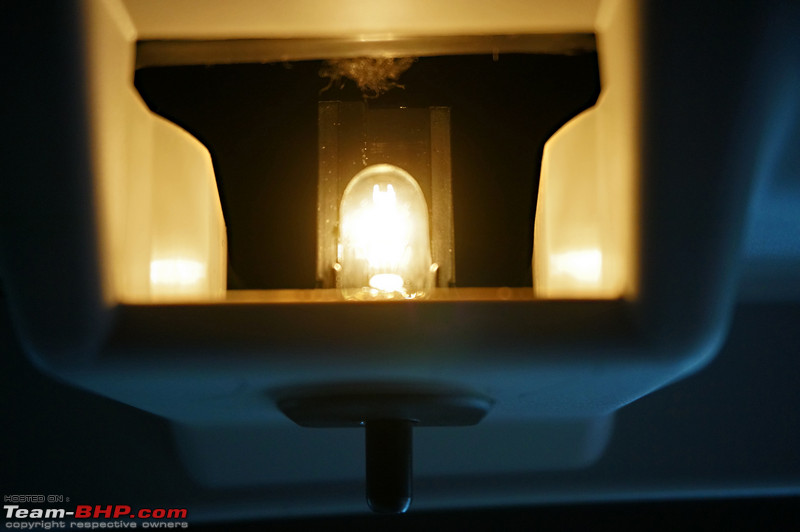 In the passenger-side footwell, you'll find this storage space with a flexible net. Useful to hold odd items. This one is a lot better than the Tucson's (reference image): 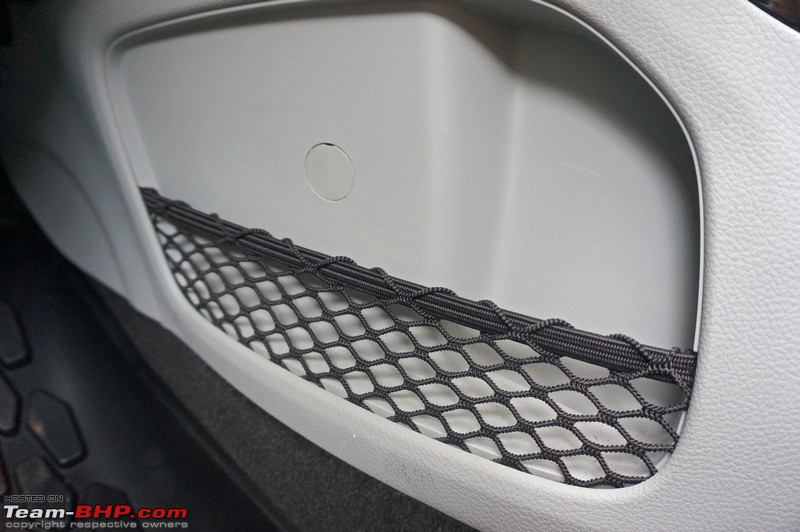 The roof console & individual map lights. Nicely designed lights, no? What seems like a Bluetooth mic in the center is actually a blank. The large empty area is occupied by sunroof controls on the international variant. Jeep should have really kitted the Indian Compass with a sunroof: 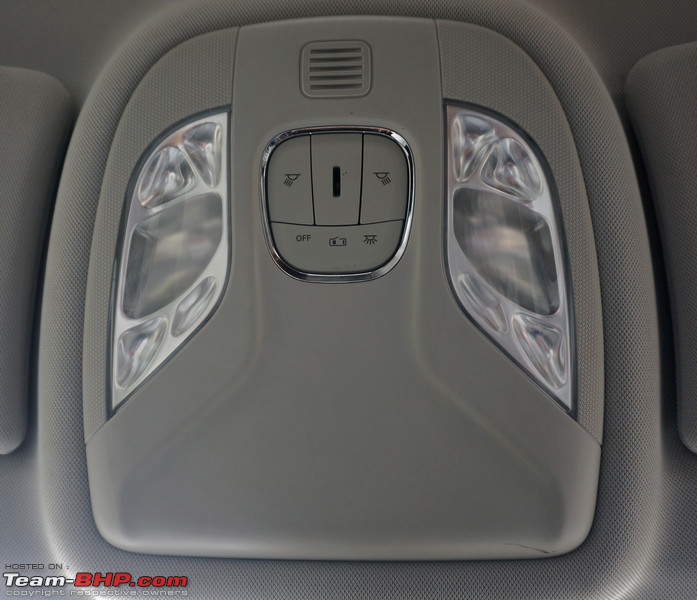 Check out the white ambient light from the center slit. It throws a faint light on the center console: 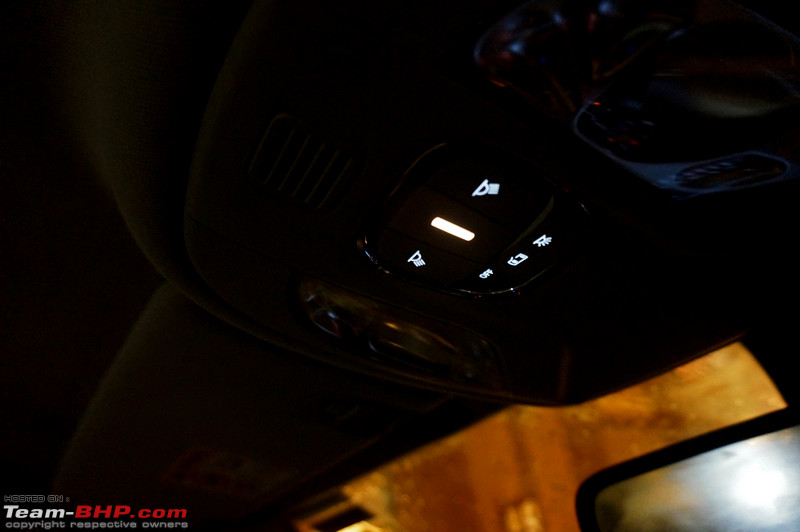 Both sunvisors get a vanity mirror. What's more, it can be extended by just pulling on the side, so that the desired area can be covered (say, the window area on the side). I preferred the extendable sunvisors of the Tucson over these (reference image). Simple reason being, while on the move in the Compass with the sunvisor in its extended position, you will notice a fair bit of movement towards the end: 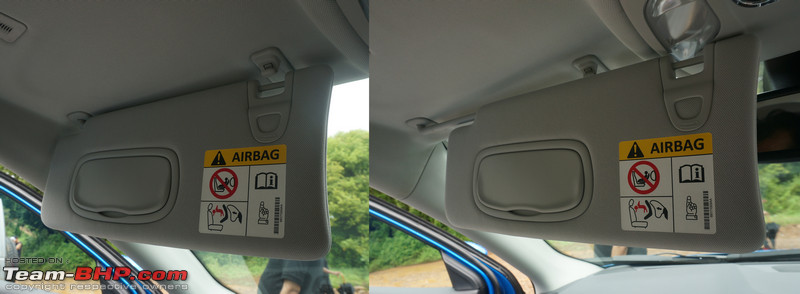 The vanity mirrors aren't illuminated. Even the Linea gets lights here! The white strips on the sides of the mirror have bulbs for illumination on the international variant. Don't miss the Bluetooth mic on the passenger side: 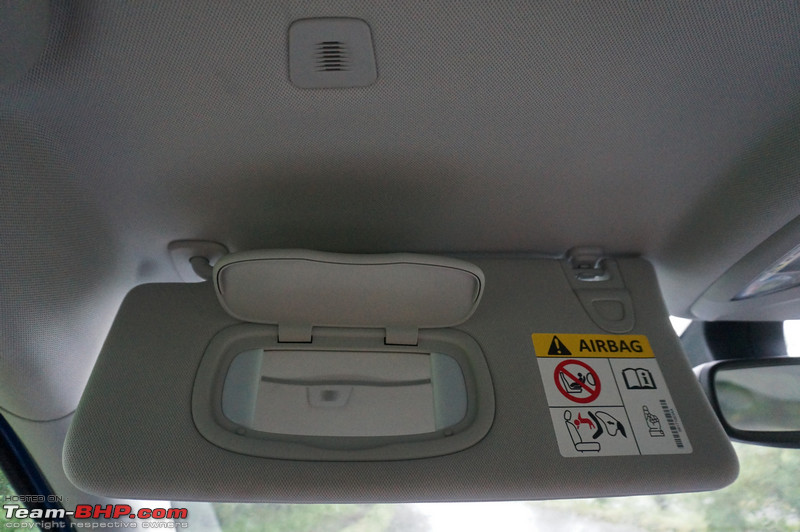 Both sunvisors get clips to tuck in those toll receipts & parking slips: 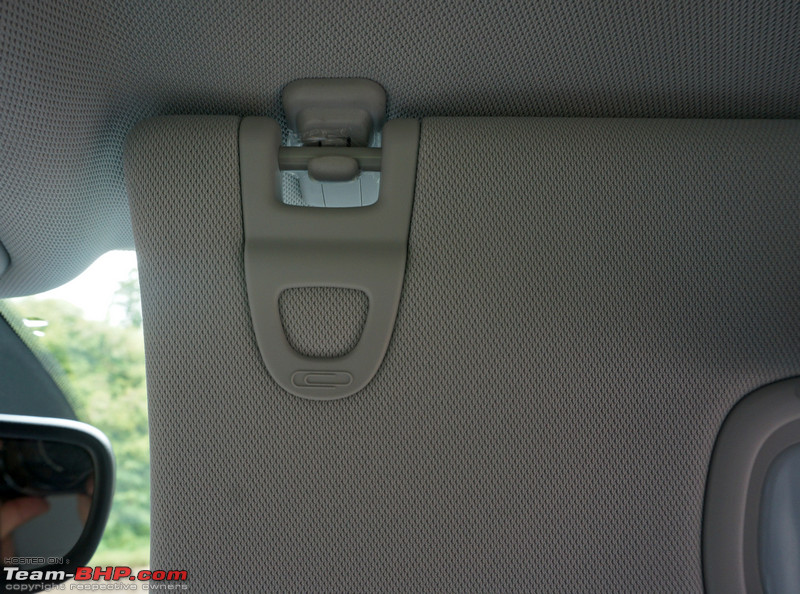 Last edited by Aditya : 18th September 2017 at 16:11. |
| |  (71)
Thanks (71)
Thanks
|
| The following 71 BHPians Thank Omkar for this useful post: | aadya, Aakarsh, akshay81, ampere, anjan_c2007, arun_josie, arvind71181, AutoIndian, avinash_clt, BlackPearl, blackwasp, carrazy, CrAzY dRiVeR, damager21, deetjohn, Dr.AD, DrANTO, Flyer, GKMahajan, GTO, hemanth.anand, hiren.mistry, HumbleBee, InControl, Jaggu, Karthik Chandra, kashyapz8055, kiren, layndrivr, Leoshashi, libranof1987, lovetorque, lurker, MSAneesh, Nohonking, NPV, paragsachania, petrolhead_neel, phoenixash, PraNeel, Puffdamgcdragon, r0nit7, R2D2, Rajeevraj, RavenAvi, redracham, regenitin, ritzy, rohansachar, rshanker, S.MJet, samabhi, sayakc, SchumiFan, sharanvenu, Simat, SnS_12, SS-Traveller, suhaas307, sunny29584, theexperthand, theredliner, Turbanator, uday.ere, Varun_HexaGuy, vb-saan, vibbs, Vid6639, Wildy, X_T_A Rose, yosbert |
| | #5 |
| Team-BHP Support  Join Date: Apr 2016 Location: Mumbai
Posts: 2,980
Thanked: 29,620 Times
| Interior - Rear The rear doors also open & close with a three-stage action. And they open w-i-d-e (almost perpendicular). Getting in and out of the rear seats isn't much of an issue as the seats are at an appropriate height. You just slide onto them. This pic shows the sheer thickness of the doors:  The gap between the B-pillar and seat base is adequate for you to tuck your legs inside. Although the door sill & adjoining panels are wide and the elderly will have to make some effort. The eagle-eyed among you will have already registered that the rear of our test car doesn't have those silver scuff plates seen at the front:  Rear doors carry forward the same black & white theme as the front. The door armrest extends all the way to the end. These door pockets are made for 500 ml bottles as well (not 1L). A major change on the rear doors is that the top black area gets hard plastic (it's soft-touch at the front):  Yikes! Remember the classy silver border we liked on the front speakers? It's not there at the back:  Look inside the door pocket of the left rear door for more meat! This one has the letter 'P' along with the legendary 7-slat icon:  If you wanted SUV-like space, forget about it. If you wanted C2-sedan-like space, forget about it. Room here is comparable to the premium hatchbacks. The rear bench itself is quite comfortable as the seats are nicely contoured. They provide satisfactory back support, while the seatbase is long which helps under-thigh support. But the width is enough for 2 adults (and a child) only, not 3. This makes the Compass a 4+1 seater. One thing to note is that the Indian Compass gets 2 headrests instead of 3 on the international variant. This shouldn't have been the case; even the Creta gets 3 headrests on some variants:  The headrests have 3 levels of height adjustment - bottom, middle, top. These are soft and the shape is taller than is usually the case:  Lap belt for middle passenger - should have had a 3-pointer just like the international variant. Do note the raised bolstering on the seatbase for the side passengers. This is good for those on the side, but not the unlucky dude in the middle:  Legroom is sufficient (unlike the width). No owner will complain:  A look at the maximum & minimum legroom. Also check out the seatback pockets provided on both front seats:  Blackwasp (6 feet tall) can easily sit behind his own driving position (image on the left). Even with the front seat all the way back for someone well over 6 feet, he could still fit in, although the seat base did touch his shin. Notice that the seatback isn't scooped out:  With the driver seat adjusted to my driving position (I'm 5'10"), I was comfortable with the legroom. No complaints in the headroom area either. The long seatbase provides good under-thigh support. However, the backrest angle was a bit too upright for my liking. Owners will complain, especially those who prefer a relaxed posture. What's more is that the rear seat isn't adjustable for recline. The Tiguan and Tucson have this feature (Tucson has over 18 steps to adjust the recline angle - (reference image). The headrest is at the highest point which is perfect for my height; its at the same level as my eyes which prevents whiplash injury. On the other hand, Vid6639 who is 6 feet tall found the bottom corner edge of the headrest piercing the base of his neck. An ergonomic flaw for super tall folk. Rear headrests cannot (and shouldn't) be removed:  The center armrest is w-i-d-e. Two healthy people can easily rest their arms here, without their elbows brushing against one another's. It has two cup-holders with rubber extrusions to hold cups in place. Also gets a vertical slat in between to place a smartphone!  The center armrest's height was perfect for me (5'10"), but shorter folk might find it to be slightly high. Note the rising window line which might also annoy our shorter friends:  Another addition to the wide door sills. See how the door sill is sloping gradually into the footwell, can make ingress tricky. It also reduces the carpet area which is why the rear floor mats are small (no Jeep branding like the front mats either):  If you try to really extend your feet under the front seat, you'll see that the floor rises & your feet will meet the A/C vents. You can place your feet at an angle on top of these, if you so wish:  Large headrests obstruct frontward visibility big time:  Glass area is adequate. The white interiors help in keeping the cabin airy, and the rear quarter-glass lets light in too. The base variant with its all-black interiors will suffer a more claustrophobic feel:  Yes, the rear windows roll all the way in:  A look at the quarter glass in between the C and D pillars. Rear seatbelts are mounted on the D-pillar:  ISOFIX for child seats - one on each side of the rear seat:  The parcel tray runs long and has a well-contoured rear area. It completely conceals all your boot luggage, thus offering protection from prying eyes:  Like the front ones, the rear grab handles have a soft closing action. In addition, they get a lamp (push to activate). Both grab handles get foldable coat hooks:  A look at the rear air vents. Air flow can be reduced by sliding the middle hold clip down (can't shut air flow completely though). A USB port has been provided for the smartphones of rear passengers. You'll be pleasantly surprised to know this isn't just a charging port; it is also connected to the infotainment system (including Android Auto integration):  The floor hump isn't as tall as the Tucson's, but it is on the wider side. 5th adult isn't welcome anyway. The kid who is can place his feet on it. In this picture, we'll also comment on the floor carpeting which felt dense. We noticed that it absorbed water well. Black is the best colour for flooring in India:  The tailgate requires some effort to open (the initial pull). The indicators blink twice when opening:  Made-in-USA gas struts are sourced from MAN. A rare car in which we see American-made parts:  Attention to detail - the rear washer pipe gets a 90-degree joint to prevent it from tearing at the bend:  Tailgate gets multiple rubber stoppers for a softer closing action + preventing rattles. Also note that the inside cladding stretches to the sides of the tailgate (some cars only cover the center / main area):  The tailgate cladding bears a familiar Jeep symbol in the center  : : Keep looking and you'll find Nessie (The Loch Ness Monster)! It has been placed on the right side of the rear windshield. Trivia - the Renegade gets a gorilla on the other side of the windshield:  Yet another Easter egg - we're losing count! This one has the number '5' on it:  Boot space is 438 liters which is more than the Creta (402 liters), but less than the Tucson (530 liters) and even the Duster (475 liters). Forget the on-paper rating, this boot is strictly average in size. It doesn't feel that big. The loading lip is high and you will have to 'lift-up' your luggage to place inside:  Parcel tray removal instructions are given at the center. Pictures show the rear bench with three headrests (i.e. international variant):  The big mounts on which the parcel tray rests can be removed, so that there is no obstruction in the cargo area:  The boot is illuminated by lights on both sides. A circular blank has been placed on the left side below the lamp. On the international variant, a 12v power outlet is provided here:  Warning triangle gets 2 straps to hold it in place, along with velcro strips at the bottom to stick it firmly onto the boot floor:  Intrusions in the cargo area from the wheel arches are prominent. The cargo floor can be adjusted to 2 heights on our AWD presser (some international variants get 3). Here is the floor with the spare wheel below...  ...and without. Frankly, this is useless as who would ever prefer to drive without a spare wheel? Maybe it makes sense on an international variant coming with a super-thin space saver spare:  Here is the difference in height of the two cargo floor levels:  Pull this latch on the rear seats to fold them down: 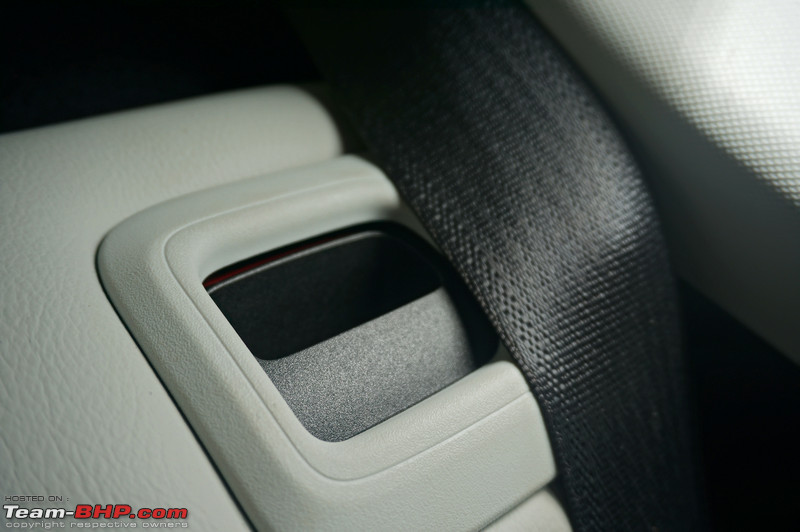 Rear seats get a 60:40 split:  They fold down to increase boot space to 770 liters when needed (they don't fold fully flat though):  Even with the rear headrest at its highest position and the front seat fully pushed back, you can still fold down the rear seats. The headrest won't hamper with the folding. This isn't the case with so many cars:  Push on the bottom area to bring up the handle & lift up the cargo floor:  The spare wheel is a steel rim. That sucks in such a pricey car. Since it's full-size on our AWD test car, we don't understand the 120 km/h speed limit sticker? Do note that the Limited 4x2 showroom demos have a thinner 215/65 R16 spare. There is no way to lock the cargo floor up while removing the spare wheel:  The cargo floor is thick and made of good quality material. Looks like the engineers won most of the arguments with the bean counters:  Clear instructions to remove the lock of the spare wheel:  Remove the spare and you'll see a scissor jack placed neatly below. Well-packaged:  Other tools are systematically placed around the wheel well. This is the towing eye:  What you see on the top right is a plastic funnel for the capless fuel filler system. In case you need to refuel using a fuel can, insert this funnel in the capless entry to hold the flap door open. You can then pour the fuel in via this funnel. Placed beside the funnel is a wrench to operate the scissor jack:  There's a deep cubbyhole on the right side of the boot floor. A 5.5" smartphone placed for reference of depth. It is removable:  On the left, you'll find a shallow but wide cubbyhole. Look closely...  ...for one more! This gets the number '1' printed below:  On top, you'll find this fuse symbol. Though, if you remove the cubby hole...  ...there's no fuse box below (international variant gets one here related to the electric tailgate's functions):  On the right side is the emergency fuel flap release:  Blue handle attached to a string inside. Pull the handle to unlock the fuel flap:  The D-pillar has this fin-structured design. Nope, these aren't air vents:  These foldable cargo tie-down hooks are present on all 4 corners of the boot:  The roof is slightly scooped over the rear seats, presumably to increase headroom:  A flaw in quality check - The roof lining wasn't properly sealed to the D-pillar on the left side (it was perfect on the right side):  Tether hooks, one on each side of the rear seat:  Last edited by GTO : 28th August 2017 at 23:23. |
| |  (76)
Thanks (76)
Thanks
|
| The following 76 BHPians Thank Omkar for this useful post: | Akshay1234, akshay81, ampere, aniket17, anjan_c2007, Arjun Reddy, arun_josie, arvind71181, Ashi_Kochi, AutoIndian, avinash_clt, BlackPearl, blackwasp, CarguyNish, carrazy, CrAzY dRiVeR, Crazy_cars_guy, damager21, daretodream, darklord, deetjohn, Divya Sharan, Dr.AD, Flyer, GKMahajan, GTO, hemanth.anand, HumbleBee, InControl, Jaggu, Karthik Chandra, kashyapz8055, layndrivr, Leoshashi, libranof1987, lovetorque, mpksuhas, MSAneesh, Nohonking, pankaj_sachdeva, PraNeel, predatorwheelz, procrj, psispace, r0nit7, R2D2, Rajeevraj, RavenAvi, redracham, regenitin, ritzy, rohansachar, rshanker, S.MJet, sayakc, SchumiFan, scopriobharath, sdp1975, sharanvenu, Simat, skchettry, spdfreak, SS-Traveller, sunny29584, The Rationalist, theexperthand, theredliner, TorqueyTechie, Turbanator, uday.ere, vb-saan, veyron_head, Vid6639, Wildy, X_T_A Rose, yosbert |
| | #6 |
| Team-BHP Support  Join Date: Apr 2016 Location: Mumbai
Posts: 2,980
Thanked: 29,620 Times
| In-Car Entertainment The head-unit has the "Uconnect" interface which is common across the Jeep brand. The Uconnect system on a particular vehicle is actually named according to the corresponding screen size. Thus, internationally there are 4 versions - Uconnect 5.0, Uconnect 7.0, Uconnect 8.4 and Uconnect 8.4 NAV. In the US, the Limited variant of the Compass gets a Uconnect 8.4 as standard (screen size is 8.4 inches). The Limited trim on the Indian Compass has a Uconnect 7.0 interface (a 7-inch screen). This is way too small at this price point - even sub-10 lakh hatchbacks today are getting 7" screens!! Lesser variants of the Compass get an even smaller Uconnect 5.0 system (check how weird it looks in champ27's post)! In India, only the Grand Cherokee Summit gets the Uconnect 8.4 interface with navigation support. A point worth mentioning is that, since the international Compass gets a larger 8.4" touchscreen, the extra space left out does look out of place. Moreover, finished in piano black, the glare can get distracting at times. The connectivity to the head-unit is through Bluetooth, USB and AUX. The system also supports Android Auto & Apple CarPlay  . The base Sport variant gets 4 speakers, while the mid & top variants get 6 speakers. Sound quality is good, and the distortion is close to none when the music is played loud. Audio quality isn't something extraordinary though (like in the new Tatas) - it does the job and owners won't be complaining in this department. The system doesn't get an inbuilt navigation system; it'll depend on your smartphone for that (just as well as nearly all of us prefer Google Maps to OEM navigation systems). . The base Sport variant gets 4 speakers, while the mid & top variants get 6 speakers. Sound quality is good, and the distortion is close to none when the music is played loud. Audio quality isn't something extraordinary though (like in the new Tatas) - it does the job and owners won't be complaining in this department. The system doesn't get an inbuilt navigation system; it'll depend on your smartphone for that (just as well as nearly all of us prefer Google Maps to OEM navigation systems). The touchscreen is responsive enough for the basic functions, although it lags at times when you keep on using it for a while or access deeper functions. There were instances when the whole system froze out of the blue and we had to reboot the system. The reversing camera's display is satisfactory, even during the day. The Calibri-type font is simple and the options are clearly visible. There is some amount of glare on the screen when directly under harsh sunlight, which makes it slightly difficult to read at such times. The 7-inch touchscreen looks a size too small. Is easily operable from the driver's seat, despite being slightly tilted towards the front passenger (LHD layout):  4 speakers are housed in the doors (only front ones get this sweet silver border)…  …with two on the top corners of the dashboard:  Jeep logo welcomes you on start-up:  Standalone Compass looks swell. Don't miss the beehive pattern in the background:  The bottom-most icons remain fixed when you are moving across the different screens. You can also rearrange them as per your preferences (except 'apps' which stays in the middle):  The radio screen is well laid out with almost all the options displayed for easy access:  The media screen shows the current song at the center, with the current source on the left. You can play a preset playlist from your phone and get the options of shuffle / repeat for that playlist (buttons on top):  Click on 'Info' for all the track information. Unique. This includes the album, composer as well as genre. An excellent feature which is rarely seen. 'Tracks' will list the songs of the playlist:  On the source screen, you'll see the "USB 2" option for the rear USB port. It even supports Android Auto and Apple CarPlay!  For balance & fade, drag the speaker icon to the desired location:  The equalizer has 9 levels of adjustment on the positive and negative sides:  Speed sensitive volume has 3 levels of adjustment. Level 3 is way too sensitive - it was moving the volume up & down significantly, even at city commuting speeds!  Loudness feature basically enhances the dynamic range at low volume:  You can pair up to 8 smartphones to this system. Lots of options, yet logically laid out & easy to get the hang of. See the 'Empty' slots on top? You can set your favourite contacts for speed dial. Transferring a call to your phone (for privacy) is done instantly. ICE has a 'do not disturb' mode if you don't want to be distracted by calls while driving, with an option of sending a text message to the caller:  Upon receiving an SMS, you can have it read out, ignored or directly call the sender. You can also reply…  …with a new message using the voice recognition system, or select a simple predefined SMS (Yes, No, Okay, Can't talk right now etc.):  Can set up the climate control from here too. The climate control screen appears whenever you make any changes using the physical knobs / buttons on the center fascia (you can add a shortcut to it on the base menu). Two options here which aren't present on the center fascia - 'Max A/C' button (air-con on full blast - useful when you return to a hot parked car) and 'Sync' (same temperature in both zones). Notice the outside temperature being displayed on top:  Connect your iPhone via Bluetooth and you get the Siri voice assistant:  When connected via USB, the Apple CarPlay display will pop up. Note that the display doesn't cover the entire screen (Android Auto does). In this era of smartphones, we just love this level of integration & hope that Android Auto + Apple CarPlay are made standard on all cars:  The media display for CarPlay (including the iOS home button on the bottom right). One very useful feature that Apple CarPlay still doesn't support is navigation! You'll have to use Google Maps on your phone's display:  Android Auto display occupies the screen completely. Shown here is the home screen:  The media display of Android Auto:  Google Maps too  . We prefer this over any OEM navigation system. Google Maps on the stock head-unit is the best of both worlds! . We prefer this over any OEM navigation system. Google Maps on the stock head-unit is the best of both worlds! You can always go back to the Uconnect interface by pressing the icon on the bottom right:  To revert to Android Auto, press the 'Android' button now appearing on the options below. You can see here that we've connected via the rear USB port:  Let's take a look at the settings within. Display mode can be set to Auto or manual. Upon selecting manual, you can adjust the brightness levels for headlights "On" (nighttime) and "Off" (daytime):  Allows you to set imperial or metric separately for the different options (distance, fuel consumption etc.). Note that the Uconnect system doesn't show vehicle information here (it's only displayed on the MID):  The voice recognition options:  Self-explanatory settings for the parking sensors & reversing camera:  'Auto Park Brake' will automatically apply the parking brake every time you park:  Different options for the doors & locks can be selected. You can turn off the flashing lights & horn confirmation while locking too:  How long the headlamps remain on after you lock the car (i.e. follow-me-home feature) can be tuned. You can also choose to keep the ICE operable for up to 20 minutes after the ignition is turned off. Additionally, it can be set to turn off when the driver's door is opened (after the ignition has been switched off):  "AutoPlay" will automatically start playing music when a device is connected via USB:  The reversing camera has a good display and the guidelines are adaptive (i.e. they move with steering input). Engage reverse and the MID also shows you the parking display. When you get too close to an obstacle, the white arc (on the MID) starts flashing, accompanied by a continuous beep:  Press the 'Screen Off' button on the center console & the display goes off, but the screen is still backlit!!! This is how it looks at night with the backlight still on. Incredibly silly - in other cars, 'screen off' means the screen is OFF. If you want to switch off this backlight, you'll have to turn the whole system off via the volume knob below (but no music then):  The Uconnect system is quite user-friendly and easy to understand. Although, during the time we had the car, the system froze on multiple occasions. It wasn't a handset issue as it hung on different phones and once, even when no phone was connected. GTO adds that the system worked flawlessly when connected to his android phone (S6 Edge) - it didn't hang up at all over the two days he drove the Compass:  Last edited by GTO : 28th August 2017 at 10:55. |
| |  (58)
Thanks (58)
Thanks
|
| The following 58 BHPians Thank Omkar for this useful post: | akshay81, anjan_c2007, Arjun Reddy, arun_josie, avinash_clt, BlackPearl, blackwasp, CAPTAIN REX, CarguyNish, carrazy, damager21, deetjohn, djay434, Dr.AD, Flyer, ganeshb, GKMahajan, GTO, hemanth.anand, HumbleBee, igp_79, Jaggu, kashyapz8055, layndrivr, libranof1987, lovetorque, Mighty_Lothar, MSAneesh, Nohonking, pankaj_sachdeva, PraNeel, procrj, R2D2, RavenAvi, redracham, regenitin, ritzy, rohansachar, rshanker, S.MJet, sayakc, SchumiFan, scopriobharath, Simat, skchettry, SS-Traveller, sunny29584, sups, theexperthand, theredliner, timuseravan, turbospooler, uday.ere, vibbs, Vid6639, vinodvayyat, X_T_A Rose, yosbert |
| | #7 |
| Team-BHP Support  Join Date: Apr 2016 Location: Mumbai
Posts: 2,980
Thanked: 29,620 Times
| Driving the 2.0L Diesel MT The Compass has been launched with a 2.0L Multijet II diesel engine mated to a 6-speed manual transmission (AT to follow later). Churns out 171 BHP @ 3,750 rpm and 350 Nm @ 1,750 - 2,500 rpm. This Ranjangaon-assembled engine is a highlight of the Compass and one of the main reasons you'd buy the SUV:  The 2.0L 4-cylinder diesel has an aluminium cylinder head with 2 camshafts. The double overhead camshafts operate 4 valves per cylinder. It is equipped with a variable geometry turbocharger to aid low end torque. A balancer shaft has also been added to reduce engine vibrations (rare on 4-cylinders). This Fiat engine which is currently seen only on the Compass is expected to power upcoming Tata SUVs too. Reports suggest that Tata will be getting 70,000 units for its new Land Rover platform-based SUVs (related thread). The Compass base (Sport) variant has a kerb weight of 1,537 kg. Thus, the power-to-weight ratio is 111 BHP/Ton, while the torque-to-weight ratio is 228 Nm/Ton. The AWD variant however weighs over 100 kilos more at 1,641 kg. This brings down its power-to-weight ratio to 104 BHP/Ton and torque-to-weight to 213 Nm/Ton. These figures are better than the lightweight Creta, the XUV500 and even the recently launched Tiguan (VW gave it only 141 BHP). Hyundai hasn't shared the exact kerb weight of the India-spec Tucson, yet going by international data, it might hold an advantage. The Compass idles at 950 rpm. There is slight clatter from the diesel (more than Tucson though), while the vibrations are well controlled. On the move, NVH is simply fantastic. Slot the gear lever into 1st, let go of the clutch and the SUV starts to crawl at ~8 km/h. Even if you are climbing an incline, the engine will maintain the same speed. Big turbo-diesels seldom have lag and the Compass is no different. Driveability is very good & the engine is city-friendly. Crossing speed breakers in 2nd gear? No problem, there isn't a need to downshift to 1st. In fact, with slight clutch slipping, the Compass can even move away from a standstill in 2nd. While commuting in urban conditions, the engine doesn't feel lugged if spinning at 1,400 - 1,500 revs. This is below the turbo range, yet the big diesel has enough low-end torque to keep the SUV moving in traffic. You won't be downshifting unnecessarily at all. What also makes the Compass practical in urban conditions is its higher seating position & compact size. It didn't feel burly in Mumbai traffic - an advantage as not everyone wants to pilot a large XUV500 or Hexa in tight city confines. Overall NVH is impressive, with the Jeep keeping unwanted noises at low levels on the move. What you'll further appreciate is the smooth gearshift (previously unseen in an FCA India product) and soft clutch. Neither require much effort to use. The gearbox is light to operate, with even reverse gear (located above 1st) slotting in super easy. It's not all perfect though. For one, the clutch pedal's and dead pedal's resting points are too high (this will annoy tall drivers), and the light clutch has an unnecessarily long travel range. It should have been shorter. Then, 1st gear is shorter than expected, presumably to help it offroad as the AWD doesn't get a low range transfer case. This means you'll be shifting to 2nd earlier than in other SUVs. Lastly, when you're new to the Compass, you might stall it in 2nd. There is a noticeable gap between 1st & 2nd gears (can catch you out on steep inclines) and you need to give it a little more throttle + leave the clutch a little more gradually. Of course, within a couple of km, you'll get used to this. If you liked the Compass in the city, you'll love it on the open road. The turbo kicks in at ~1,800 rpm and if you listen carefully, you'll hear the turbo singing. There is no mad rush or surge when the turbo is spooling - instead, power delivery is linear in nature. Performance is strong - the 171 horses, solid suspension & nice EPS make the Compass a delight to drive. It feels like a 'tight European package' and can seriously munch miles. The engine offers enjoyable performance, and the mid-range is punchy too for quick overtakes. Don't take the revvs too high though - while it revvs to ~5,000 rpm, the diesel isn't happy post 4,000. You'll hear that typical Fiat diesel drone and well, the 2.0L doesn't have much to offer near the redline anyway. Despite the compact size, the Compass has long legs and is a capable long-distance cruiser. Cruising in 6th gear, 100 km/h is seen at 1,750 rpm while 120 km/h is just above 2,000 rpm. The SUV can do triple digit speeds all day long...and very silently at that! Suggestion = if cruising at 100 km/h on the expressway with a lot of traffic, use 5th as it keeps the engine in turbo zone (2,100 rpm), thus making for quicker overtaking than in 6th. The ball-shaped gear lever is sweet to hold - a welcome change from the ubiquitous rectangular shifters seen on most cars. This 6-speed gearbox is very light + smooth to operate. There aren't any jerks or vibrations felt on it either. You have to lift the dog collar to engage reverse (up and ahead of 1st). Surprisingly, reverse gear is effortless to engage, unlike some other cars where you have to really push it hard beyond 1st. As if to match it, the clutch pedal is soft to use. On the negative side, it has a long throw and its resting point (along with the dead pedal's) is too high. Jeep has done a commendable job in the NVH department. The triple-seal doors and ample insulation everywhere help to isolate the cabin from undesired sounds. At regular revs, engine noise is well-controlled, although the Tucson is even quieter. Owners will enjoy the refinement at lower revs within the city. The diesel does get intrusive beyond 3,500 rpm, becoming noisy as the needle approaches 4,000 rpm (engine drone here gets obvious). Wind noise is very less even when cruising at 110-120 km/h. Tyre noise however does start to creep in. No owner will complain about vibrations; however, those moving from a petrol car will notice the mild shudder on start-up. The Compass has a 60 litre fuel tank which is between the Creta (55L) and Tucson (62L) - just like the car's positioning, we might add! The ARAI figure is 17.1 km/l for the 4x2 variant & 16.3 km/l for the 4x4 variant. Ride & Handling The Jeep Compass is equipped with a MacPherson strut suspension at the front and a multi-link suspension at the rear. The car comes equipped with Koni FSD dampers which, in the early days of Team-BHP, were the modification of choice for enthusiasts (sample thread). Frequency Selective Damping provides variable damping that adjusts to road undulations. How is this different from normal dampers? In standard shock absorbers, oil flows through a piston placed inside the damper casing which defines the damping characteristics. What Koni has done is added a separate valve which is able to control a parallel oil flow right next to the one which is already passing through the piston. The added parallel oil flow is controlled by the valve and basically increases the damping force in a linear way, with respect to the time that the piston is moving in one direction. Too complicated? The FSD is a hydraulic amplifier that delays the pressure build up. This allows that extra option for tuning to a particular vehicle's requirements. One thing to note is that the FSD is integrated with the existing hydraulic valve system inside the damper. Thus, there are no extra cables or sensors required for its operation. FSD is probably the simplest and most cost-effective way to change damper characteristics according to road conditions. Low speed ride quality is liveable & compliant enough for daily use, but that's it. The suspension isn't plush at 20 - 30 km/h & you will always be aware of the kind of road you're driving on. Owners won't be complaining on typically urban roads. However, big potholes come in strong, while broken roads see lateral movement (side-to-side rocking) in the cabin which can throw occupants around. You'll feel the firmness of the suspension at slow speeds; here, the urban ride quality of the Duster is in a different league altogether! That said, the lower variant with its 16" rims should offer a more damped low speed ride (our test car had 17" rims). As the speedometer climbs, ride quality progressively improves. At highway speeds, small bumps and potholes are handled well. At these speeds, you won't even be slowing down for moderately broken patches. The SUV's composure on the expressway is terrific and even rear seat passengers will be kept comfortable. She rides flat, with none of that unnecessary vertical movement on undulating roads from the rear (like the Creta). It's like most European cars in that sense. Liveable in the city (but not soft & cushy), and excellent on the highway. By SUV standards, the Compass has sorted handling characteristics. Grip levels are very good as a result of which, you will have fun on the open road. Its dynamics certainly match the 2.0L diesel's muscle. The car doesn't unsettle easily even when you are pushing her a bit. Some body roll is of course there, yet it's not excessive or unnerving. But you will feel the sheer weight of the SUV while cornering. Straight-line stability is rock solid; you'll be doing silly speeds without even realising it. GTO took it out on the highway when it was raining and still had fun on wet roads! What makes the experience nicer is the steering which is darn good for an EPS. It certainly doesn't feel lifeless and is reasonably sharp. While the EPS is light enough at city speeds, it does weigh up on the highway (not heavy like a pure hydraulic though). Lots of power going to the front wheels means you will experience torque steer. Say the SUV is cruising calmly in 3rd gear, and you suddenly floor the accelerator...you will feel the torque steer. The driver has to hold the steering wheel tight to keep the SUV in line. Finally, it's reassuring to know there is an army of electronics (ESP, rollover mitigation etc.) looking after you in case of an emergency manouveur. The laden ground clearance of the Compass is 155 mm. A slide at the presentation did show the '178 mm' figure which we can safely assume is the unladen GC. We aren't worried about the underbody scraping on Indian roads. That said, the low front wind deflector definitely will (link to image). Some BHPians commented that it was scraping even over tall speed breakers! At 5.65 metres, the turning radius is too big for a compact SUV (Creta & Duster = 5.2m). Even the Safari Storme (5.4m) has a smaller turning circle than the Compass!! Net net, you'll be making more 3-point U-turns than necessary in this Jeep. The Compass is equipped with all-wheel disc brakes. In one word, the braking capability is 'splendid'. There is a progressive feel to the brakes and the overall stopping power is confidence inspiring. We simulated emergency braking conditions twice and the Compass stopped right on the dot, with no drama at all. Engine bay is well laid out and all 4 sides get a black plastic cover (blue panels hardly visible). Sadly, the h-e-a-v-y bonnet doesn't get hydraulic struts to lift it up! You'll have to use both your hands for that:  Diesel filter is placed on the top-left:  Bosch ECU uniquely located behind the engine (usually seen on the right, somewhere around the battery). Vid6639 isn't happy. He says "I didn't like the position due to heat. I know ECUs are sealed with heat sinks and I test such components inside the ECU at 125-140C, but I also know they work best at room temperature (or cooler)":  We earlier pointed out parts made in the USA. There are some sourced from Germany too. Pipe coming from the air filter marks the direction of air flow:  The car's power distribution center (fuse box) is in the top right. There's also a yellow fuse clip placed neatly behind the box (I put it on top for this picture):  An insulation sheet on the bonnet...  ...and the firewall:  The Compass gets a smart capless fuel filler - imagine the expression of the fuel attendant  ! The only place you'll find the 'diesel" badge is on the mouth of the opening and... ! The only place you'll find the 'diesel" badge is on the mouth of the opening and... ...this sticker with instructions. Note the recommended 10-second delay after filling her up:  Sweet, round gear knob wears a brushed silver finish:  Gearshift suggesting tool will be appreciated by some newbies:  Last edited by GTO : 27th August 2017 at 13:12. |
| |  (76)
Thanks (76)
Thanks
|
| The following 76 BHPians Thank Omkar for this useful post: | Aficionados, akshay81, aniket17, anjan_c2007, Arjun Reddy, arun_josie, arvind71181, AutoIndian, aviat18, avinash_clt, BlackPearl, blackwasp, CAPTAIN REX, CarguyNish, carrazy, cool_dube, CrAzY dRiVeR, darklord, deetjohn, Dr.AD, Flyer, Gaboonviper04, GKMahajan, GTO, haisaikat, hemanth.anand, hiren.mistry, HumbleBee, igp_79, InControl, Jaggu, kashyapz8055, Kols, layndrivr, Leoshashi, libranof1987, lipaul, lovetorque, Mighty_Lothar, mnvvishwa, MSAneesh, Nohonking, pankaj_sachdeva, phoenixash, PraNeel, predatorwheelz, procrj, R2D2, ramnaresh_2000, RavenAvi, regenitin, rohansachar, rshanker, Rshreyansh, S.MJet, sayakc, SchumiFan, scopriobharath, shipnil, Simat, skchettry, SnS_12, sourabhzen, sunny29584, swiftnfurious, Teesh@BHP, theexperthand, theredliner, timuseravan, uday.ere, vb-saan, vibbs, Vid6639, Vik0728, X_T_A Rose, yosbert |
| | #8 |
| Team-BHP Support  | Jeep Compass Diesel AT Review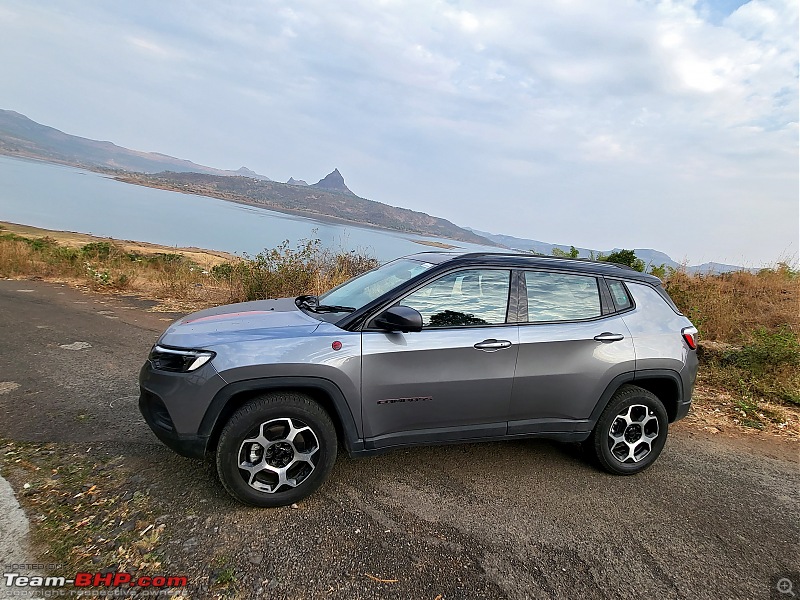 • For the long Holi weekend, the family made a plan to go to Pawna. It was a big gang with cousins and all. What better opportunity to drive the Compass Diesel AT, which I have been keen to experience? This 400-km round trip covers all kinds of terrain, so it would be fun.  • TL;DR = I’ll give the Diesel AT combination a 7 / 10 rating, deducting 1.5 points for the occasional slow response times & confused nature, and 1.5 points for not having paddle shifters or a Sport mode. The gearbox is smooth & easy to live with. If you're a calm driver or even one who pushes the car at 7/10ths, you'll be fine. I must mention the Diesel AT is not dimwitted or painful like the Compass Petrol DCT which I would give a 4 / 10 rating. • Regular people won’t have any issue with the AT gearbox at all. Even everyday enthusiasts will be fine with the Diesel AT. Diehard Team-BHPians who observe each and every gearshift and torque curves etc. will find the gearbox to be lacking, but only when they are driving h-a-r-d. As an example, on the expressway, it was still okay, but when I was flying down the Lonavala ghat, when I needed the gearbox to precisely be in the right gear - that’s where it let me down. 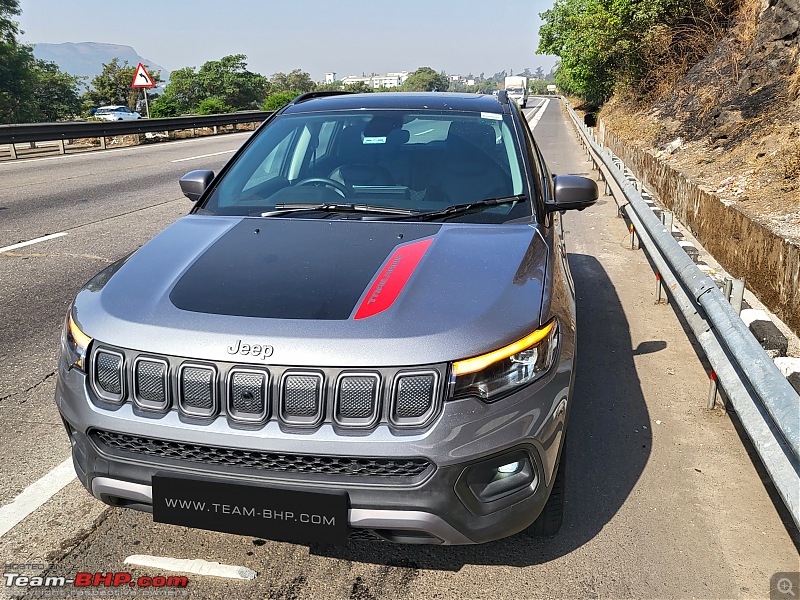 Jeep Compass Diesel AT Review in the City• Sit inside and this feels more like a proper German car than an Italian-American one. With the way the doors shut and that firm seat compound. The Compass feels very sturdy & incredibly solid. • Absolutely love the facelift's new interiors and the cabin does feel good. It looks amazing, very premium. The steering is thick and lovely to hold. The gear lever is like a rock-solid, chunky piece that could just as well have been the lever of a bank vault! • Having no paddle shifters at this price point is a bummer & unpardonable. What you do have behind the steering though, are very neatly placed buttons for the stereo – left side ones change the track, right side ones adjust the volume. Other manufacturers should pick this up. The arrangement is very ergonomically good and there's great attention to detail too. If you long-press the track change button, it rewinds the song being played. • Really sucks that there’s no 12V socket at the front because I needed it for a device of mine. • Quite a small boot for the price, I must say! We were a big group, so we're carrying lots of food supplies etc. The luggage had to be spilt over onto the back seat. There was no way the boot could take it all. • Driving around in the city, on the expressway and around the village roads of Pawna, the Compass made me feel like I'm driving a "mini-tank". The car has a very, very solid feel. • Drive calmly around the city or drive a little spiritedly, say pressing the throttle 60-70% of the way and you’ll find the gearbox to be smooth and fine. No issues at all for regular Ashoks. • Upshifts are executed smoothly & seamlessly. • On the other hand, drive like an enthusiast and many times, you will find the gearbox's response time to be slow. Especially in the lower gears and / or at slow speeds, there were times that I wanted to downshift and it took 1.5 seconds before the gearbox responded to my pedal-to-the-metal command! Is this slow response to kick downs a deal-breaker? No. You’ll live with it, but you’ll never rave about your gearbox’s behaviour as an enthusiast and it won’t “wow” you as a DSG would. More than the gearbox's behaviour though, the real deal-breaker of the Compass is its stiff pricing. The Compass Diesel AT range is Rs 33 - 37 lakhs OTR, Mumbai. • Has Jeep improved the tuning in the latest iteration? Well, the Diesel AT is certainly not dimwitted like the Jaguar XE’s gearbox (which is really one of the most horribly tuned ATs I have driven) or the sluggish Compass Petrol AT, but it’s not a particularly bright or intelligent auto-box either. Again, I'll give the Compass Diesel AT combo a 7 / 10 rating. I found the Seltos Diesel AT tuning to be more intuitive, where it would respond much better and pick the right gear almost all the time. The Seltos Diesel AT – now that’s a brilliantly tuned engine + gearbox combo. Other Diesel ATs that left me with a positive impression are the XUV700, Hexa, Safari, Tucson & C5 Aircross. Jeep Compass Diesel AT Review on the HighwayThis "tank" munches miles like no other on the open road: 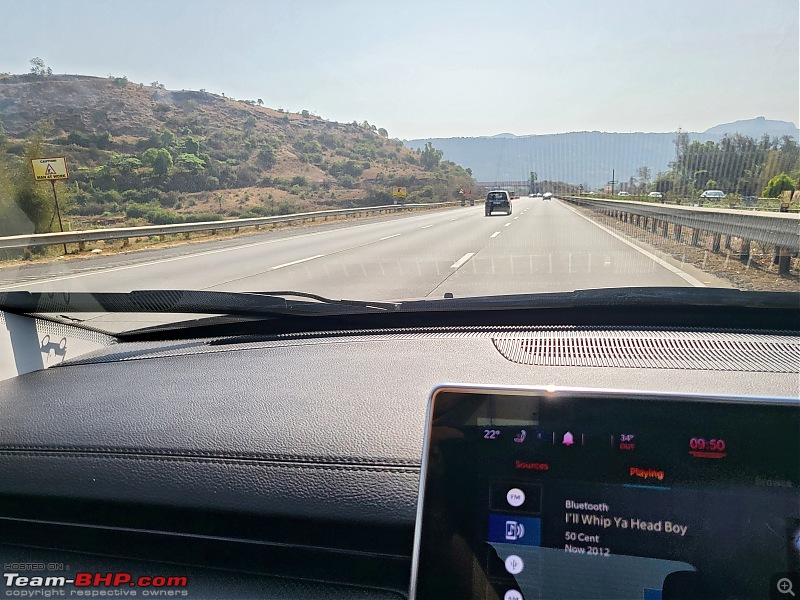 • Not only are there no paddle shifters, but the gearbox doesn’t even have a sport mode. That itself should tell you this AT is not for enthusiasts. It’s more for daily use = for commuting, for convenience, for cruising. • As said in our full Official Review, the Compass has very long legs and is a mind-blowing high-speed mile-muncher. With its excellent stability, smooth gearbox, torquey diesel engine and nice driving position, you can drive this car all day long with a smile plastered on your face. • On the expressway, you’ll find the gearbox’s behaviour to be better. It’s basically under 60 km/h, at lower revs and in tricky low-speed conditions that the gearbox gets more confused. Example? Say you suddenly slow down for a speed bump, and floor it right after. But once you are well above 2,000 rpm, the torquey engine makes the gearbox’s life easier. On the expressway, you won’t find it getting that confused or the response time to be slow. It’s at slower speeds and / or in dense traffic that you find the response time to be lacking. You'll be fine on expressways. • I like Jeep’s 80 km/h warning simply because, with my music volume, there isn’t any  . I didn’t even hear it with my loud music. Other manufacturers, please take note. . I didn’t even hear it with my loud music. Other manufacturers, please take note. • On the open road and for sheer driving pleasure, the Compass Diesel 6-speed MT is more fun and a lot more effortless to drive fast. With the Diesel AT, if you want to drive fast, you have to really wring the neck of the gearbox continuously going into a kick-down mode, or use the AT's manual mode. The Diesel MT is more fun on the open road because its performance is more effortless to access. • The AT can get a bit unpredictable. On occasions, especially at higher speeds, it responds acceptably well to your downshift command. At other times, it doesn’t. In a couple of situations, I also found it to be confused and in the wrong revs. E.g. it didn’t upshift when I was driving easy and would have preferred it to. Again, these are only things that petrolheads like us would notice. The regular Ashok won't have complaints. • Drive smoothly, move with the traffic or even with the throttle at 6/10ths and you are satisfied. No complaints. Start pushing the car with the throttle at 9/10ths and you’ll find the gearbox not downshifting when you want it to and upshifting when you don’t want it to (e.g. mid-corner). • Coming down a fast ghat road, enthusiasts like us will stick to 'manual mode'. It will anyway upshift at the redline in manual mode, so you will use this mode primarily for commanding downshifts as well as holding the current gear. Although, it won't listen to your downshift commands about 1/3rd of the time (the tune is conservative). • You'll enjoy the grip levels & sorted suspension on your favourite mountain roads. The car's behaviour is very confidence-inspiring. • Equally enjoyable is the steering which is fab for an EPS. It's reasonably sharp & has just the right weight at different speeds. • Using manual mode with the gearbox requires a firm hand; it requires effort to move the lever to the left. Drive it and you'll remember my "lever of a vault door" comment. The kind of stuff that the Diesel AT doesn’t do well. On a narrow road stuck behind a truck, you need the AT to instantly downshift to overtake. In such tricky situations, its response time is like 1.5 seconds! What did I do? Use manual mode. Here, one misses "sport" mode which would keep the engine & gearbox on the boil: 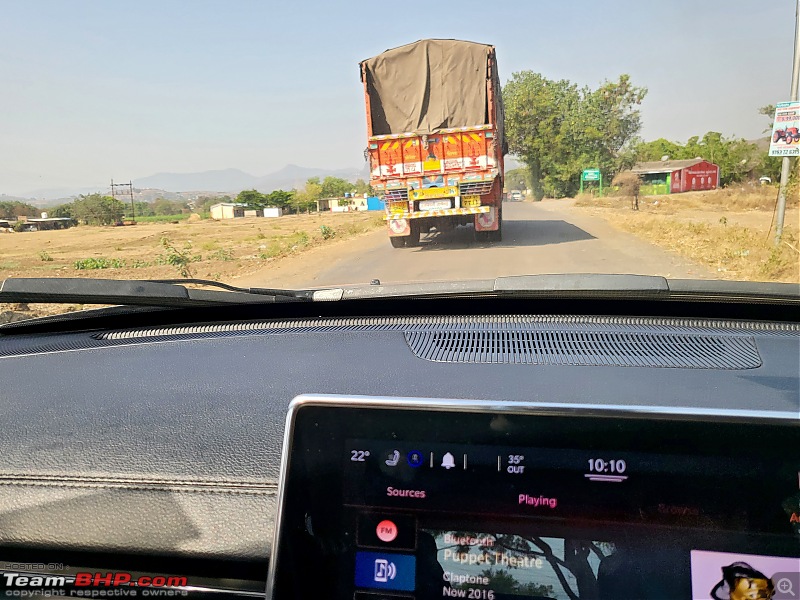 • I found a very peculiar issue with the Compass Diesel AT. If you are driving hard on the open road in full auto mode, the gearbox responds / downshifts best in kick-down mode. That is, the final 10% of the accelerator pedal’s travel range. Meaning, you are continuously in kick-down mode when you want to fly. The problem with doing this is that the accelerator's travel range is long and the pedal is also on the firmer side. After doing this for an hour and a half, my right foot started aching. Solution: drive easy or switch to manual mode. "Sport" mode would've made continuous hard driving easier. • Considering the price point of this car, Jeep needs to make the NVH package more premium. Above 2,000 rpm, you feel mild vibrations on the accelerator pedal. These vibes only increase with the revs. At high revs, they are very noticeable. This is not cool in a car as expensive as the Compass. • This idling start/stop system is going to kill turbos. I needed to take a break, so after hard driving on the ghat (with the engine & turbo steaming hot), I came to a halt and instantly, the engine just switched off!!! I felt so terribly bad for the turbo. • The suspension tune is mature. Again, it has a very German car feel, behaving as if it was built for the AutoBahn. It gives good stability and driving pleasure. On the downside, you feel bad roads, bumps and potholes a lot more. This is not your soft, comfort-oriented suspension. Your family will definitely tell you to go slow on bumps & potholes. • Want to know how she will offroad? Here's Samurai's awesome 4x4 report. Beautiful Pawna is just ~3 hours from crowded Bombay, yet it feels like you're on a different planet altogether! Leave early morning and the drive is very, very enjoyable: 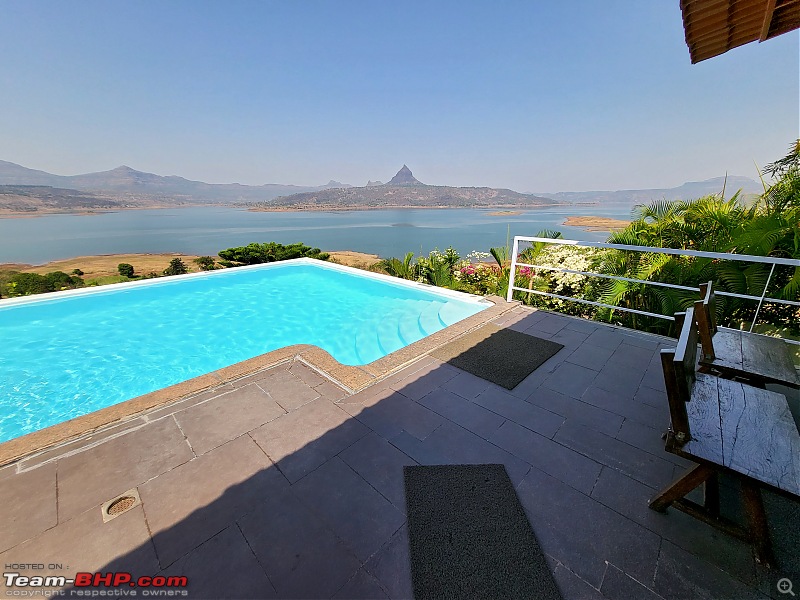 The boot is too small for the price: 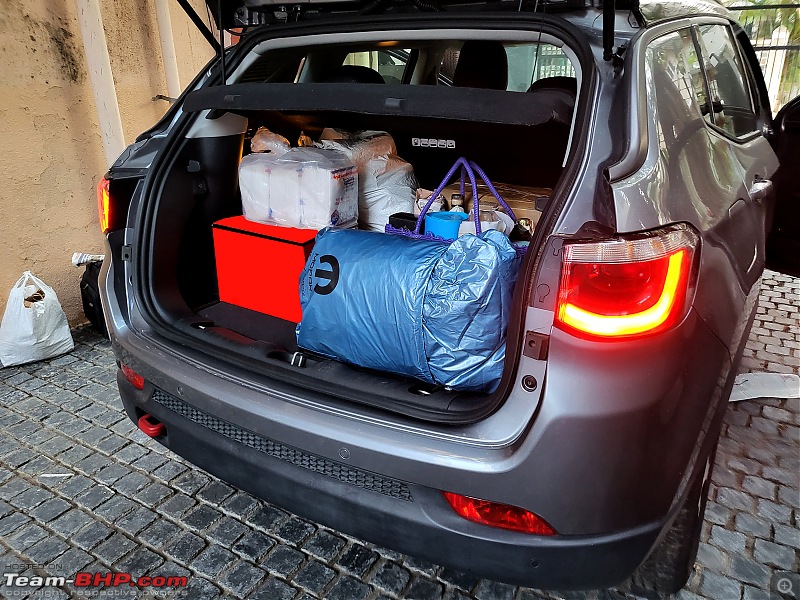 Our weekend luggage spilt over to the backseat: 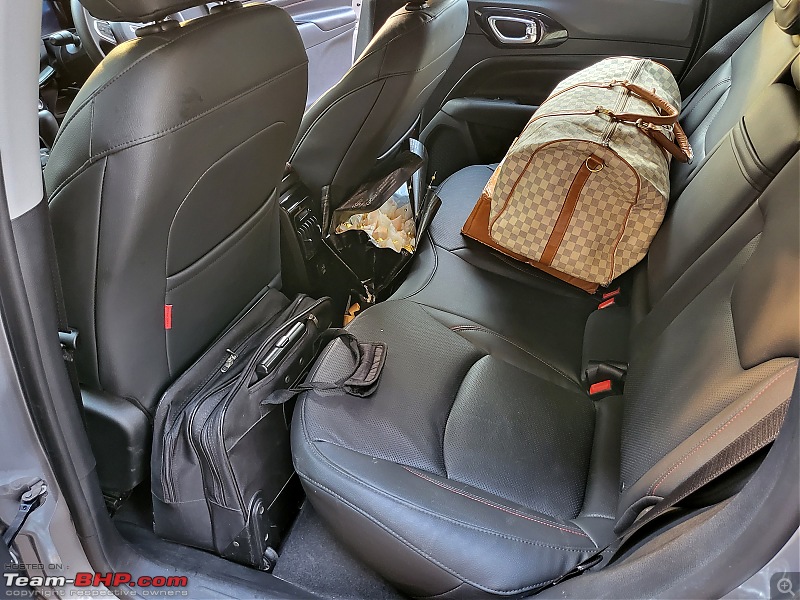 Objects in the rearview mirror are sexier than they appear: 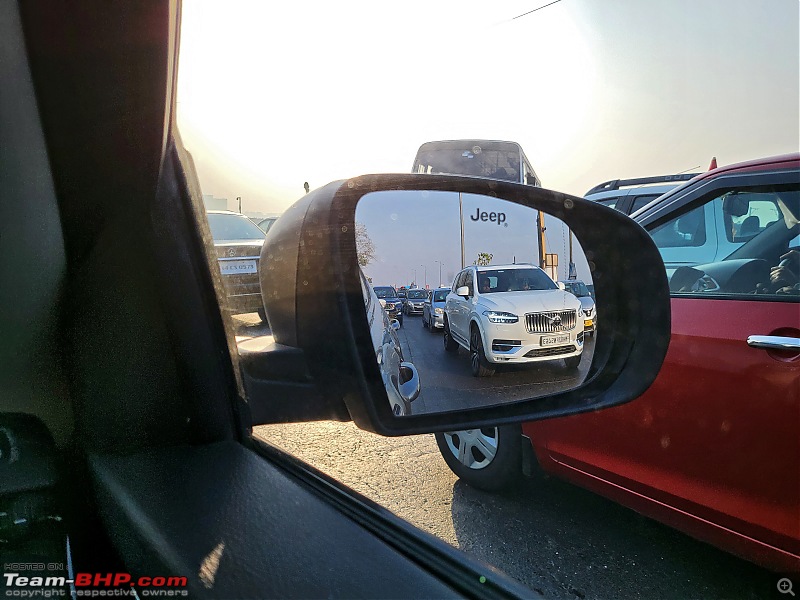 I saw these cars and thought, wow, India sure has some great automobiles on sale now. The Innova Crysta, Carnival, Creta & Vento are all fantastic machines. I also find it ironical that the full-size full-on luxury van in this image (Carnival) starts at a price lower than the small SUV I'm driving: 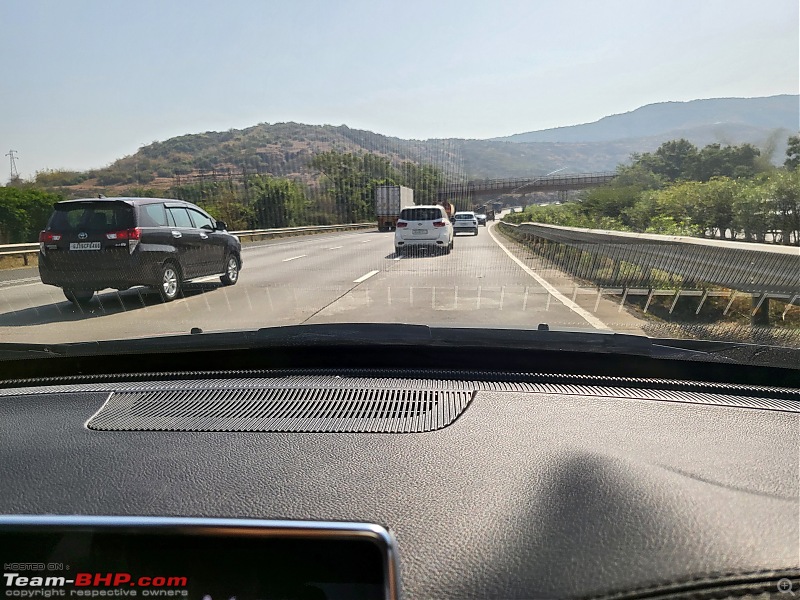 We had a sweet line-up of rides at the Pawna house. W221 is a decade old & my cousin intends to keep it for another handful of years. My philosophy of buying a more expensive car & keeping it for longer infectiously spreads within the family. It's his daily drive & he spends Rs 2 - 3 lakhs every year on the upkeep & maintenance; way cheaper than Rs 2 crores for a new S-Class! The car is still acceptably reliable: 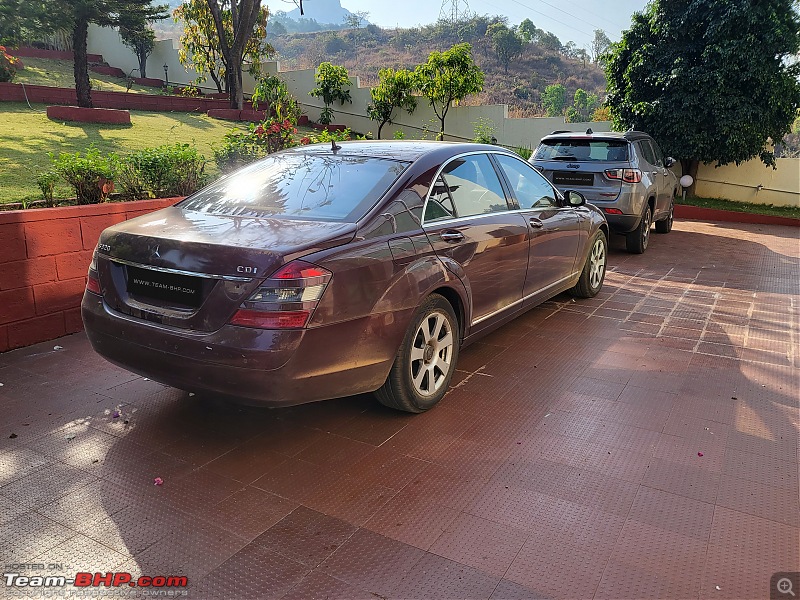 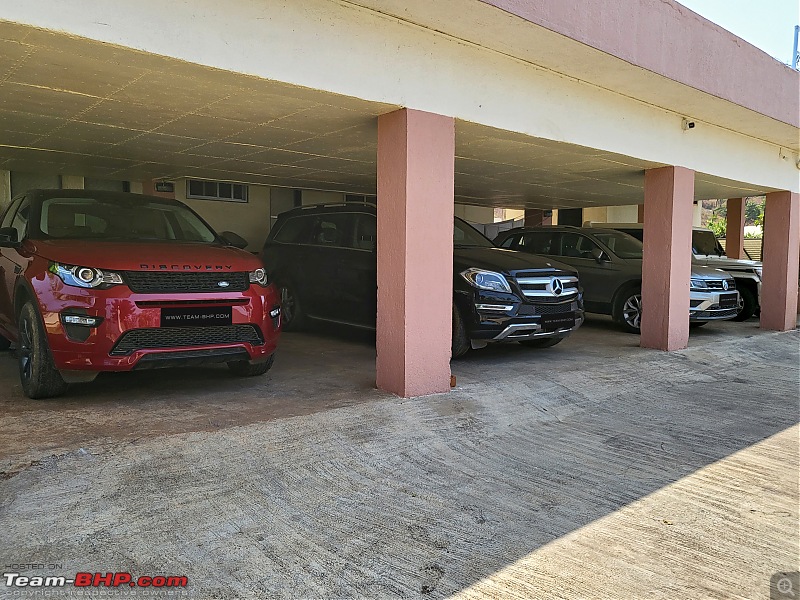 The humble Bolero (proudly belongs to the family that takes care of the Pawna house) might be the cheapest car here, yet it has undeniable character! With that boxy body & black tints, all it needs are alloys with fat tyres to become a head-turner (check out this bad boy): 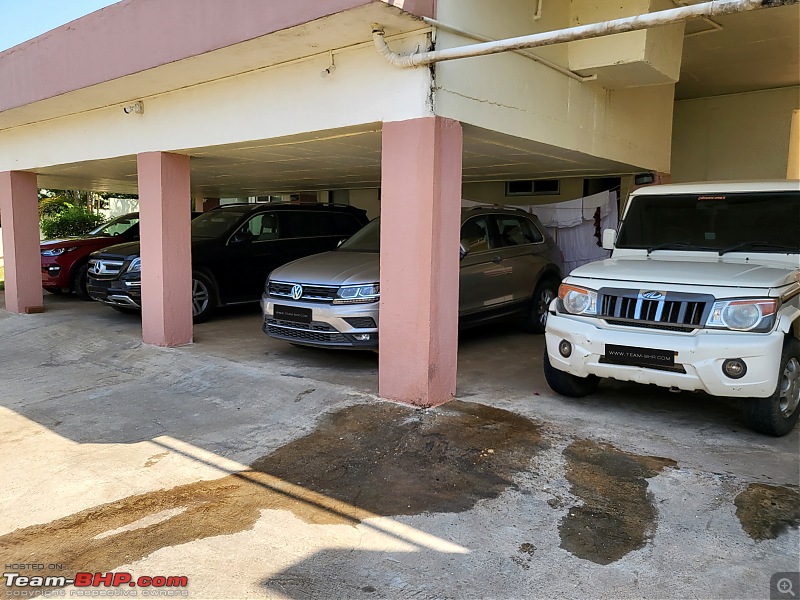 My kid brother's limousine perhaps has the perfect (soft) suspension for this village's broken roads. Road quality has overall improved though. Neither the S-Class nor the Superb scraped anywhere on the way to Pawna. Compare that to the time we went in the 530d: 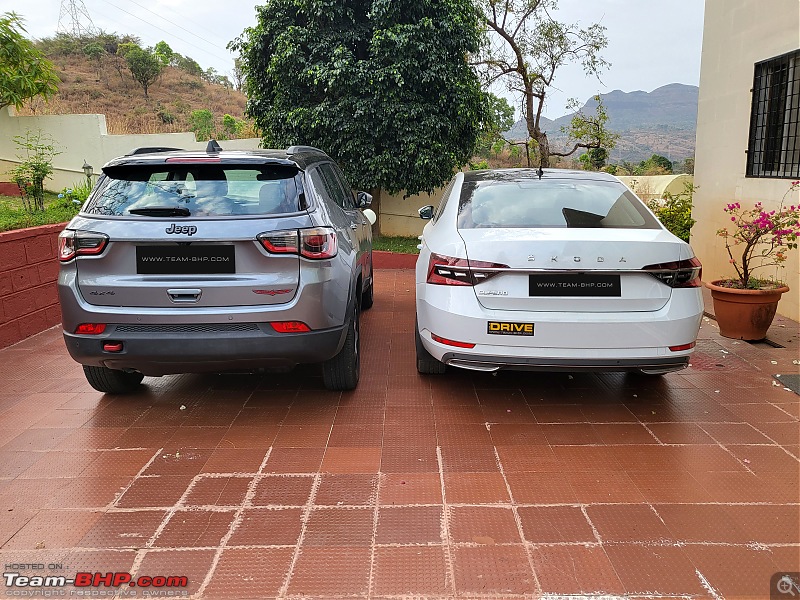 Last edited by Aditya : 25th March 2022 at 08:55. |
| |  (99)
Thanks (99)
Thanks
|
| The following 99 BHPians Thank GTO for this useful post: | AkMar, akshay81, ampere, aniket17, anjan_c2007, Arjun Reddy, arun_josie, arvind71181, AutoIndian, Bibendum90949, BlackPearl, blackwasp, CAPTAIN REX, CarguyNish, carrazy, cbatrody, Chrome6Boy, cool_dube, CrAzY dRiVeR, darklord, deetjohn, DirtyDan, Dr.AD, DrANTO, EmpyreanKnight, Flyer, Gaboonviper04, ganeshb, GKMahajan, GTO, haisaikat, hemanth.anand, igp_79, InControl, Karthik Chandra, kashyapz8055, Keynote, kiren, layndrivr, Leoshashi, libranof1987, lipaul, lovetorque, mallumowgli, man_of_steel, Mighty_Lothar, Moto_Hill, MSAneesh, mustang_shelby, nalinsaxena23, nitinkbhaskar, Nohonking, NPV, Omkar, pankaj_sachdeva, petrolhead_neel, phoenixash, PraNeel, predatorwheelz, procrj, psispace, R2D2, Rajeevraj, ramnaresh_2000, RavenAvi, rednikhil, regenitin, ritzy, rohansachar, rshanker, Rshreyansh, S.MJet, SchumiFan, scopriobharath, sharanvenu, shivkumar19, Simat, skchettry, SmartCat, SnS_12, sridhar-v, SS-Traveller, sunny29584, swiftnfurious, Taha Mir, The Rationalist, theexperthand, theredliner, TSIboy, uday.ere, Varun_HexaGuy, vb-saan, vibbs, Vid6639, Viju, Vik0728, vinodvayyat, vishal.jayakuma, X_T_A Rose |
| | #9 |
| Team-BHP Support  Join Date: Apr 2016 Location: Mumbai
Posts: 2,980
Thanked: 29,620 Times
| Other Points • You can call the Thar a "Jeep", but Mahindra can't. Mahindra lost the rights / license to the Jeep brand-name in the nineties. That's why the CJ340 (CJ = Civilian Jeep) was renamed to CL340 in 1995. • Alongside the Compass, FCA has introduced "Mopar" in India for service & maintenance support. Mopar (stands for Motor Parts) is an 80-year old North American after-sales & customer service brand. In India, it will be handling all of Jeep's service & maintenance requirements, vehicle insurance, annual maintenance packages, battery programs and tyre replacement programs. Yes, Mopar is part of the FCA group, although we're unable to understand why they are bringing in an independent brand / division for service (related thread). Maybe, FCA wants all of its group products (Fiat, Jeep and perhaps Chrysler in the future) to have a single workshop, rather than separate Fiat, Jeep & Chrysler workshops which would individually suffer terribly low volumes? • The 48 FCA-authorized workshops have now been branded as Mopar workshops across the country. In terms of sales outlets, Jeep currently has 50 (check out the Mumbai showroom here). • Good times for dealers who stuck it out with Fiat. After years of negligible sales & losses, they finally have one relevant, expensive product. Fat profits with easy-to-manage volumes. • As usual, the stealerships have begun forcing customers to buy accessories - it's even part of some official price lists (sample)!! Full accessory list has been shared in the post below. Mopar is well-known for a killer range of accessories; we hope to see a wider offering! • One advantage of buying a premium model sold globally is the accessory range you can buy online (examples on AliExpress & Ebay). • Prior to the launch, we'd received a 53-page Compass brochure! If you'd like to read it, go to this post. • The Compass will be manufactured in 50 different trim, powertrain, transmission and colour combinations in India! This is a bit too much & IMHO, Jeep should rationalise things. An area to start would be the 7" touchscreen; we feel it's too small, but the lower variants get an even tinier 5" display! Make the 7" standard. • The Compass will be available in 5 colour options - Silver, Red, Blue (our test car), White and Black. Thanks to BHPians for sharing the linked pictures  ! !• 3 variants on offer - Sport, Longitude and Limited. You further get an "option" sub-trim on the Longitude & Limited which gets you some additional goodies. For 80k, the Longitude Option Pack gets you a lot of extras (including projector headlamps, LED position lamps, 7" HU with Android Auto & Apple CarPlay, dual-zone climate control, roof rails, rear parcel shelf etc.). We think it's worth it. On the other hand, for 70k more, the Limited's Option Pack gets you just a dual-tone roof & HID headlamps. We don't think it's worth it - you can get a top quality black roof from outside for <10k (can do it from showroom too, it's part of the official accessory list). • The Compass is sold with a 3-year / 100,000 km standard warranty + roadside assistance. However, some items are only covered for 2 years. Click here to check out the details shared by Arjit Yadav. • You can extend the warranty by one or two years. We recommend the maximum coverage as internationally, Jeep SUVs are known for niggles & problems. They aren't exactly the last word in reliability. • The first service includes a basic checkup and is scheduled at 5,000 km / 6 months. The second service is at 15,000 km / 1 year. All subsequent services follow 15,000 km / 1 year intervals. • FCA India has invested over US$ 280 million / Rs. 1800 crore in the Compass project. The SUV rolls out with a localization level of 65%. • Want to see the factory? We had a small tour of the Ranjangaon facility where the Jeep Compass is built - (check it out here). This factory will cater to other RHD markets, namely Japan, Australia and UK. The only other countries that the Compass is manufactured in are Brazil, Mexico and China. All of them make the LHD Compass. • The Firestone Destination LE2 tyres had the code MCH 11 17, meaning they were manufactured in the 11th week of 2017 (sometime in March). The Department of Transportation code "DOT W9FC" clarifies that the tyres were produced at the Bridgestone plant @ Pune. • Power windows will function for a little time after you switch off the engine. This gives you bonus time to roll up any windows that were inadvertently left open. Opening the driver's door deactivates the system. In our test car, the rear-left passenger window rolled up noticeably slower than the one on the rear-right. Clearly a quality control issue. • Considering the Compass' hefty kerb weight, we don't expect the petrol to be particularly fuel-efficient. Going by international reviews, we think the 2.0L diesel will be the pick of the two. • Women love the Compass! The feedback was unanimously positive, whichever lady we asked. If you're trying to convince the wife, show her a Compass in person (preferably in red) and the deal will be sealed. • Sitting between the Creta & Tucson, the Jeep Compass has hit the bull's eye. In the Art of War, Sun Tzu said "if your opponent is in superior strength, evade him". That's exactly what companies with limited resources have to do in a market where 70% is controlled by 2 fiercely competitive giants. Smaller / newer companies must look at categories where Maruti & Hyundai have a weak presence and go all out in it. E.g. a newbie cannot sell a Hyundai-like hatchback at a Hyundai-like price - no customer will touch it. You can't sell a Maruti-like sedan at a Maruti-like price. Why was the Renault Duster so successful in its early years? Because it had virtually no competition in that untapped segment. Either that, or offer solid differentiators (e.g. Renault Kwid). • The Easter eggs placed around the Compass are as follows: "Project" - Center armrest storage "M" - Front passenger-side door pocket "P" - Rear left passenger door pocket "1" - Boot's left side cubby hole "5" - Bottom of the tailgate We leave it to BHPians to figure out the meaning of this code (platform code for the 1st-generation Jeep Compass was MK49). • You must have read about all the FCA challenges at the global level, and how Sergio is desperate for a merger. Jeep is the crown jewel of FCA and, Morgan Stanley says, worth more than the entire FCA group!! Related link. • Quote of the month - BHPian jpm posted "I sincerely hope the Compass doesn't turn into a poor politician's Fortuner!"  • Has dynamic steering torque. FCA says "this system is integrated in the ESC and EPS. It adjusts the action of the electric power steering to increase driving safety. Under critical conditions (understeer, oversteer, or differences in grip on braking), the system delivers extra torque to the steering to allow the driver to steer correctly". • Drag Coefficient of the Compass is 0.35. • For a change, here's an ad we agree with. Lots to explore in India, and the Compass is indeed an excellent choice for touring: Disclaimer: Jeep invited Team-BHP for the Compass test-drive. They covered all the travel expenses for this driving event. Last edited by GTO : 27th August 2017 at 13:09. |
| |  (88)
Thanks (88)
Thanks
|
| The following 88 BHPians Thank Omkar for this useful post: | adroit_91, Aficionados, akshay81, ampere, amrutmhatre90, aniket17, Arjun Reddy, arun_josie, arvind71181, AutoIndian, avinash_clt, BlackPearl, blackwasp, CAPTAIN REX, CarguyNish, carrazy, cbatrody, CrAzY dRiVeR, Crazy_cars_guy, damager21, darklord, deetjohn, Divya Sharan, Dr.AD, EmpyreanKnight, fiat_tarun, finneyp, Gaboonviper04, GKMahajan, GTO, heavenlybull, hemanth.anand, icar, igp_79, InControl, Jaggu, Karthik Chandra, kashyapz8055, katoom, Keynote, layndrivr, MSAneesh, mustang_shelby, myavu, Nair.V8, nileshch, nmenon, Nohonking, NPV, pankaj_sachdeva, phoenixash, PraNeel, PrasunBannerjee, predatorwheelz, procrj, R2D2, ramnaresh_2000, RavenAvi, regenitin, Rehaan, ritzy, rohansachar, rshanker, S.MJet, SchumiFan, scopriobharath, sdp1975, sharanvenu, Simat, skchettry, SmartCat, sri2012, supertinu, sups, Taha Mir, Teesh@BHP, The Rationalist, theexperthand, theredliner, timuseravan, uday.ere, vb-saan, vibbs, Vid6639, Viju, Vik0728, X_T_A Rose, yosbert |
| | #10 |
| Team-BHP Support  Join Date: Apr 2016 Location: Mumbai
Posts: 2,980
Thanked: 29,620 Times
| The Smaller yet Significant Things Fiat dealerships have never seen such a crowd - just look at the parking area! Thanks to BHPians Keroo1099 & CrAzY dRiVeR for sharing this pic:  Bi-xenon HIDs provide good illumination with their low beams. The area closer to the car is properly lit up:  High beams are satisfactory, although not exemplary. Also, the road area on the left wasn't as illuminated as the road ahead + on the right side:  Same smartkey as the (Grand Cherokee), but 4 out of 6 slots are blank! No boot release button (cheaper Linea gets it). While the backside of the key looks alright, the front is ugly. Even in terms of quality, it doesn't feel premium at all. You can attach your keychain to the keyfob or skeleton key:  Foglamps double up as cornering lights. They light up in the direction that the steering wheel is turned:  Two reversing lights + rear foglamps in action:  Hexagonal detailing on the upper end of the headlamps. Neat touch - better than leaving it blank:  The tail-lamps of our new test car had already started to fog up (seen on Fiats too). Once again, quality control? Related thread:  Massive IRVM housing looks awful. What's more, it's empty and the plastic is shaky! Some drivers will find it terribly annoying:  India-friendly ORVMs on the Jeep:  Sweet Jeep-branded tyre valve caps. I think these are accessories:  Tyre pressure of 35 front & 32 rear to be maintained. We're intrigued by the 390 kilo max weight rating. 5 hefty Indian adults + luggage could exceed that. Or perhaps, Jeep also agrees that the Compass is a 4 (adult) seater?  In the driver's footwell area, you'll find this nicely placed plastic cover with a 'VIN' stamp on it. VIN can also be seen at the bottom of the windscreen, while the VIN & engine numbers (both) are pasted on the driver's B-pillar:  It's all about the attention to detail. On the ICE, a hexagonal box appears around the bottom icons whenever you press any of them. Next to it is the current selection with a red border (others have a white border):  Some international variants get a central speaker here, we get a blank:  Has the Compass rankled the competition? You bet. See how Mahindra & Tata are taking a dig at the Jeep. Big shoutout to BHPians CrAzY dRiVeR & Anil_neo for sharing:   Lower variants (Sport & Longitude) get a different & funky tail-lamp design:  We received 2 accessory lists from the Mumbai dealer. Sharing both here:   Last edited by GTO : 28th August 2017 at 23:21. |
| |  (77)
Thanks (77)
Thanks
|
| The following 77 BHPians Thank Omkar for this useful post: | aabhimanyu04, Added_flavor, Aficionados, akshay81, amit1agrawal, amit_purohit20, aniket17, Arjun Reddy, arun_josie, AutoIndian, auto_enthusiast, bejoy, BlackPearl, blackwasp, CAPTAIN REX, captmukhi, CarguyNish, carrazy, catchjyoti, CrAzY dRiVeR, damager21, deetjohn, Dr.AD, dZired, EmpyreanKnight, GKMahajan, GTO, gtonsing, hemanth.anand, hok kolorob, igp_79, InControl, Jaggu, Karthik Chandra, kashyapz8055, Keynote, libranof1987, lovetorque, MSAneesh, Nair.V8, Nohonking, NPV, paliontile, pankaj_sachdeva, phoenixash, PraNeel, psispace, RaghuVis, Rajeevraj, RavenAvi, Rehaan, ritzy, rohansachar, rpunwani, rshanker, Rshreyansh, S.MJet, SchumiFan, sharanvenu, shipnil, Simat, skchettry, SmartCat, sooraj.naik, sri2012, SS-Traveller, sumeethaldankar, sunny29584, swiftnfurious, The Rationalist, theexperthand, theredliner, uday.ere, vb-saan, vibbs, X_T_A Rose, yosbert |
| | #11 |
| BHPian Join Date: Sep 2009 Location: Bangalore
Posts: 216
Thanked: 327 Times
| Last edited by GTO : 27th August 2017 at 13:34. Reason: Adding your features comparo to the official review - many thanks for sharing! |
| |  (53)
Thanks (53)
Thanks
|
| The following 53 BHPians Thank PM - B for this useful post: | .anshuman, Added_flavor, Aditya, akshay81, aniket17, arun_josie, avinash_clt, blackwasp, captmukhi, CarguyNish, carrazy, Chrome6Boy, Contrapunto, CrAzY dRiVeR, damager21, deetjohn, dZired, EmpyreanKnight, finneyp, GKMahajan, GTO, hemanth.anand, jaganpec2002, Jaggu, Keynote, layndrivr, libranof1987, mnvvishwa, Mtv, Nair.V8, NPV, Omkar, pankaj_sachdeva, phoenixash, Rajeevraj, RavenAvi, rshanker, S.MJet, sanstorm, sbala, SchumiFan, sharanvenu, Simat, skchettry, SmartCat, sooraj.naik, sparky@home, theexperthand, theredliner, uday.ere, vibbs, Vid6639, Vitalstatistiks |
| |
| | #12 |
| BHPian Join Date: Feb 2013 Location: Mumbai
Posts: 776
Thanked: 2,448 Times
| On a lighter note... Nowadays, whenever I see the latest Skoda TV campaign, I can't control my laughter. Their theme is that the Skoda Octavia offers so much more than an SUV that the owner's friend who bought an SUV recently, came and punched the Skoda sales person. Now, after having seen the pricing of the Jeep Compass, I think Skoda Octavia owners will themselves go to the showroom and hit the sales person for having sold an Octavia to them  . .And the TVC will be: Dude, what happened to you? 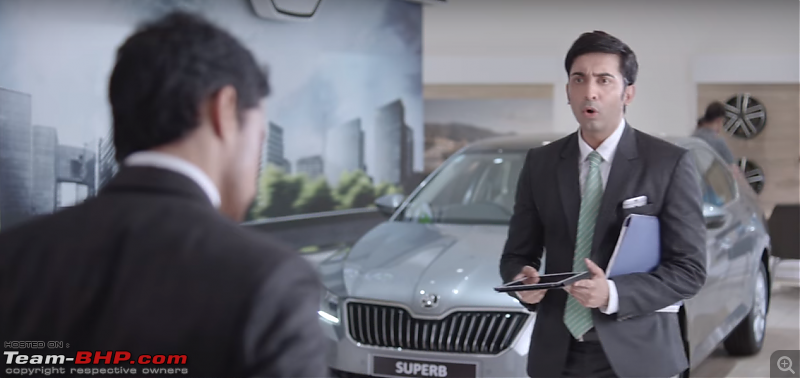 Nothing, Mr. Shah who just bought the new Octavia, came and punched me: 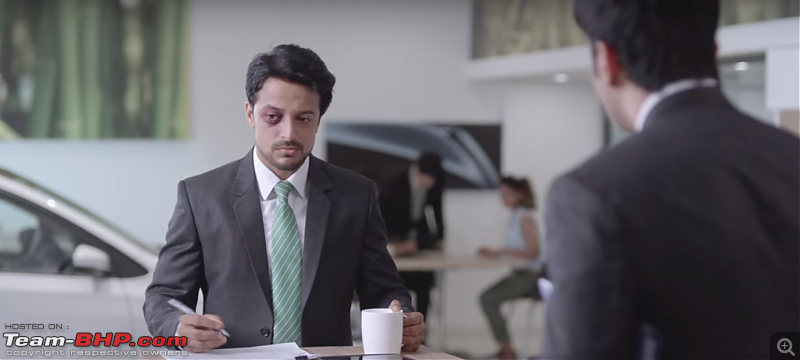 But why? He just bought it:  FCA launched the Jeep Compass in India yesterday:  Jeep Compass - Offers much more than the Skoda Octavia at a lesser price: 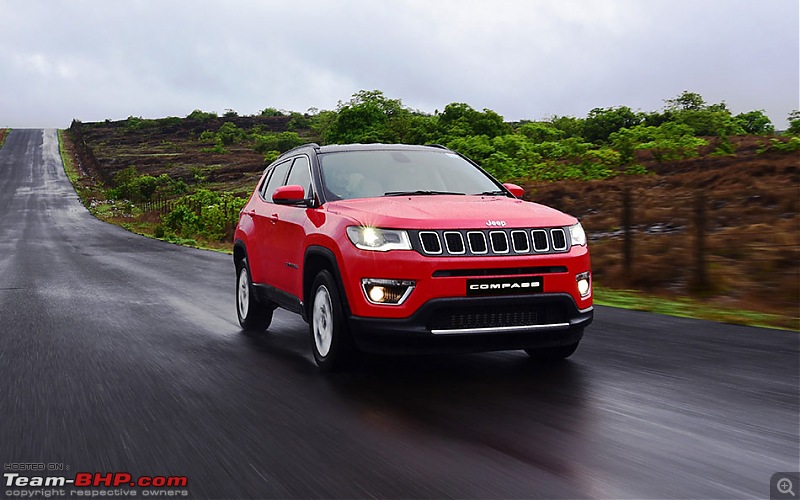 P.S. To be taken on a lighter note. Not a dig at owners of the Octavia or any community. Last edited by GTO : 27th August 2017 at 13:34. Reason: Adding your witty post to the official review :). Many thanks for sharing! |
| |  (83)
Thanks (83)
Thanks
|
| The following 83 BHPians Thank damager21 for this useful post: | 4x4addict, Aficionados, akshay81, aniket17, anshuman1117, AP_1812, aravind.anand, Arjun Reddy, arun_josie, asingh1977, audioholic, Blacklisted, BlackPearl, blackwasp, CAPTAIN REX, captmukhi, CarguyNish, Chrome6Boy, CrAzY dRiVeR, Crazy_cars_guy, desiaztec, djay434, EmpyreanKnight, F2005, GKMahajan, GSMINC, GTO, hdman, hemanth.anand, InControl, Jaggu, JayKis, Keynote, kiren, LoneRidder, lrsays, Mafioso, mnvvishwa, Mtv, mustang_shelby, Myth_sx, nalinsaxena23, NPV, Omkar, OrangeCar, pankaj_sachdeva, phoenixash, predatorwheelz, quickdraw, RAHS, RavenAvi, revvharder, rshanker, S.MJet, saargoga, satishv1987, SchumiFan, shipnil, Simat, skchettry, SmartCat, snaseer, sooraj.naik, sparky@home, sri2012, SSD2122, stringbh, Taha Mir, The Rationalist, theexperthand, theredliner, TorqueTwist, TSIboy, uday.ere, v12, vb-saan, vibbs, Vid6639, Vik0728, vishal.jayakuma, X_T_A Rose, YDS, zalaps |
| | #13 |
| Team-BHP Support  | Re: Jeep Compass : Official Review Thread moved from the Assembly Line to the Official Reviews Section. Thanks for sharing, guys! Rating a full 5 stars. Phenomenal level of detail & coverage on a very special SUV. @ BHPians: Omkar shot a total of 2,700 pictures for his review  . . The Americans sure have the Japanese & Koreans licked when it comes to SUVs / Crossovers. In their respective segments, the EcoSport, Compass & Endeavour are the top picks IMHO. What the Compass has loads of is character. It's hard to explain, but take the Compass for a long drive and you'll know what I'm talking about. In comparison, the Creta & Tucson feel soulless. Not that Hyundai isn't trying hard - the Korean giant now has the designs, engines, features, space, improved road manners & pretty much everything else. Yet, tie it all together and the experience doesn't leave you grinning as a Compass would. They say in the auto industry, "there is no problem that a good car cannot solve" (for the manufacturer). As I'd posted in the Compass' launch thread, we should update that saying to "there is no problem that a good SUV cannot solve"! How did Renault first taste success in India? The Duster. Which Ford is the best selling, despite its age? Which Ford had l-o-n-g waiting periods? The EcoSport. Which other Ford sells impressively for its segment? The Endeavour. What was Mahindra's blockbuster product? The XUV500. Did anyone imagine a 15 - 20 lakh Mahindra ever selling? I can give many more examples. Just look at the attention that the Compass garnered! This is a golden opportunity, FCA India. Don't screw things up & be sure to take excellent care of your 2-million rupee customers. A delivery experience like this one of BHPian Anil_neo doesn't inspire confidence. This is, in fact, the 4th chance that we Indians are giving you (tie-up with PAL was a disaster, the solo run then got you nowhere, the marketing tie-up with Tata ran out of gas, and now you're flying solo again). Work harder, work smarter. I think we'll be seeing a lot of Fiat owners upgrading to the Compass too. It's a logical step up, with a level of familiarity (perhaps the same sales & service advisors too  ). Lots of similar product attributes here, including a solid build. ). Lots of similar product attributes here, including a solid build.Sharing a story from my drive. When I was on the expressway with the Compass, the front-left tyre got punctured. Pulled over safely to the left, put up the warning triangle and got to work (the wheel was jammed). Shortly after, an expressway patrol vehicle stops to give me a hand. Our conversation went like this: He: Which car is this? Imported??? Me (nonchalantly): Jeep Compass He: Oh. Whose Jeep? Me: Huh? He: See my Jeep (points to his Tata Sumo). It's a Tata Jeep. Then there are the Mahindra Jeeps. And the Maruti Jeep which city police use (Gypsy) Me: Speechless 30 seconds later Me: It's the original Jeep. The American Jeep He (visibly annoyed): Yeah, but WHOSE Jeep? Me (giving up): Fiat's Jeep He (victoriously): Ah, pehle kyon nahin bola (why didn't you say so before)?! Last edited by GTO : 27th August 2017 at 15:00. |
| |  (167)
Thanks (167)
Thanks
|
| The following 167 BHPians Thank GTO for this useful post: | .anshuman, 4x4addict, abhishek46, Added_flavor, adneeraj, AGupta, akbaree, AkMar, amit_mechengg, amit_purohit20, amolbh, ampere, amrutmhatre90, aniket17, anshuman1117, arun_josie, arvind71181, asingh1977, bhavik.1991, bj96, BlackPearl, blackwasp, Bubby, CAPTAIN REX, captmukhi, CarCynic, CarguyNish, carhead, carrazy, catchjyoti, cbatrody, CEF_Beasts, Chrome6Boy, cn.vishnu, Coastrider, condor, Contrapunto, CrAzY dRiVeR, Crazy_cars_guy, cruising_rapid, damager21, daretodream, darklord, DicKy, Divya Sharan, DrANTO, dZired, EmpyreanKnight, Ertigiat, fiat_tarun, FiestaST, Gaboonviper04, ganeshb, GKMahajan, glenmz, GSMINC, harry10, hdman, heavenlybull, hemanth.anand, hiren.mistry, hok kolorob, igp_79, InControl, invidious, Jaggu, jetti, jkumar007, Karthik Chandra, kashyapz8055, Keynote, Kols, ksameer1234, Leoshashi, LoneRidder, lrsays, Mahesh Prasad, man_of_steel, moralfibre, Moto_Hill, mrbaddy, mroptimist, Mu009, N33raj, nalinsaxena23, Nohonking, Omkar, pankaj_sachdeva, petrolhead_neel, phoenixash, poised2drive, PrasunBannerjee, procrj, PuntoMania, R2D2, RaghuVis, RAHS, RavenAvi, rednikhil, redracham, Reinhard, Researcher, revvharder, riturajsharma19, ritzy, Rocketscience, Roy.S, rshanker, Rshreyansh, S.MJet, Safari_Beast, sandeepmdas, satishv1987, sbala, SchumiFan, scopriobharath, sdp1975, Sheel, shipnil, shreyak_ss, siddarthab, Simat, Sisu, skchettry, Skyline_GT, SmartCat, snaseer, sooraj.naik, Sophomore, sparky@home, spd_tkt, SR7, SS-Traveller, SSD2122, streetfighter, sub.g84, suhas_raj, sumeethaldankar, supertinu, sups, Surprise, Taha Mir, Teesh@BHP, The Brutailer, The Rationalist, The Riddler, theexperthand, theredliner, Torino, TorqueTwist, turbospooler, uday.ere, v12, vb-saan, Venkat_Figo, vibbs, Vid6639, Viju, Vik0728, vinodvayyat, vishal.jayakuma, vredesbyrd, Wildy, wishnipon, X_T_A Rose, y2ksrs, zalaps |
| | #14 |
| Team-BHP Support  | Re: Jeep Compass : Official Review Thanks for this extremely detailed review. Was long awaited and it is surely worth the wait.  Checked out the vehicle prior to the launch, and loved it! As Renuka Kirpalani of Autocar summed it up in her review - This is one vehicle I would really have liked to purchase myself. Checked out the vehicle prior to the launch, and loved it! As Renuka Kirpalani of Autocar summed it up in her review - This is one vehicle I would really have liked to purchase myself. Hence it is only fair that I start off with the negatives. And its not a small list either -
Now that the main negatives are done with, time to focus on the positives -
Last edited by bblost : 27th August 2017 at 16:16. Reason: as requested |
| |  (45)
Thanks (45)
Thanks
|
| The following 45 BHPians Thank CrAzY dRiVeR for this useful post: | AkMar, anshuman1117, arun_josie, asingh1977, BlackPearl, blackwasp, captmukhi, CarguyNish, daretodream, Eddy, GTO, harry10, harryskt, InControl, Jaggu, Karthik Chandra, Keynote, Kols, moralfibre, mrbaddy, Omkar, pankaj_sachdeva, R2D2, RaghuVis, Rajeevraj, RavenAvi, rbp, Reinhard, rshanker, S.MJet, sdp1975, shipnil, Simat, skchettry, SmartCat, snaseer, streetfighter, supertinu, sups, The Rationalist, theexperthand, theredliner, Torino, vb-saan, vijay_rodie |
| | #15 |
| Distinguished - BHPian  | Re: Jeep Compass : Official Review So its finally here. Just took delivery of my LTD 4x2 in Silver today. Have driven it around 30 Kms so far in Gurgaon and loving it. The timing coincides with the release of the official review! |
| |  (30)
Thanks (30)
Thanks
|
| The following 30 BHPians Thank Behemoth for this useful post: | arun_josie, asingh1977, Baddychat, captmukhi, CarguyNish, cbatrody, CrAzY dRiVeR, GTO, harry10, InControl, Karthik Chandra, myavu, nair, Nohonking, Omkar, Rajeevraj, RavenAvi, rshanker, S.MJet, Safari_Beast, sandygordon, sdp1975, Simat, sourabhzen, The Rationalist, theredliner, TSIboy, Udit, vb-saan, vinodvayyat |
 |



